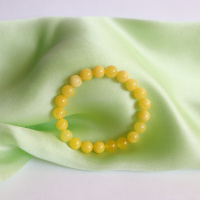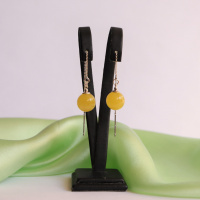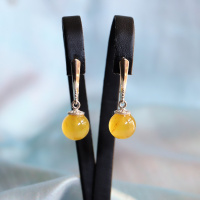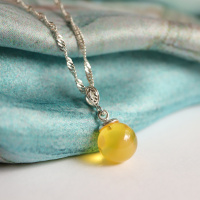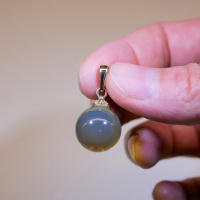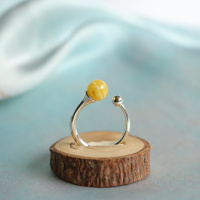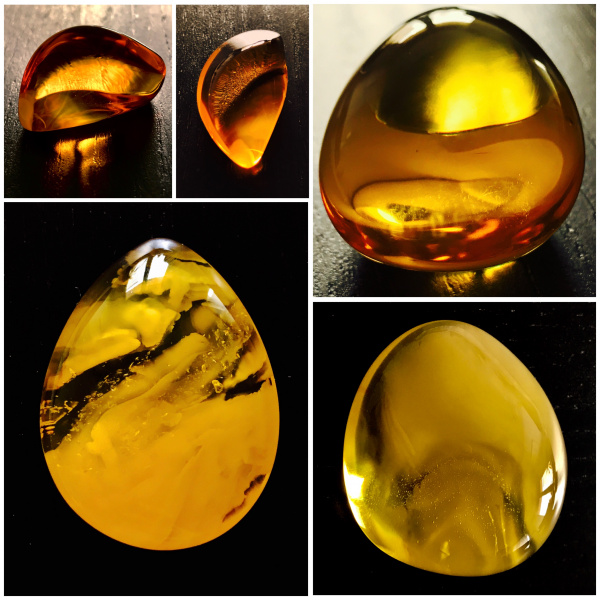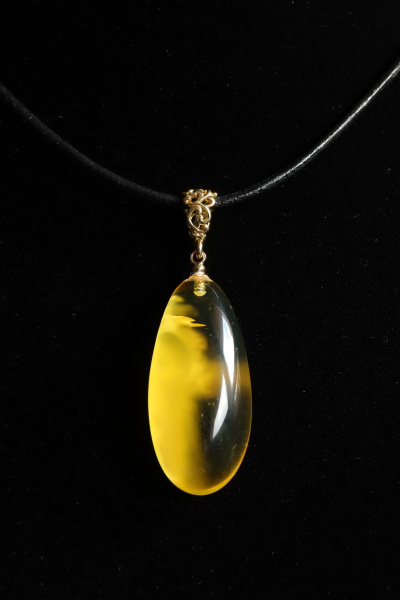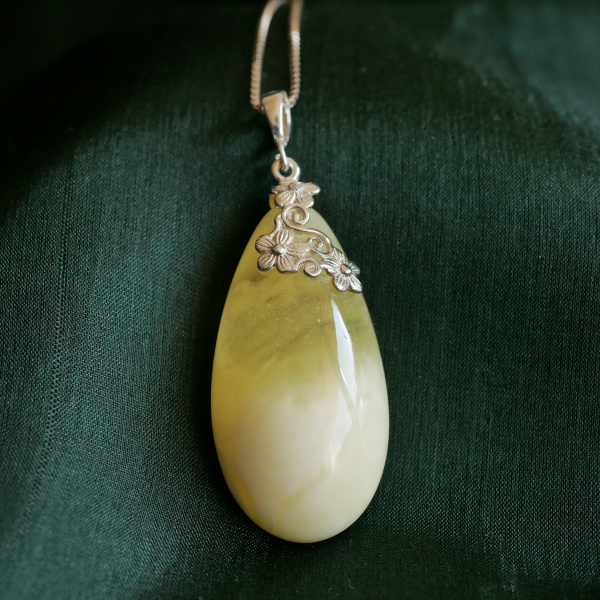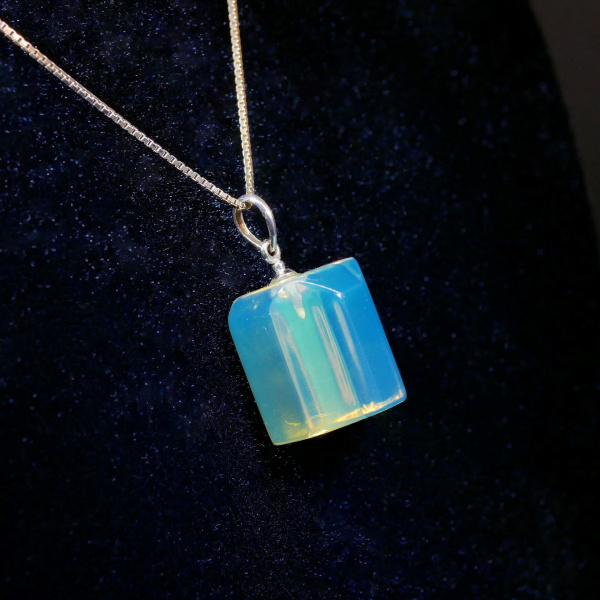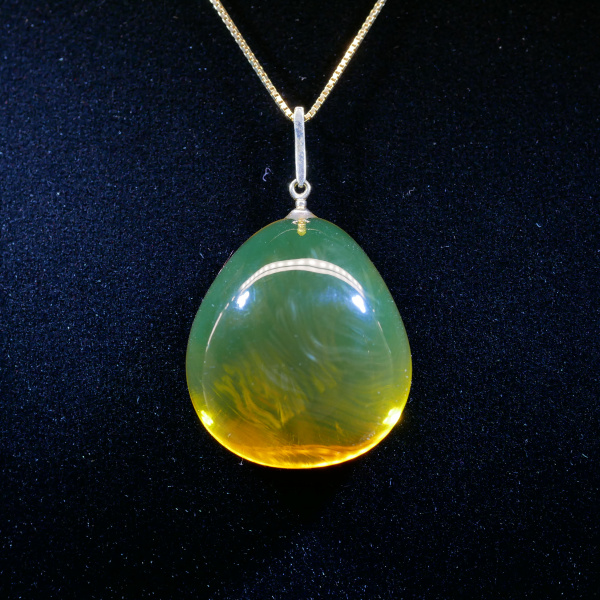Blog
Amber is not just a gemstone favoured for its unmistakable appearance, and its beauty is not its only attribute . This mysterious messenger from prehistoric times has accompanied mankind since the very beginning of civilizations. There are a variety of stories, legends and beliefs behind its powers. Let us draw you into its colourful and rich world through our blog.
List of articles
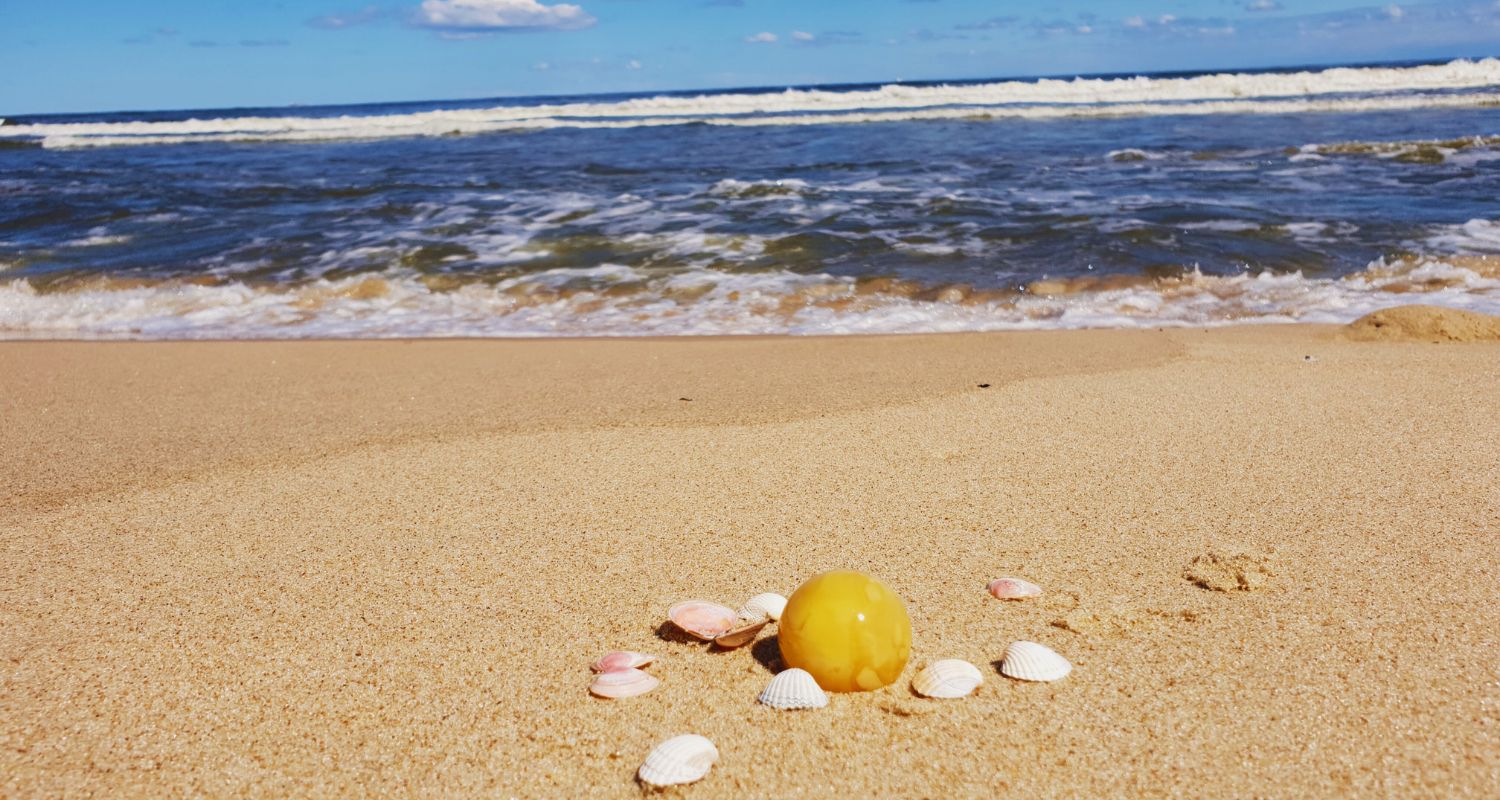
Amber, a gemstone formed from fossilized tree resin, holds historical, mythological, and cultural significance. Throughout the ages, it has symbolized light, protection, spirituality, and nature. This article explores various legends and symbolic meanings of amber across different cultures and eras.
The Ancient World: Amber as the Tears of the Gods
The ancient Greeks referred to amber as 'electron' due to its ability to attract small objects when rubbed. The Romans believed it possessed magical and healing properties. Pliny the Elder, in his encyclopaedia 'Natural History', dedicated an entire chapter to amber, where he also mentioned the ancient Greek legend of Faëthon, son of the god Helios.
Faëthon's Tale
According to legend, Faëthon, son of Helios, attempted to drive his father's sun chariot but lost control, bringing it too close to the earth and scorching it. Zeus punished him by striking him with lightning, causing Faëthon to fall into the river Eridanos and drown. His sisters, the Heliades, turned into poplars by the river, and their tears became amber, named "electron" after the Greek word for sun. This story was noted by many ancient poets.
The Perception of Amber in Roman Culture
Amber was given a somewhat less divine origin by the ancient Romans, who referred to it as "lyncurium" (also known as lyngurium or ligurium), meaning "lynx urine". They believed that this golden-coloured gem was formed from the fossilised urine of lynxes, with the highest quality - clear amber - being attributed to the fossilised urine of male lynxes. However, Pliny the Elder, in his encyclopaedia, correctly identified the true origin of amber as the resin of prehistoric trees.
Baltics: Amber Palace and Perkūnas' Wrath
Among the various types of amber discovered throughout the world, Baltic amber is renowned for its prominence. According to Baltic mythology, amber is regarded as the tears of the goddess Jūratė, the daughter of the thunder god Perkūnas.
Jūratė, a beautiful sea goddess, lived in her underwater palace, and protected all creatures in her kingdom. Despite warnings, a young fisherman named Kastytis fished in her realm. When Jūratė confronted him, they instantly fell in love with each other and Jūratė led her lover to her amber palace.
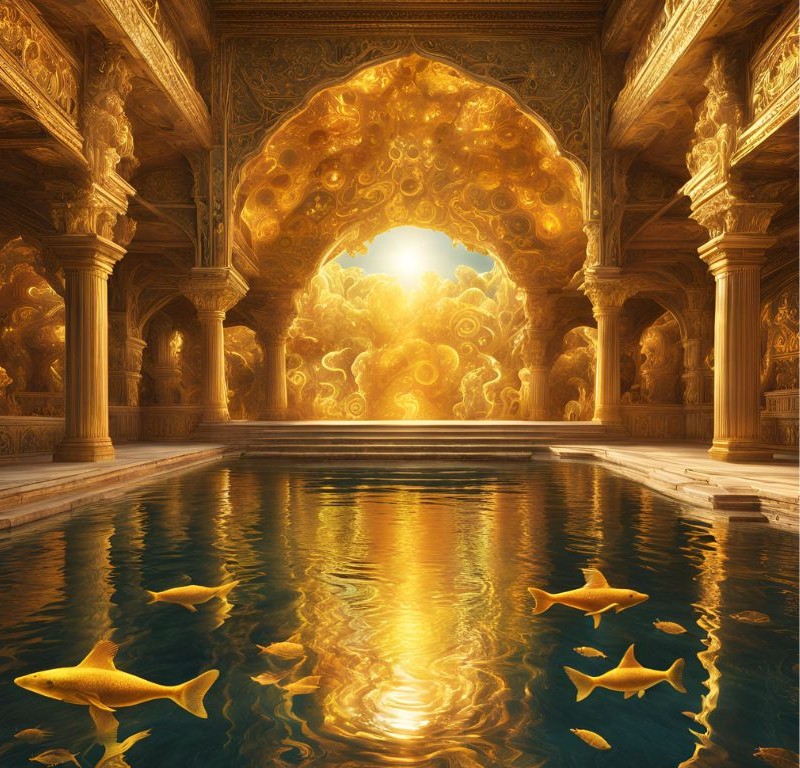
When her father heard about it, he was very angry. He sent thunder and lightning on the young couple. Kastytis died as a result of his wrath, and the amber palace was shattered into small pieces. Jurate remained trapped in the ruins of her underwater dwelling. Here she laments for Kastytis and their unfortunate love. Her lament causes the calm depths of the sea to ripple and churn, washing the remains of the ruined amber palace ashore. Among these pieces, amber fragments known as Jurate's tears wash up, symbolizing their tragic love.
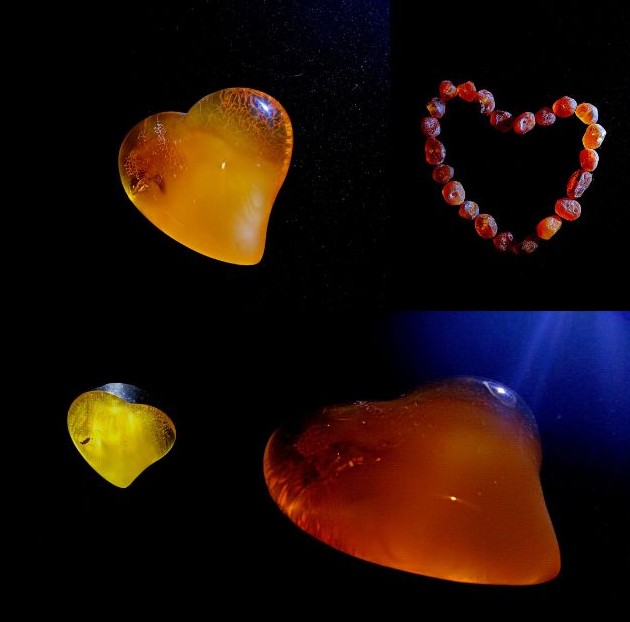
Northern Europe: The Sun in Stone
Nordic people, like the Vikings, regarded amber as a sunstone formed from the sunset rays, embodying the energy of sunlight and life. They used amber in rituals and wore it as amulets for protection against dark forces.
These people linked amber to Freya, the goddess of love, fertility, beauty, war, death, gold, and magic. Freyja's Brisingamen necklace symbolizes fertility and protection. The name likely refers to "fire" or "amber" and a precious metal, though its origin is unclear.
Legend says, Freya's husband travelled often, and her tears turned to gold and amber when they hit the ground.
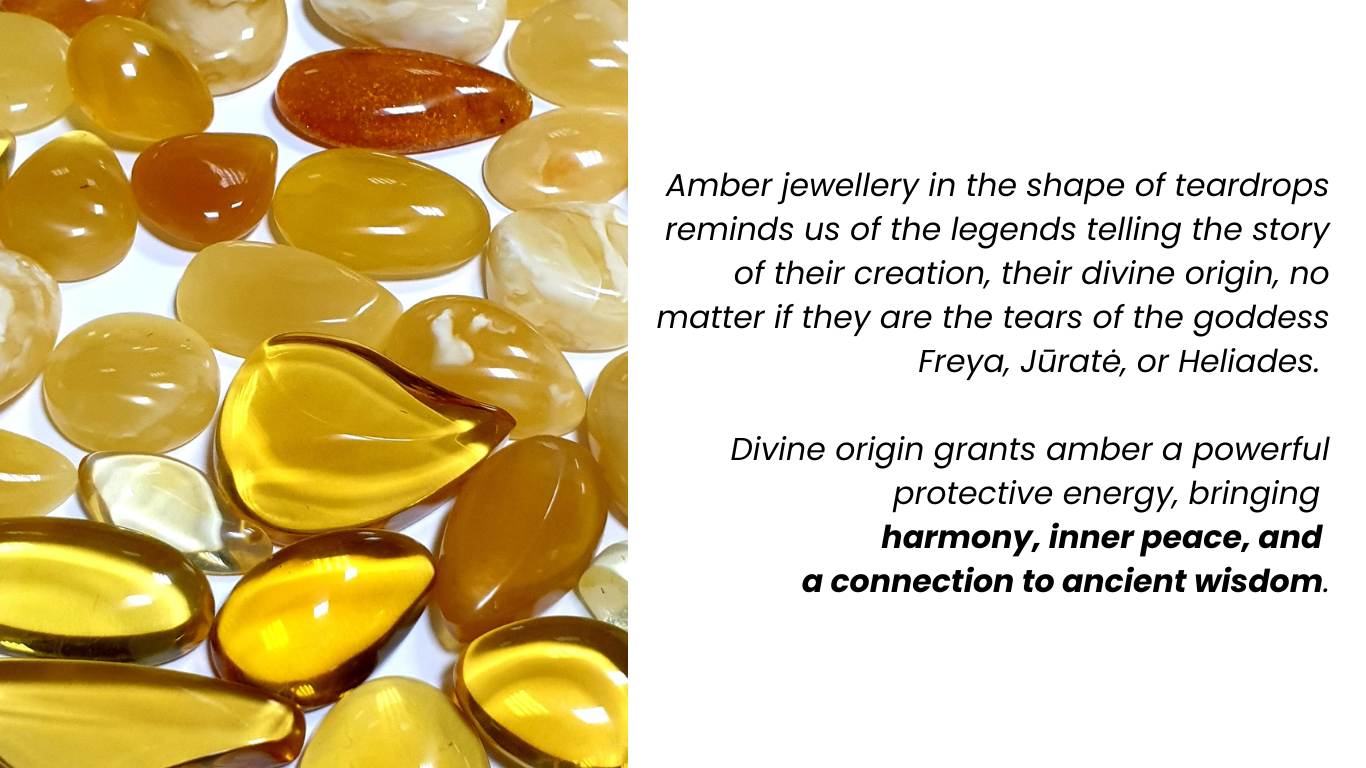
China and East Asia: The Soul of the Tiger
In ancient China, amber was known as the "soul of the tiger". Why is amber associated with this beast?
Legend has it that once upon a time, there was a hunter in the northeastern part of China. He was desperate to hunt a tiger. Demons terrorized his village, tormenting the poor villagers. They believed that only those who wear tiger fur and claws can defeat the demons.
In Chinese culture, the tiger is a beast with strong yang energy. It is the king of animals and feeds on evil demons. According to another legend, the mythical Shentu and Yulei would catch demons and spirits that harmed humans around the empire, tied them up under the peach tree on Mount Dushuo and feed them to the tigers. However, ordinary mortals don't have the miraculous powers of Shentu and Yulei. They can only face demons when they wear tiger skin and claws.

For this reason, hunter went into the mountains to hunt a tiger. He followed the tracks of a beast until he noticed that a huge tiger was following him. With one eye shining and the other seeing strange things, the beast was unpredictable, appearing and disappearing like the wind. After a month of tracking without success, the hunter saw nothing more of the tiger than its strange eyes. Suddenly, an old, white-bearded man appeared in front of him.
The hunter bowed and shared with him the concerns of the villagers. He also mentioned his unsuccessful attempts to hunt the tiger for its skin and claws, noting that the tiger had unusual eyes. The old man smiled at the hunter and said that he had come to help the hunter and the poor villagers.
The old man explained that the tiger's essence, cultivated for a century, lies in its shining eye. He then shared advice on how to conquer the tiger. The hunter followed the old man's guidance and successfully hunted the tiger.
After the moon set, he dug where the tiger's head lay until he found a gem glowing with a strange light. The gem was warm to the touch, hiding the essence of the king of beasts. The hunter hung this strange stone around his neck, tied the tiger's claws to his belt, and draped its skin over his shoulders. Then he rushed to the village to free the villagers from their demons.
At night, demons attacked the terrified villagers. The hunter stood up to them, and as the demons lunged at him, a bright glow emitted from the stone. The power of the tiger spirit turned the demons into smoke.
The hunter eliminated all the demons and ended the village's long suffering. Since then, people in the Far East have used amber as a talisman for protection against the dark forces and for attracting good luck.
Nowadays, amber is valued not only for its beauty, but also for its healing properties. It is associated with peace, harmony and protection. Amber is more than just a gemstone; it is a story told by the ancient nature, capturing millions of years of history. Whether it is perceived as divine tears, the soul of a tiger or the gift of the sea, its symbolism transcends time and cultures. Amber teaches us to look for the light in the darkness.
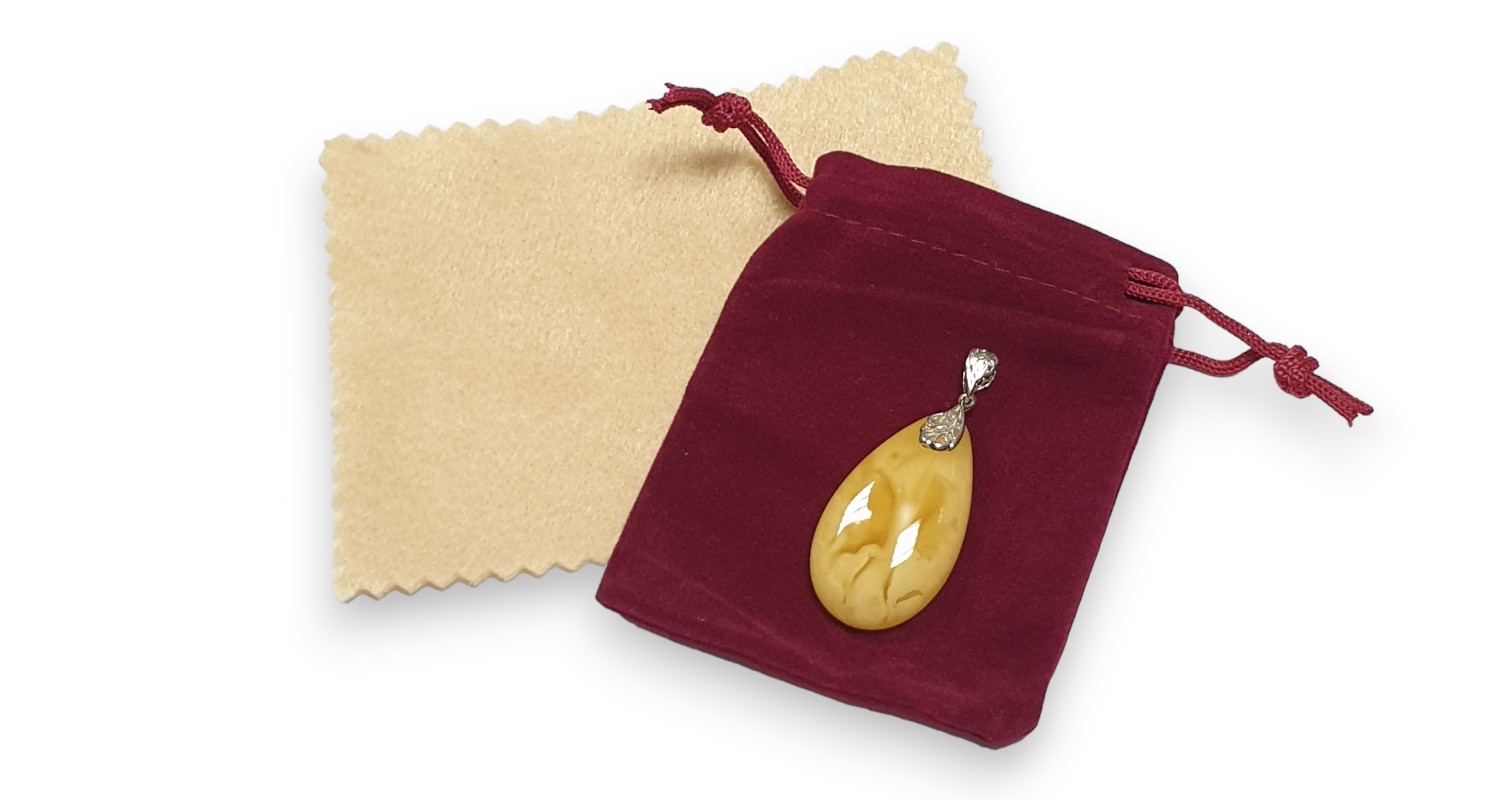
When you take care of amber jewelery it’s always good to keep in mind its origins as petrified tree sap. It’s not a mineral stone. Amber is relatively brittle and it’s important to protect it against fast oxidization and contact with chemicals. Amber oxidizes naturally and its color deepens over time. When this process is artificially sped up, it causes degradation of quality. Amber is quite soft, only around 2.5-3 on the Mohs scale of hardness, and can easily be scratched or damaged.
If you follow a few simple instructions, your jewelery will stay as beautiful as the day you bought it.
Clean it regularly
The best way to clean it is with a 100% cotton cloth, either dry or gently moistened with room temperature water. We love using classic denim fabric for this. If necessary you can also use a bit of mild soap as well but make sure to rinse the amber well before you store it. In the end polish it dry with a cotton cloth. Avoid microfiber or any synthetic fiber cloths as they can easily scratch the stone. Also stay away from ultrasonic jewellery cleaners, steam machines and all chemical substances.
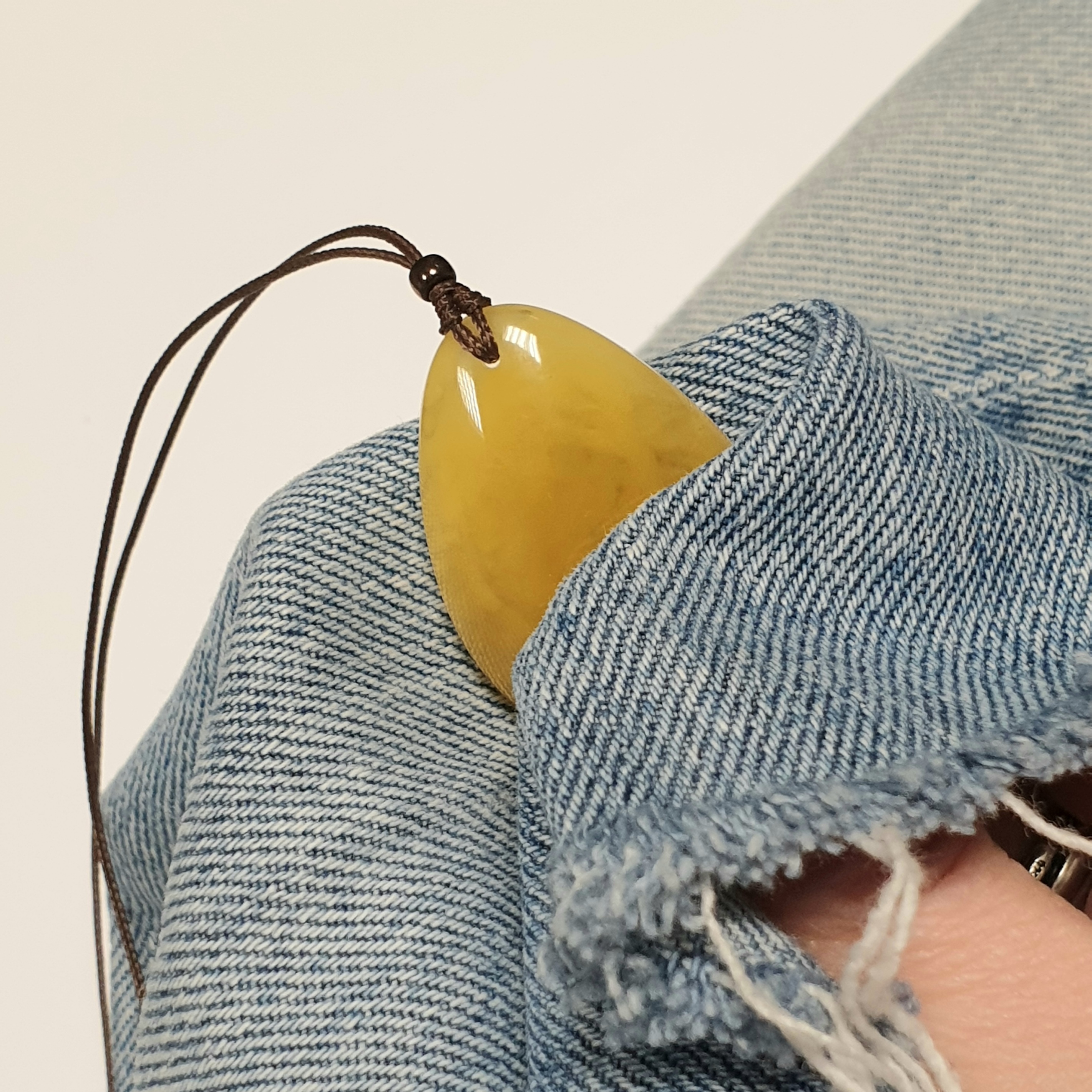
Keep your jewellery safely stored
Ideally keep each piece in its own cotton or velvet pouch. This will protect the amber from excessive oxidization caused by humidity and sunrays. We also recommend storing your amber separately from your other jewelry, particularly metal pieces, to avoid scratches on the fragile stones.
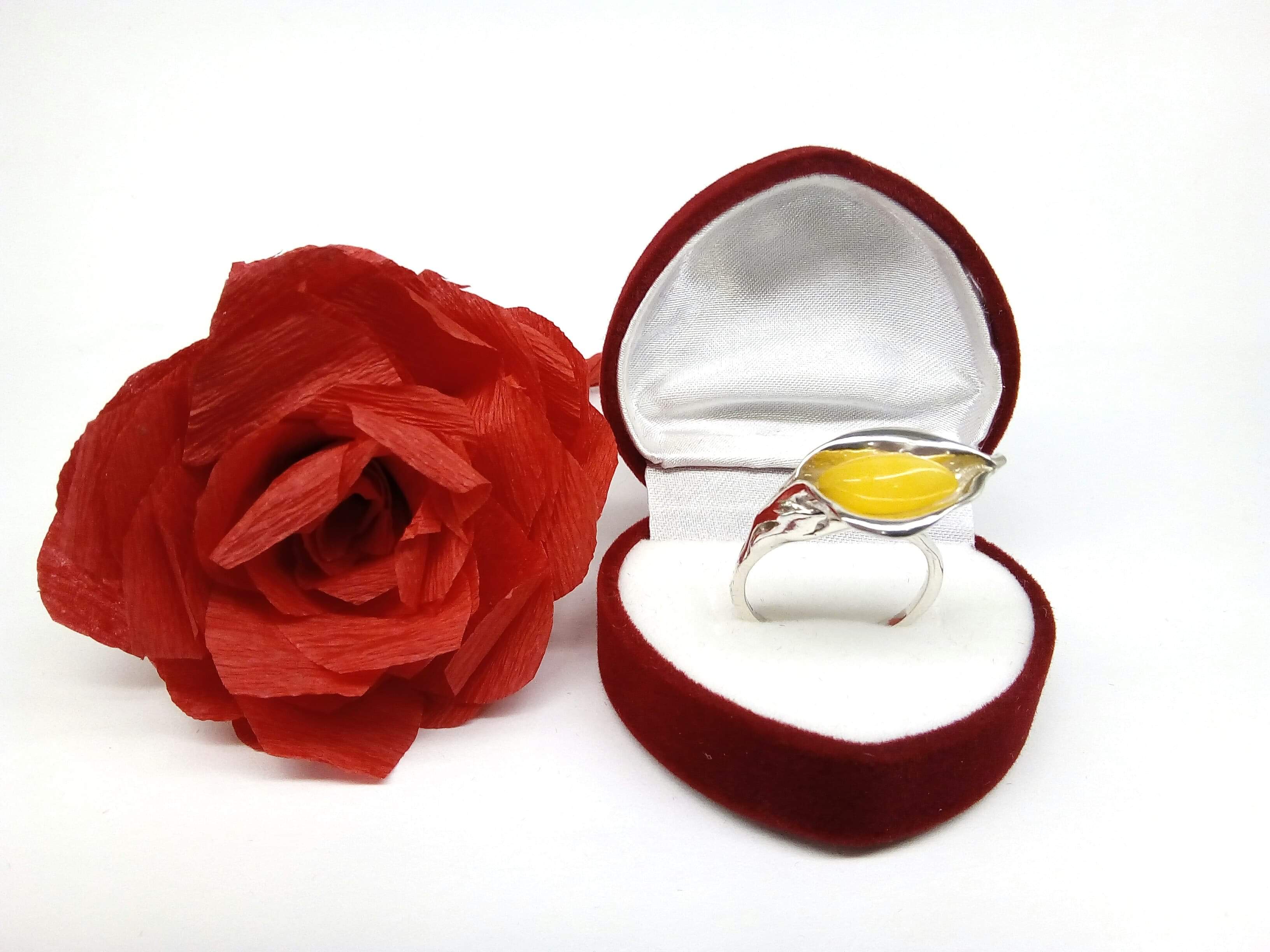
Keep it away from direct sunlight and heat
Think about this mostly when you plan to sunbathe or when going into a hot tub or sauna. Very cold or freezing water is also bad for amber. The worst is thermal shock, or a rapid change in temperature, which can completely destroy the stone.
Be sure to keep perfume and hairspray away from your jewellery
When amber gets into contact with perfumes, hairspray or other chemicals, a whitish coating may form on the surface which is difficult to remove and you risk irreversible surface damage. In this case, the jewellery would have to be re-sanded and re-polished.
Amber is generally sensitive to chemicals, do not wear your jewellery in swimming pools with chlorinated water, or when you are doing any work where chemicals may affect the amber.
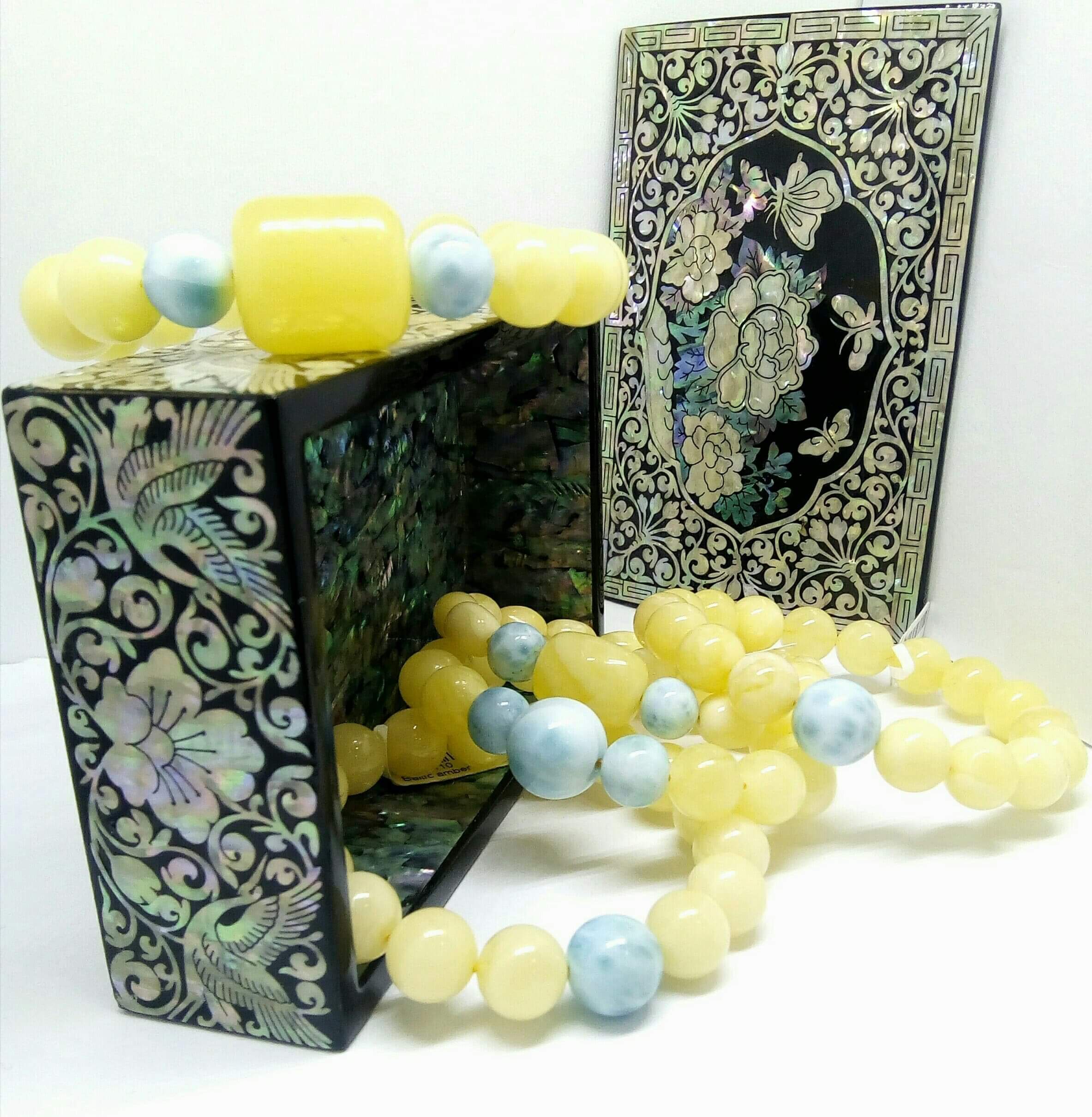
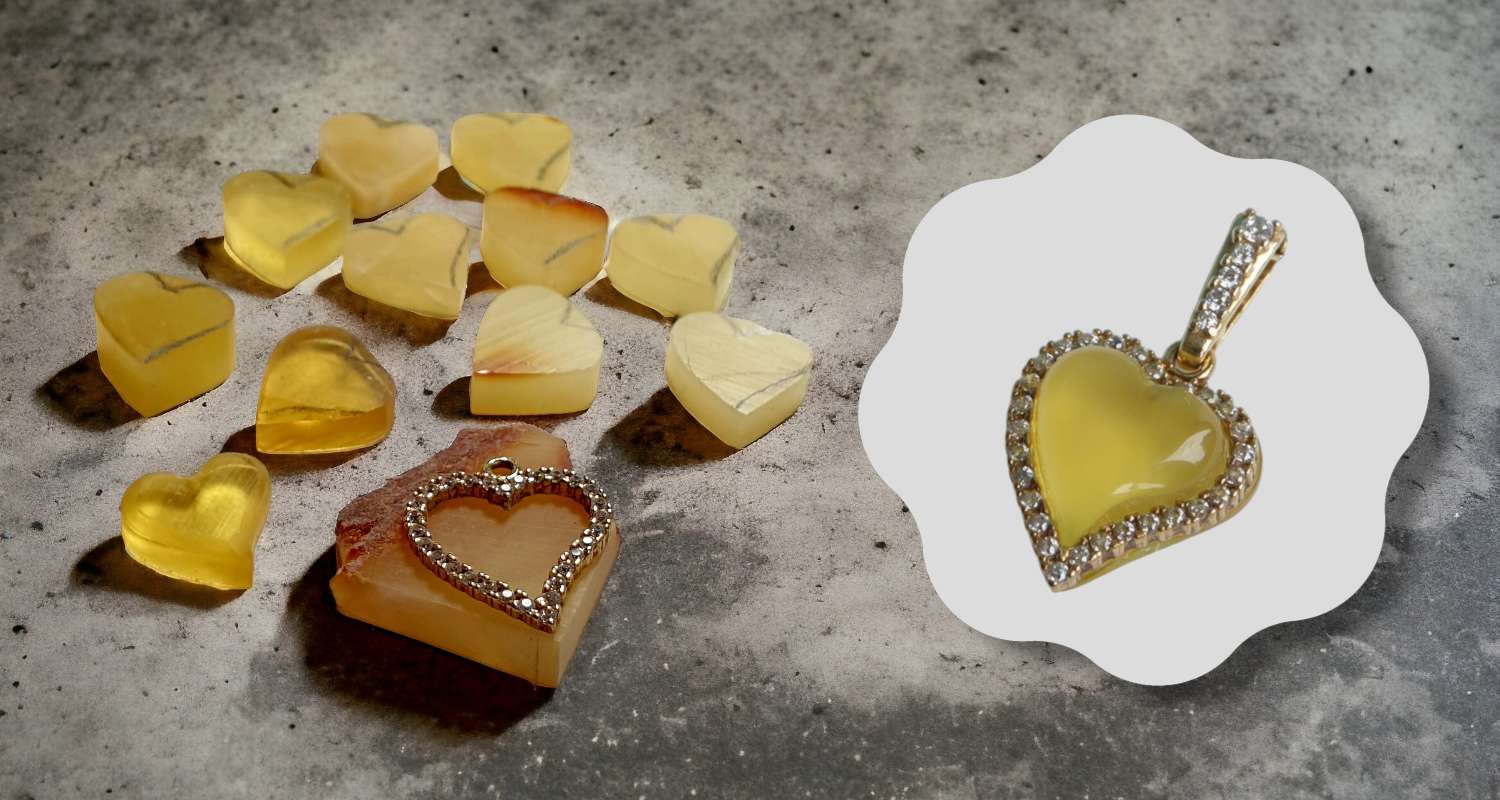
The magical transformation of a "stone" into a heart
An ancient Baltic legend tells the story of love between the beautiful Jurate, daughter of the God of thunder, and the fisherman Kastytis, who lived on the shores of the Baltic Sea. Kastytis cast his nets in waters where it was forbidden to fish. Jurate sent her messengers to tell him not to do so, but Kastytis paid no attention to their words and continued to fish. Jurate had no choice but to persuade him in person. However, the moment they met, they fell in love. Jurate took her beloved to her underwater amber palace so they can be together. Her father, however, was very angered by his daughter’s choice, and in his anger he struck the amber palace with lightning. Kastytis died, and Jurate was forever trapped in the ruins of her underwater palace.
Every once in a while, the Baltic Sea washes up the fragments of the Amber Palace ashore. Many of these fragments are shaped like tears. People believe they are the tears of the beautiful Jurate, who is mourning her lost lover. These tears are the manifestation of her eternal love.
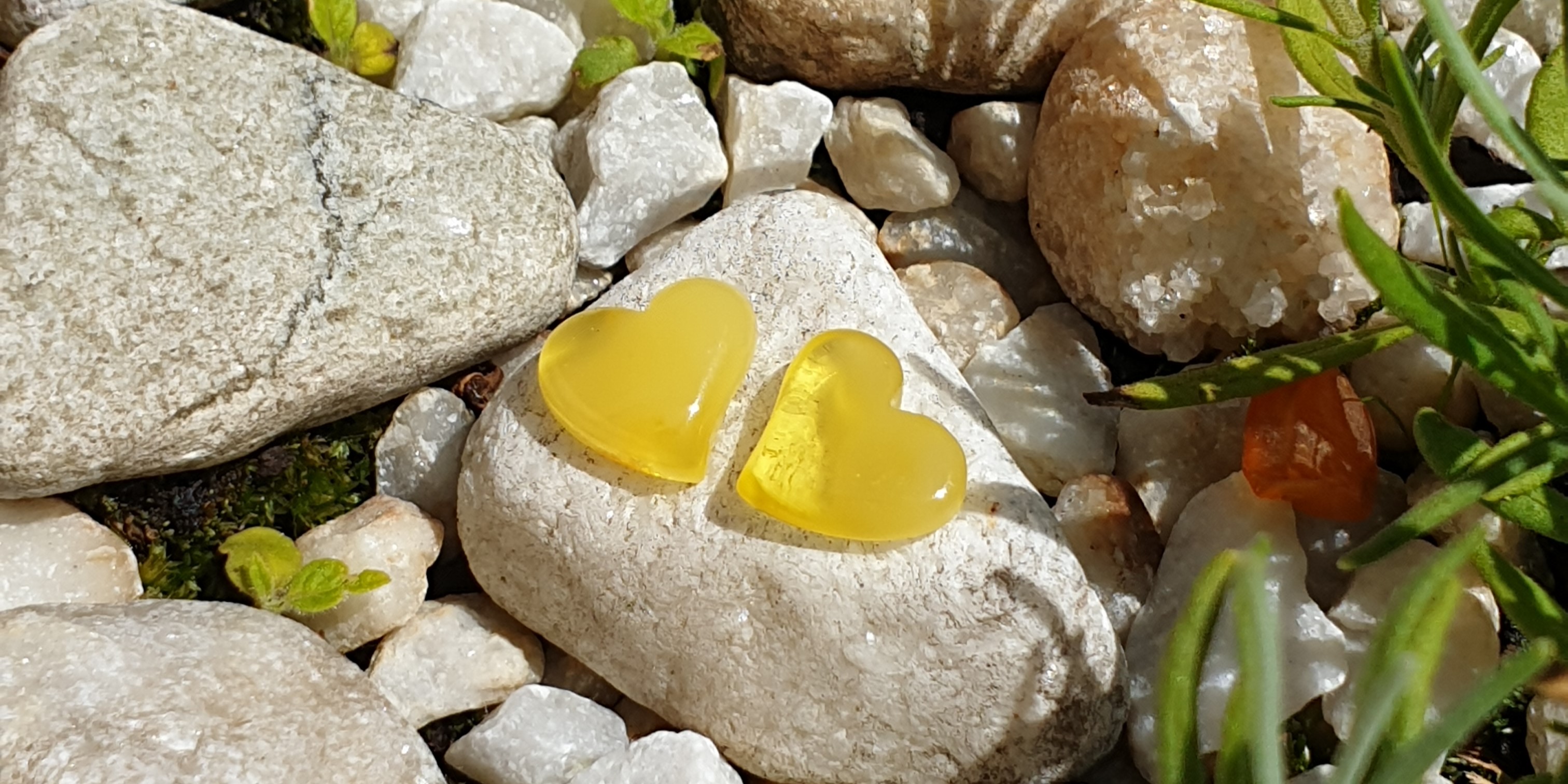
Legends of amber often tell stories of love. It is therefore not surprising that this gemstone is associated with expressions of tenderness and affection. Heart-shaped amber jewellery symbolises devotion and love. Thus, an amber heart pendant is not just a an ornament.
It is also a means of expressing the depth of your feelings to your loved one without words.
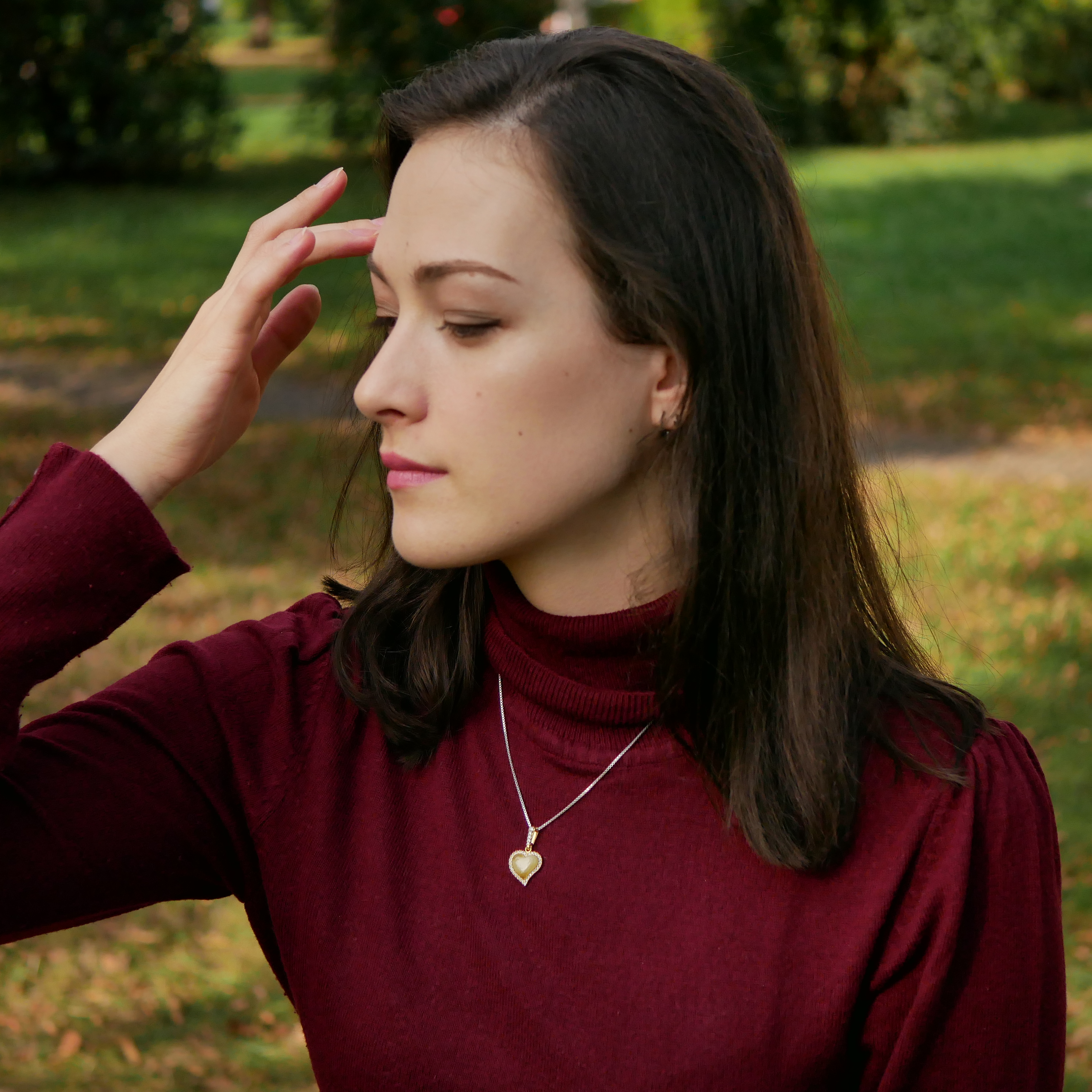
How do we craft amber hearts?
Amber hearts are a very popular motif in amber jewellery. Take a look at our work to see how a bulky "stone" is transformed into a jewel of graceful curves.
A piece of jewellery given from pure heart must be created from a pure gemstone. That is why we pay great attention to the selection of the raw amber itself. Amber must not contain any cracks or other blemishes.
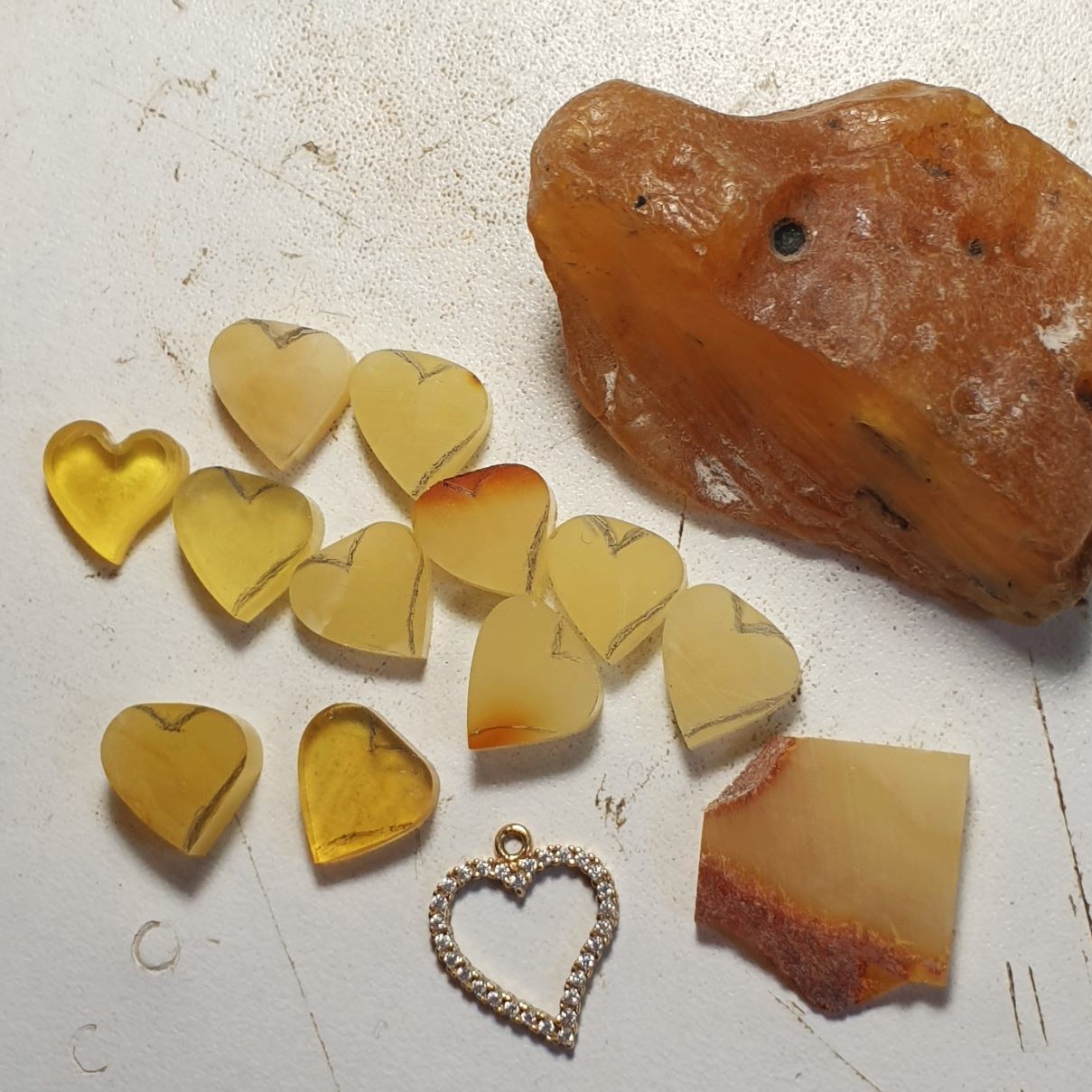
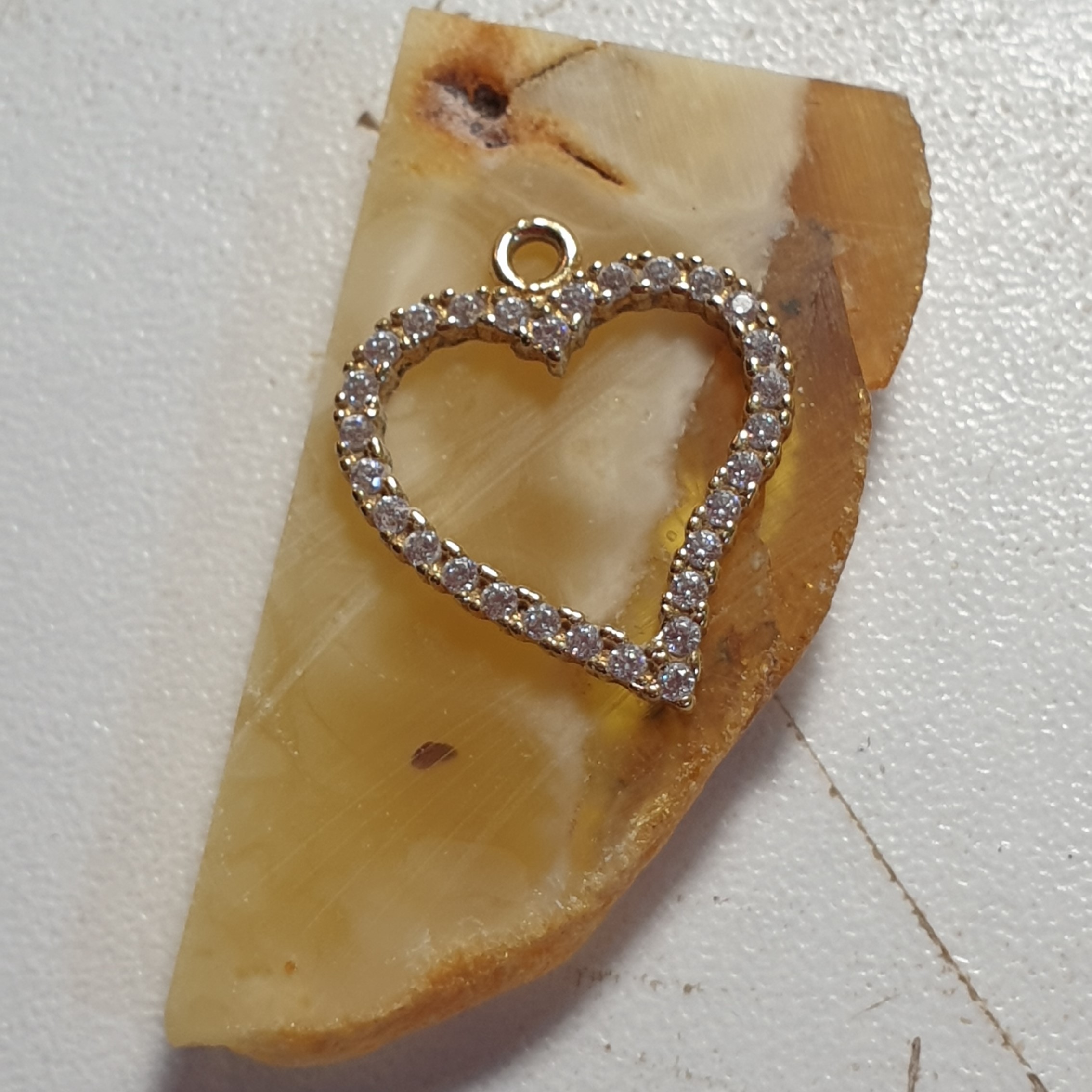
In their rough state, the walloons themselves have an irregular shape. They must first be cut and polished to their approximate size and shape.

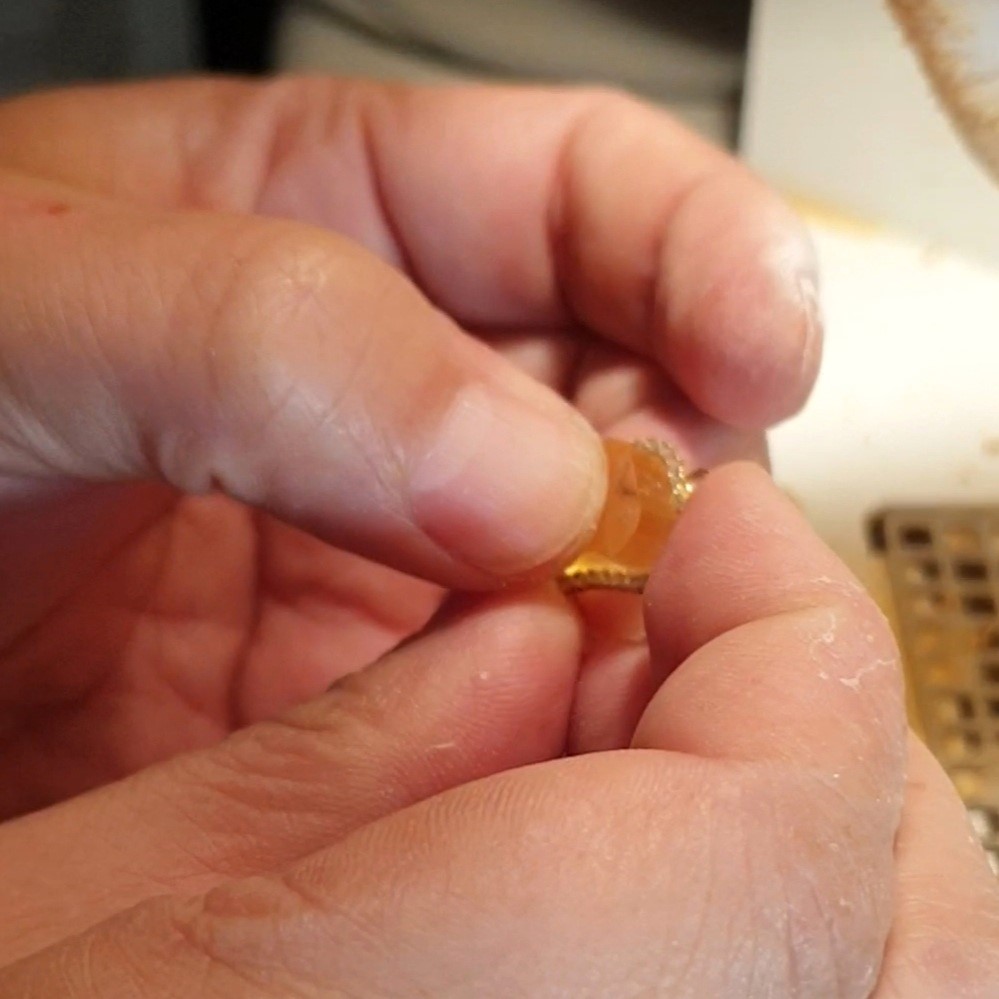
This is followed by a tricky work which requires a great deal of patience. The resulting shape is hand-carved bit by bit to fit perfectly into the hoop. This requires very precise and delicate work. It applies not only to grinding, but also to polishing. This is also done entirely by hand. Only then can the actual assembly proceed.
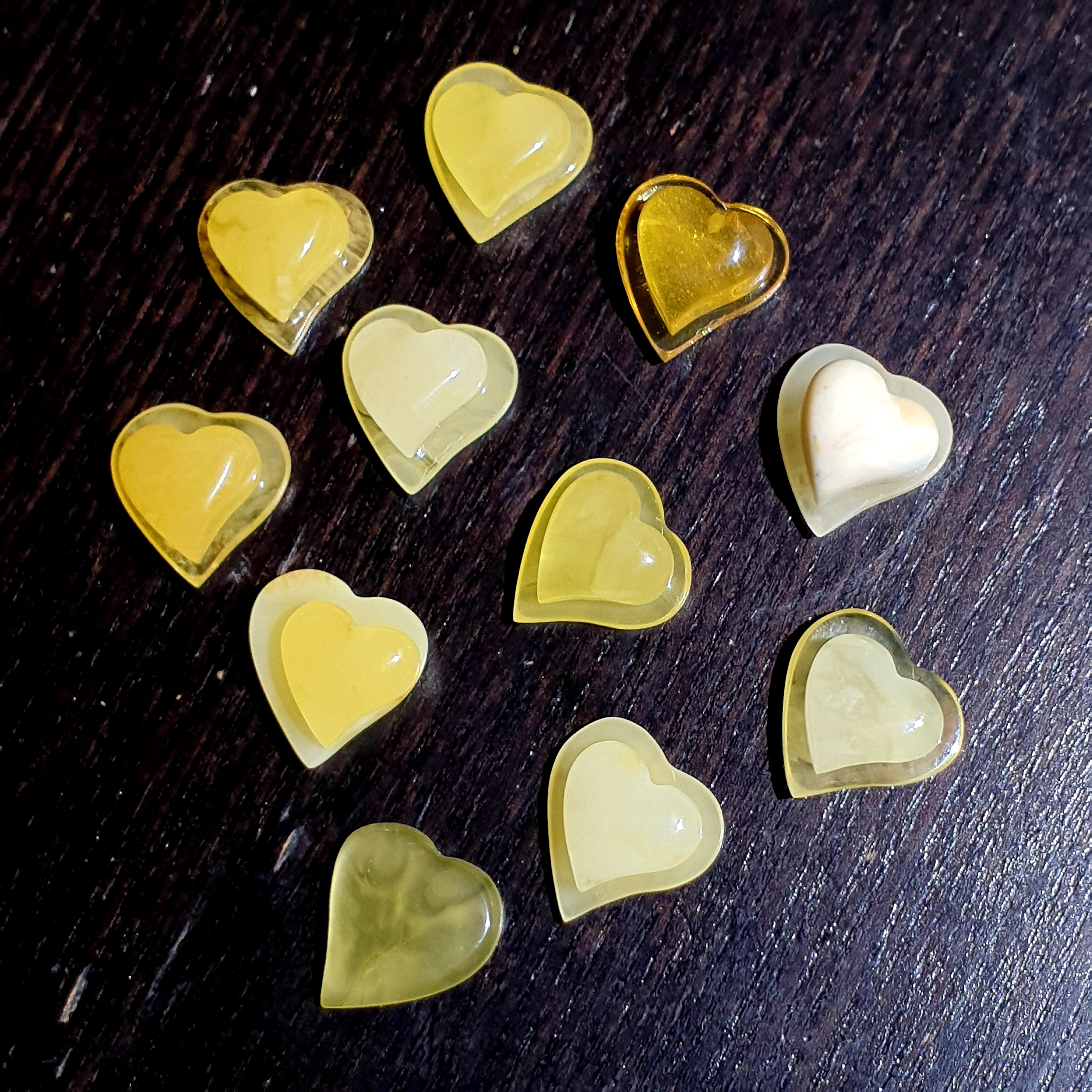
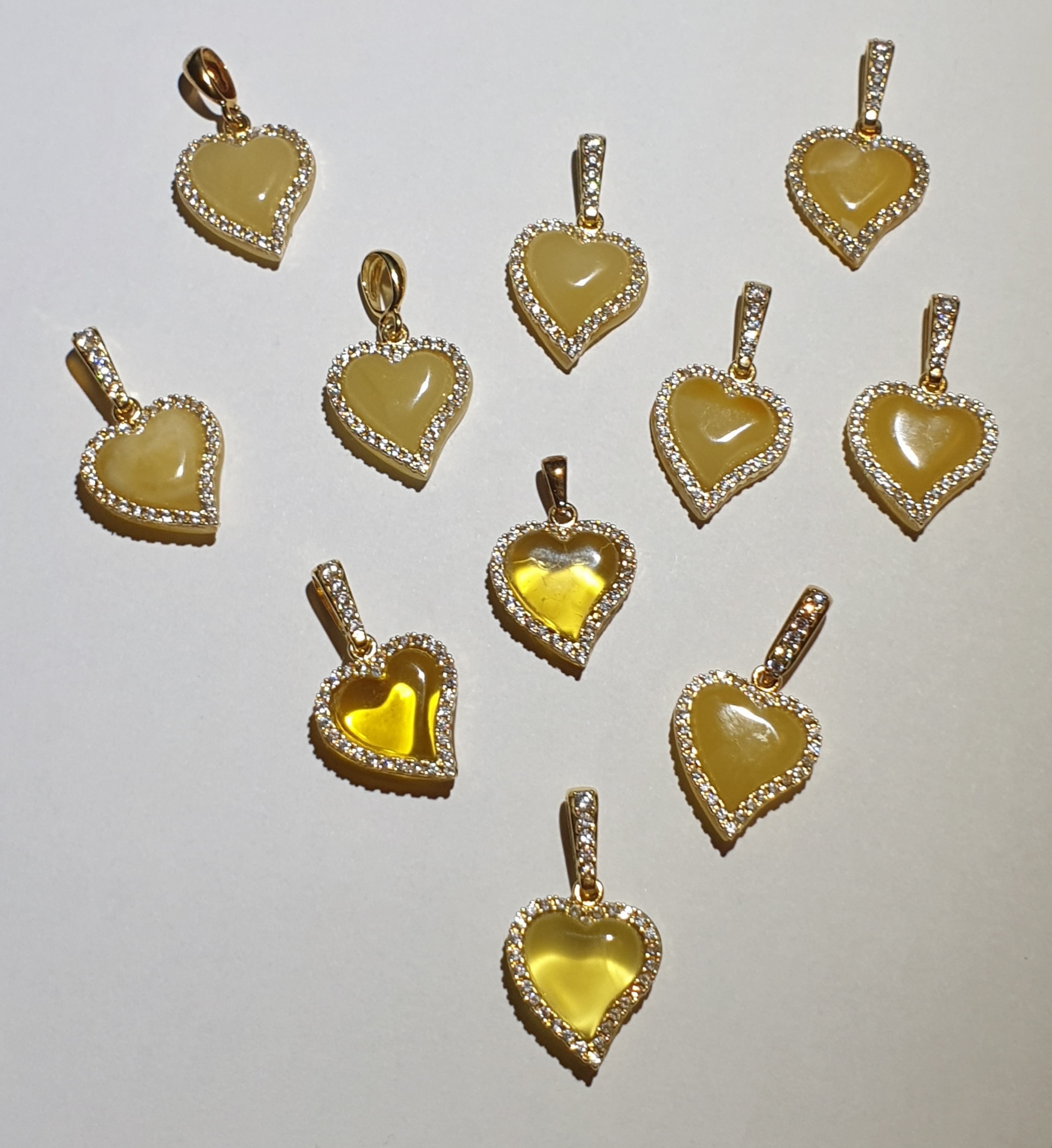
These amber hearts were deliberately created to be in contact with the skin all the time. Amber is light and warm. Its silky touch is soothing and evokes a feeling of a gentle embrace. Every time your sweetheart looks at this heart pendant or takes it in her hand, she will feel your closeness and a wave of tenderness will flood her heart.
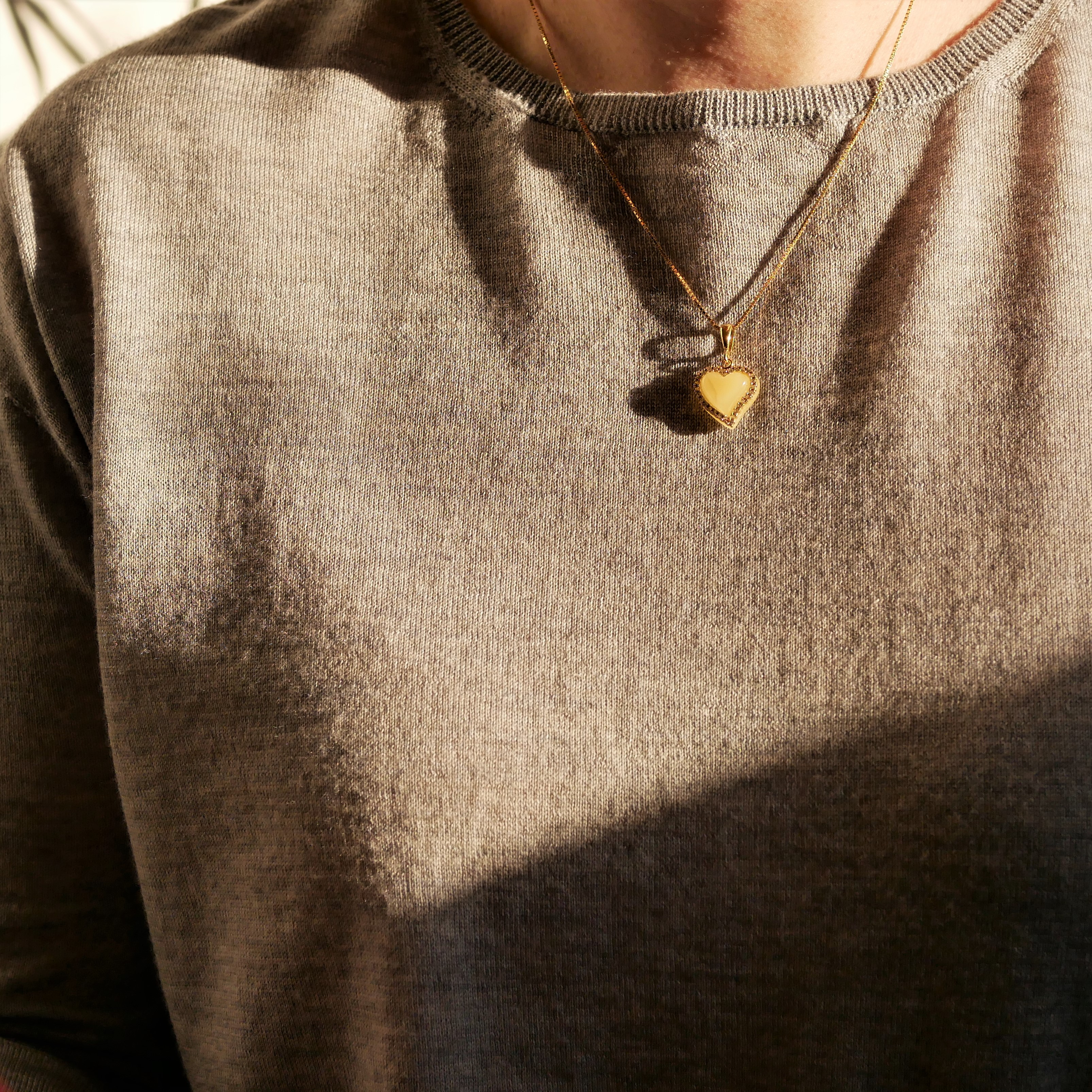
Let this gemstone shrouded in mysterious legends tell your love story for you.
Would you like to give your sweetheart, sister, or mother such an amber heart? You can reach us this way.
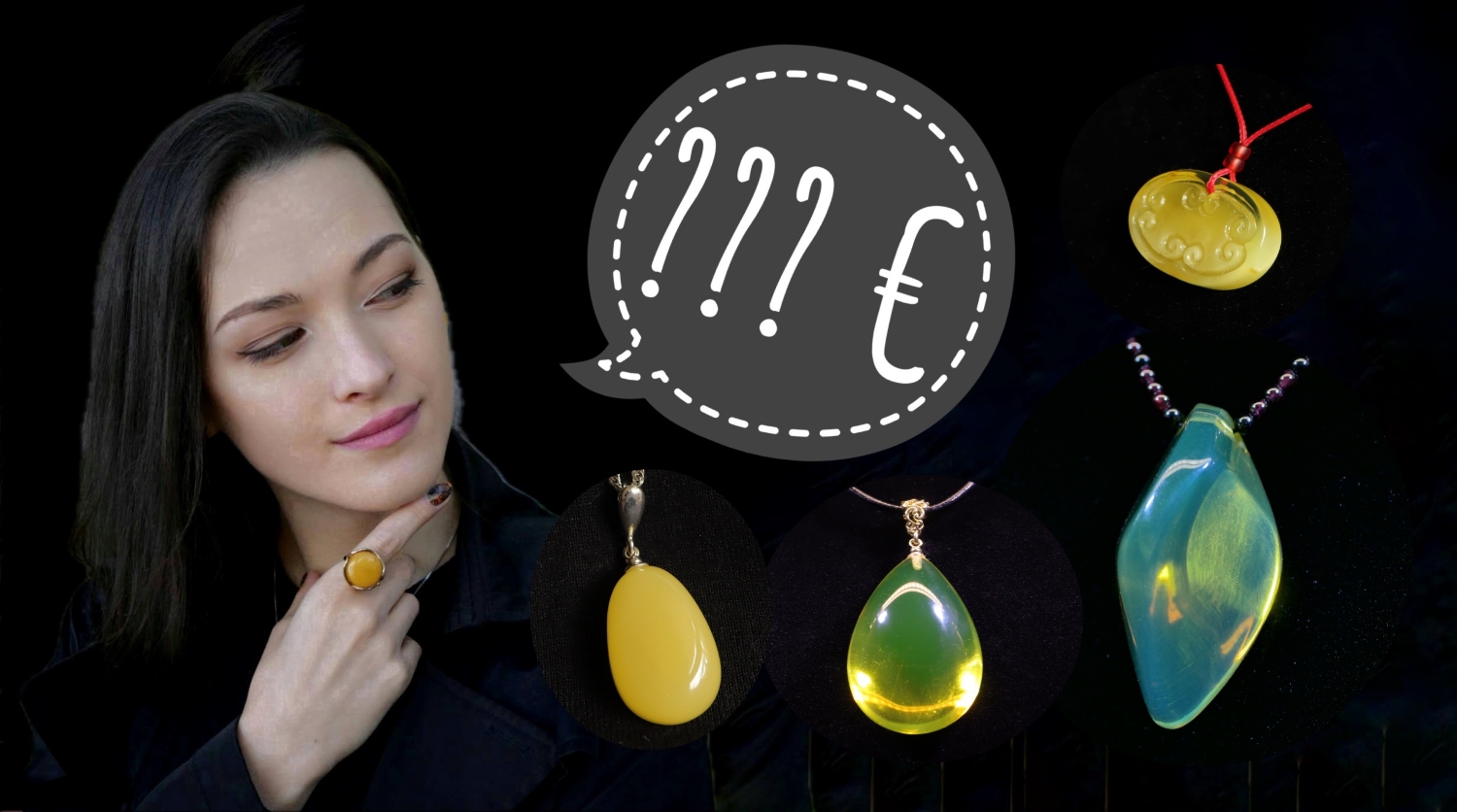
What is the real price of amber
Customers often ask us what is the price of amber per gram. However, there is no simple answer to this question. In fact, two amber pieces of approximately the same weight and similar shape can have diametrically different prices. While one may cost only a few hundred Czech crowns, the other may be worth more than ten thousand Czech crowns.
Many factors influence the price of amber.
- The origin of amber
- Type of amber
- Quality of the amber
- Size and shape of the cut
- Special features such as insect or plant fossils
Before we take a closer look at these factors, it should be noted that we are talking about natural amber that has not been modified or reconstructed in any way.
The Origin of Amber
The origin of raw amber is one of the decisive factors that influence its price. Amber is found in different parts of the world. However, only from some localities it is used for jewellery. The most famous amber originates from the southern coast of the Baltic Sea. We can also find amber in Ukraine, Madagascar, the Dominican Republic, Mexico and Burma. Baltic amber is the most widely used in the jewellery industry.
Amber from Ukraine is often sold as Baltic amber, as it is very similar but cheaper. Ukrainian amber is comparable to Baltic amber in terms of age. However, its quality (with exceptions) does not reach the quality of Baltic amber, so it is very often being modified.
Let's move on.Blue amber from the Dominican Republic is the rarest kind of amber, especially blue amber of AAA quality. Its cost can reach astronomical prices. This is why some sellers sell Mexican amber or Dominican green amber as blue amber. All three types have a specific distinctive blue fluorescence under ultraviolet light. You can see the difference between them under sunlight or intense daylight, and of course the price differs significantly. Compared to Baltic amber, Dominican green amber is slightly more expensive, while Mexican amber is cheaper. However, other factors must also be taken into account when setting the price.
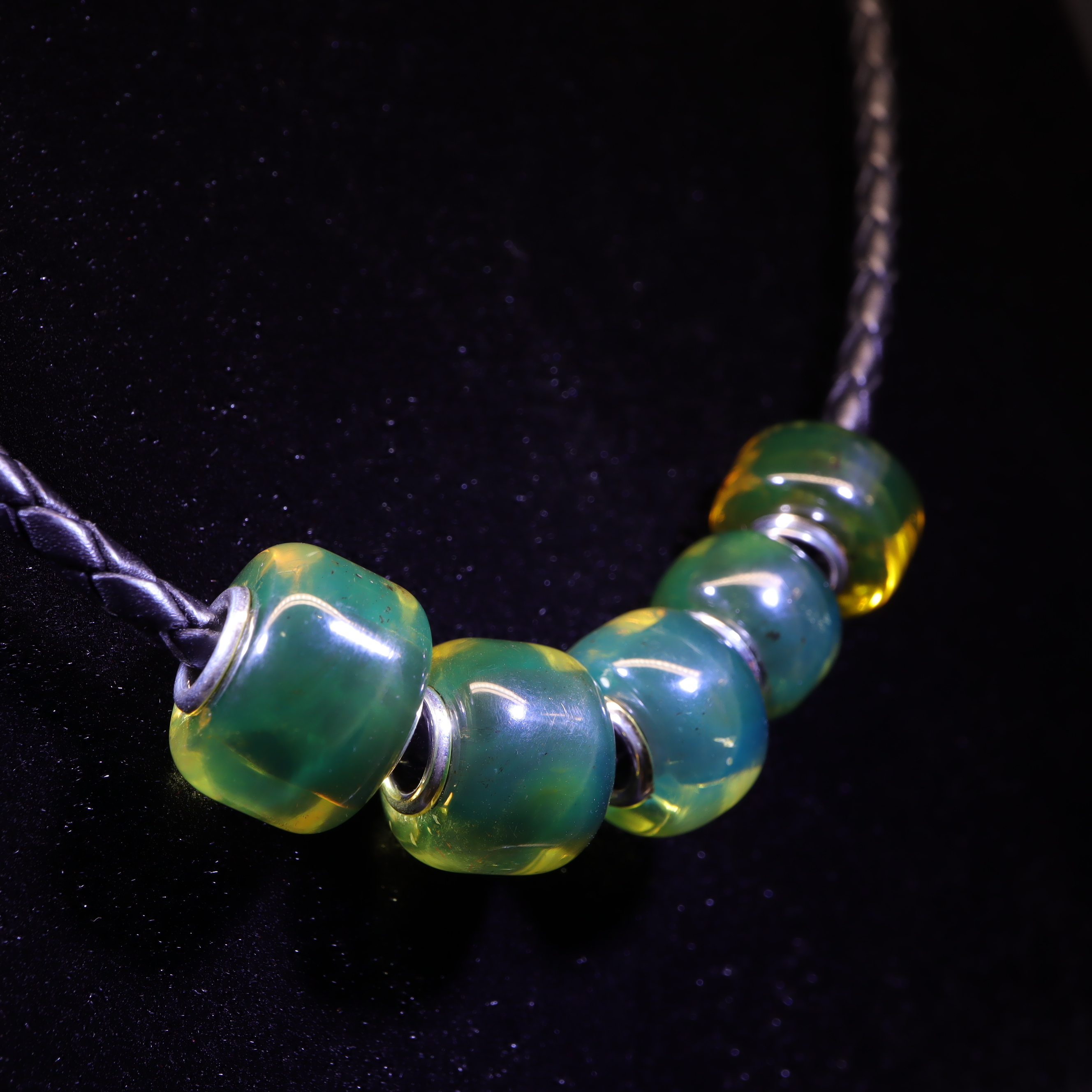
Photo: These beads were crafted from Dominican amber and are photographed under intense spot daylight. This is the best way to tell if it is green or blue amber.
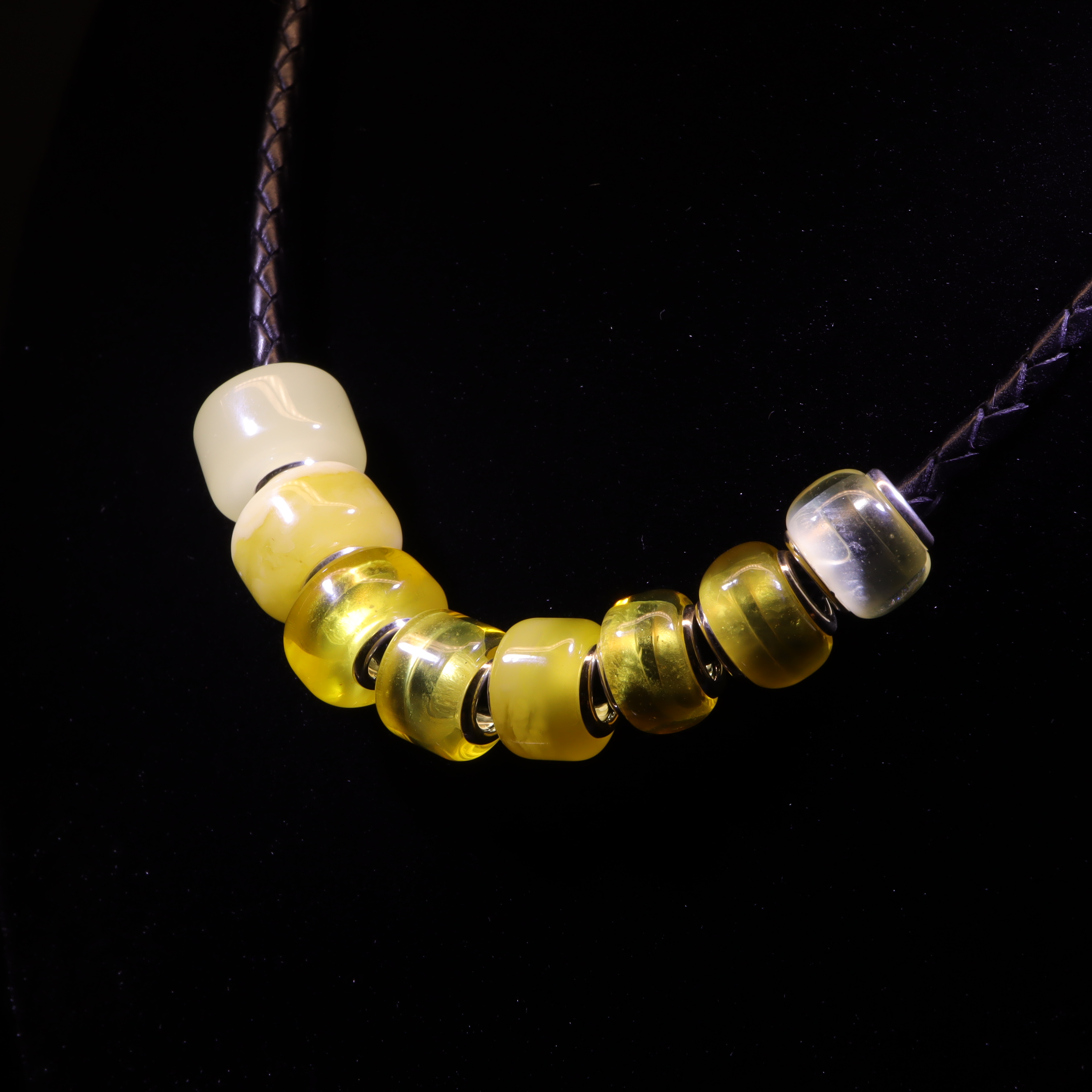
Photo: Beads in the first and the second photo are more or less the same shape and size. However, the price varies depending on the origin of the amber, its type and quality. The highest price will be for the Dominican blue amber beads, followed by the green amber beads and the Baltic amber beads will have the lowest price.
Type of Amber
Another important factor is the type of amber. For example, in Baltic amber white amber is the rarest and therefore the most valuable kind. It is almost 10 times more expensive than its yellow variant. Price of the Baltic amber also depends on whether it is transparent, semi-matt or matt. Very generally speaking, milky amber has a higher price than the transparent one in the case of Baltic amber, but here a lot depends on the quality. We will come to that later.
In Dominican amber there is only the transparent form of amber. In this case the price depends on its colour, whether it is yellow, green or blue amber. You will pay the least for the yellow one, sometimes called gold. On the contrary, blue amber is much more expensive than its green or yellow relatives.
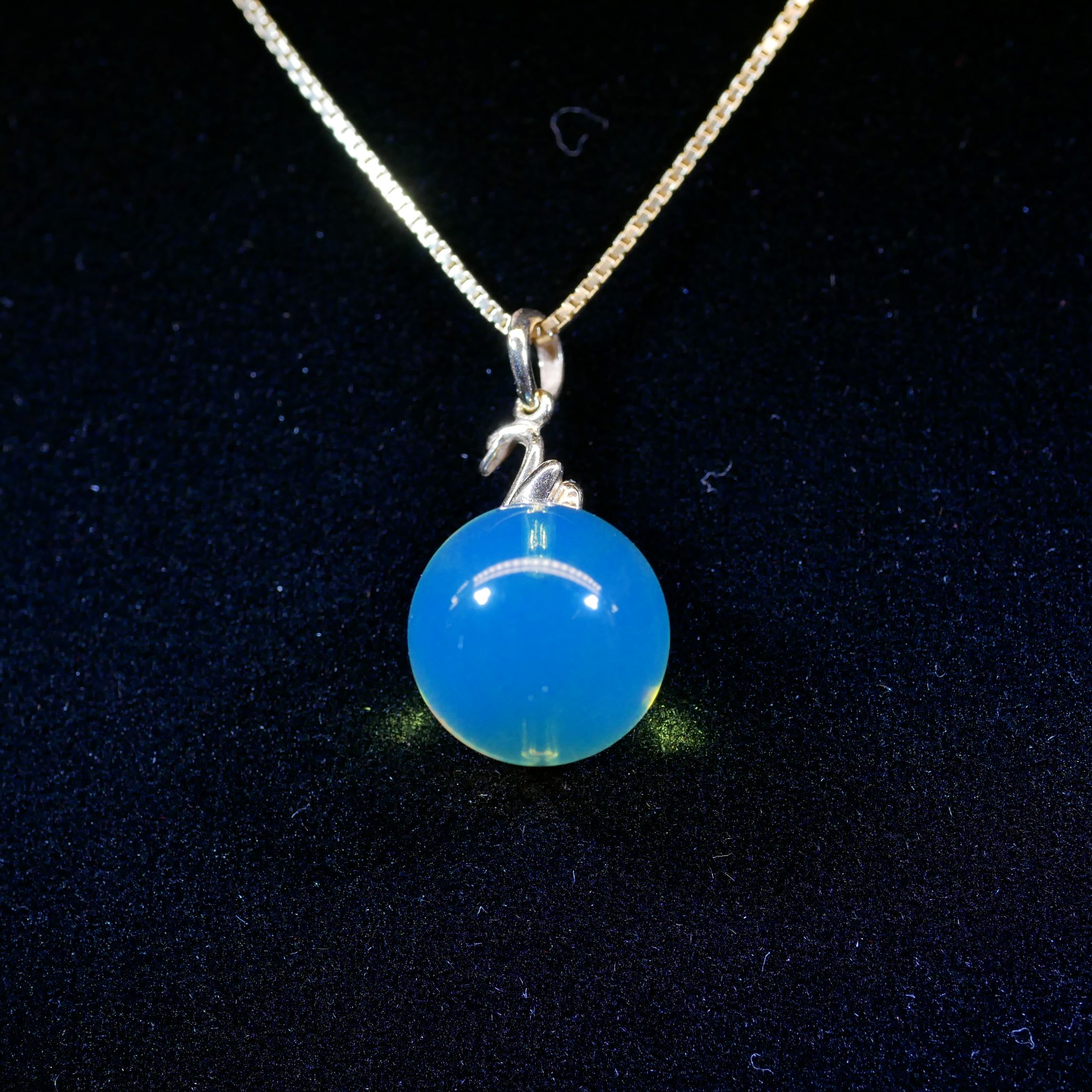
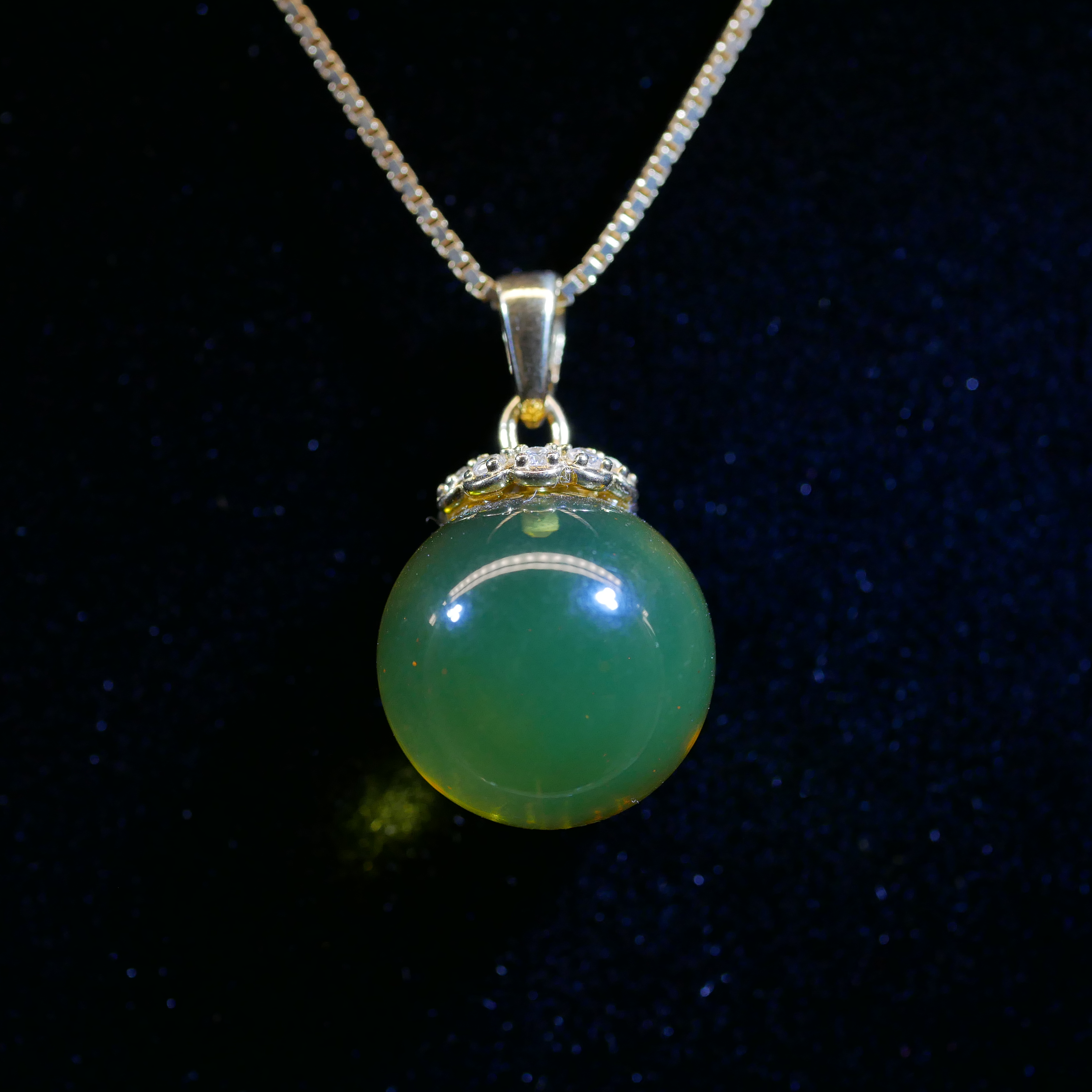
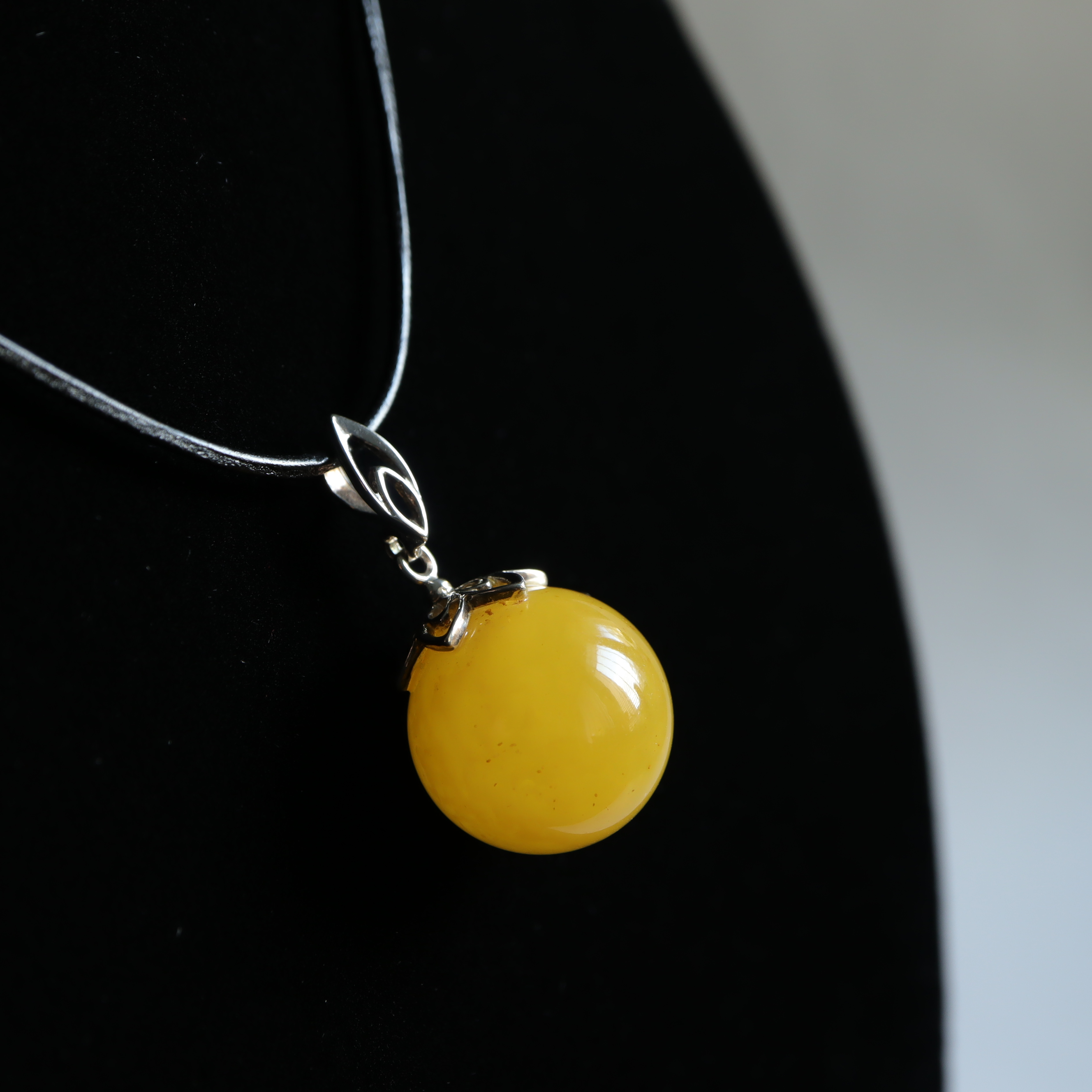
Photo: For pendants of the same shape, quality and approximately the same size we have to consider the origin and type. For example, a bead pendant of blue Dominican amber in AAA quality will cost at least ten times more than Dominican green or Baltic amber.
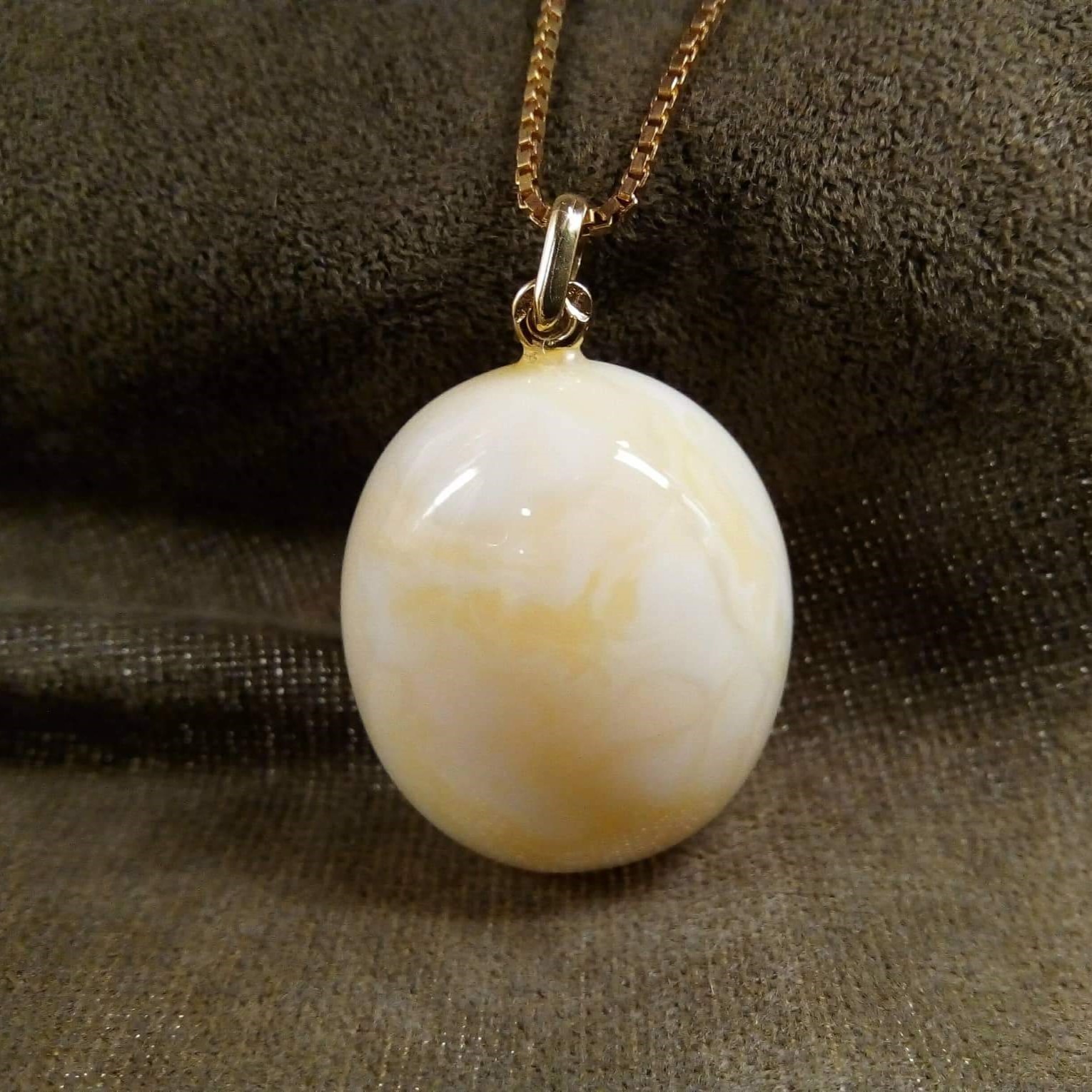
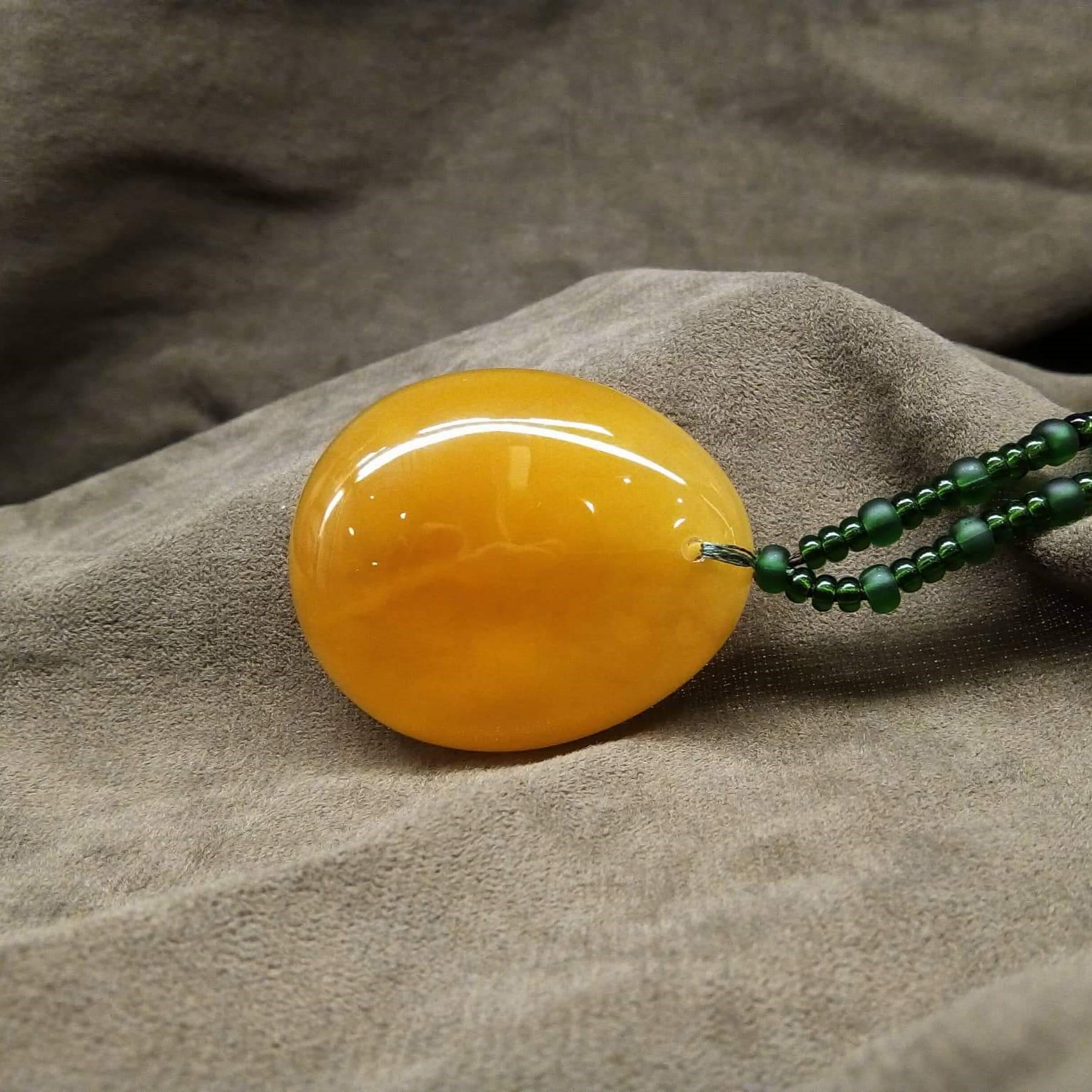
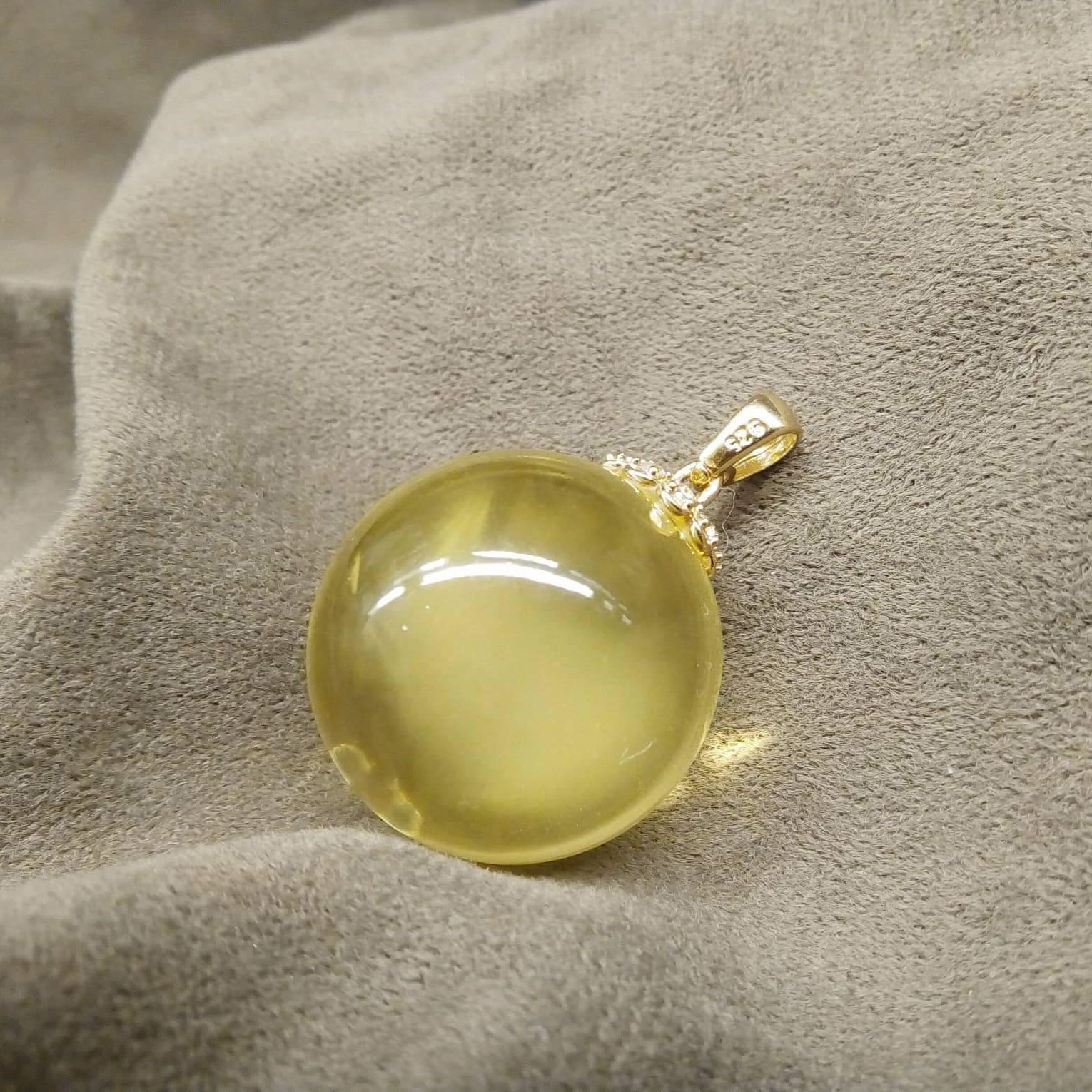
Photo: White amber is the rarest type of Baltic amber. It is followed by the milky form, mainly of a deep yellow to orange-brown colour, or the kind where white amber mixes with yellow to form various patterns. The transparent to semi-transparent form of Baltic amber tends to be more often found, and therefore its price is slightly lower. However, if the transparent Baltic amber is of top quality, this rule does not apply and its price will be the same as milk amber of the same quality.
Quality of Amber
How do we distinguish the quality of amber? This is quite a complex discipline and it takes a bit of practice and experience. However, we can follow a few simple rules. In fact, with amber it is similar to other precious stones. Colour, clarity and light refraction are all considered. The brighter the colour, the cleaner the body of the amber and the higher the light refraction, the more valuable it is. This is regardless of whether it is transparent or milky. Conversely, cracks and inclusions, or other blemishes, surface irregularities, bubbles visible to the eye, etc., reduce the value of amber.
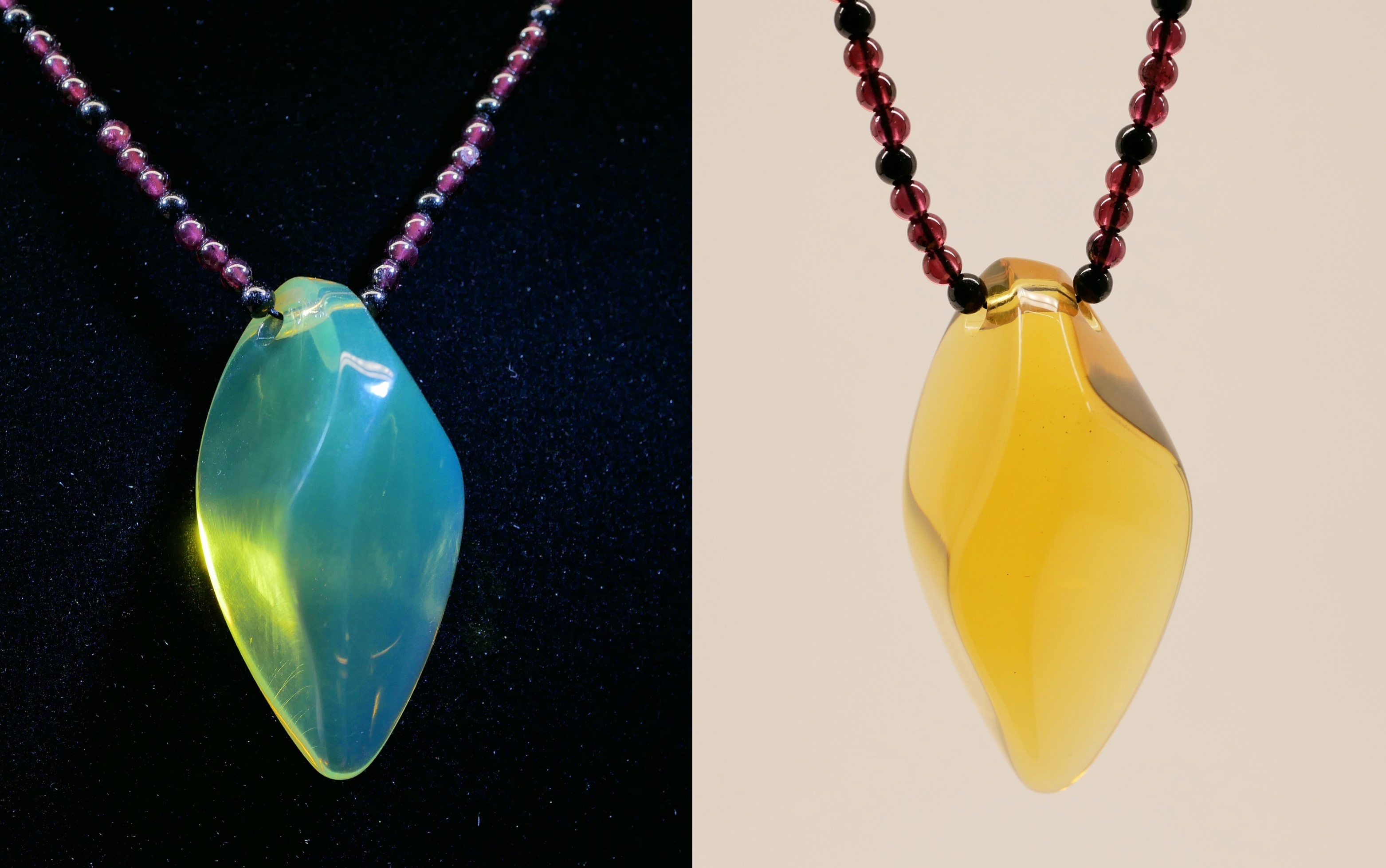
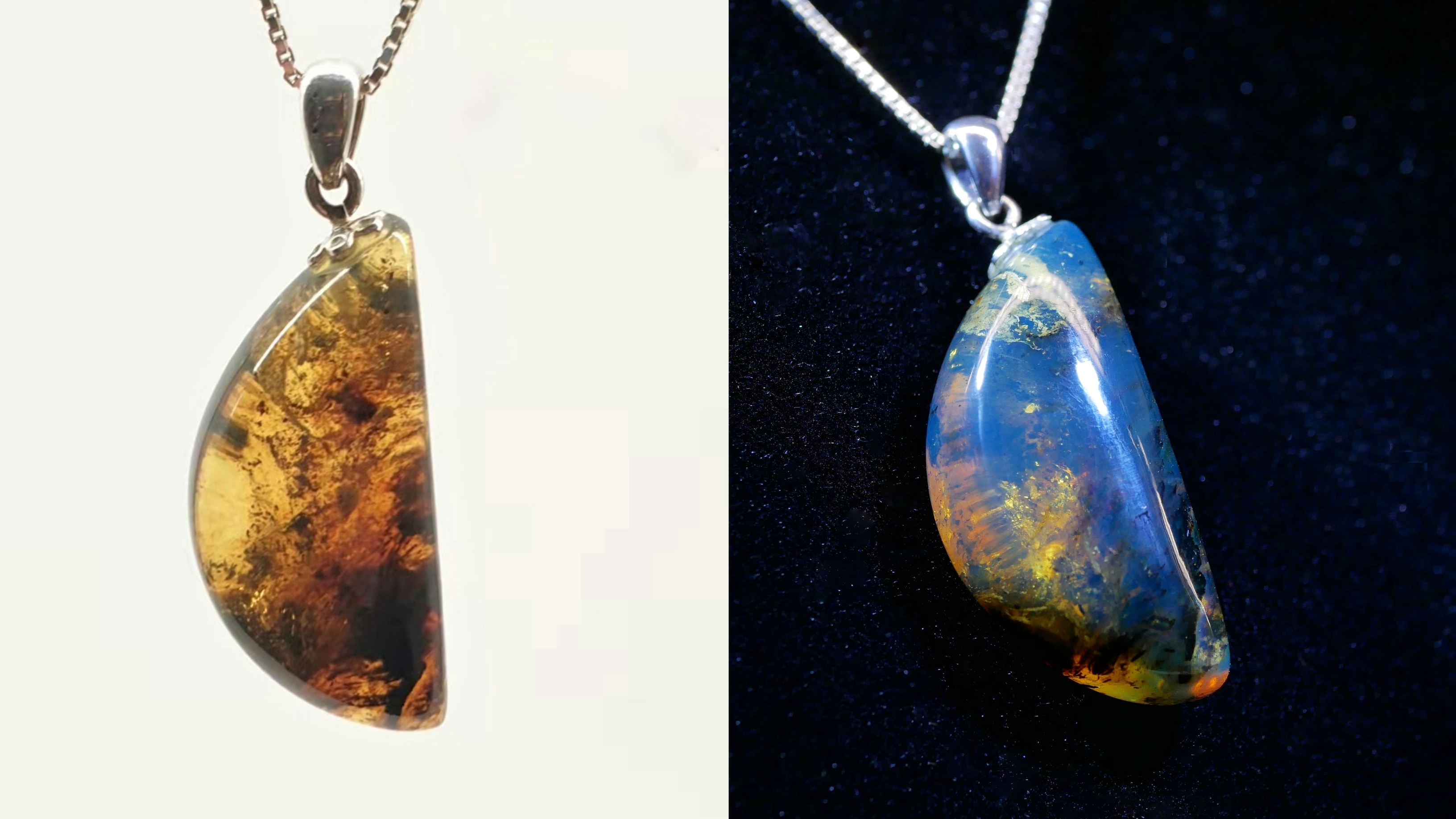
Photo: The quality of blue Dominican amber in particular is very important. The price of AAA quality blue amber will be many times higher than blue amber with a large number of inclusions.
Size and Shape
Another important factor influencing the price of amber is its size. Price increases exponentially with size. The larger the fraction, the higher the price. If for small nuggets, which are commonly washed up by the sea, the price is only a few crowns per gram, for large pieces, e.g. over 200 g, the price will climb to hundreds or thousands of crowns per gram.
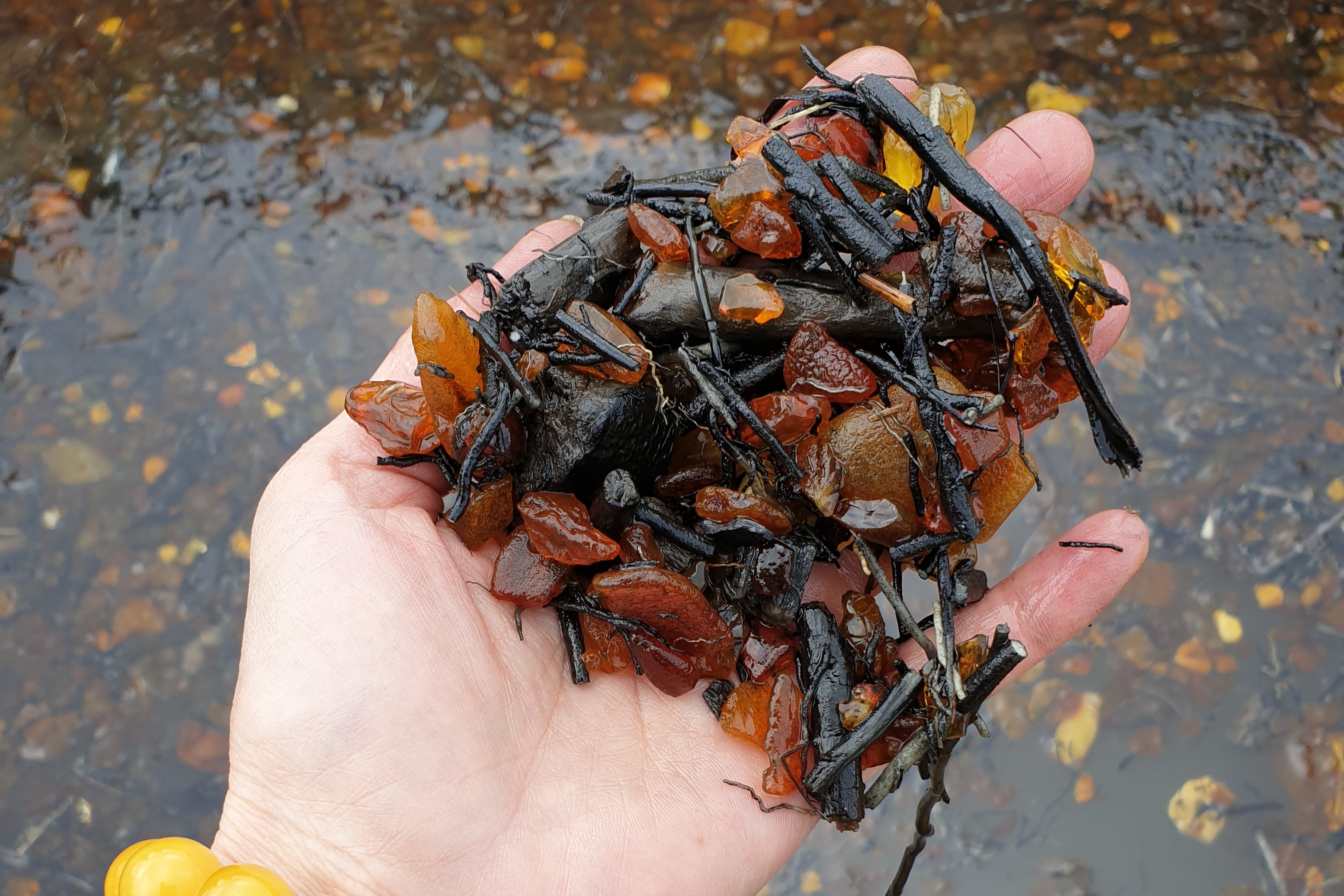
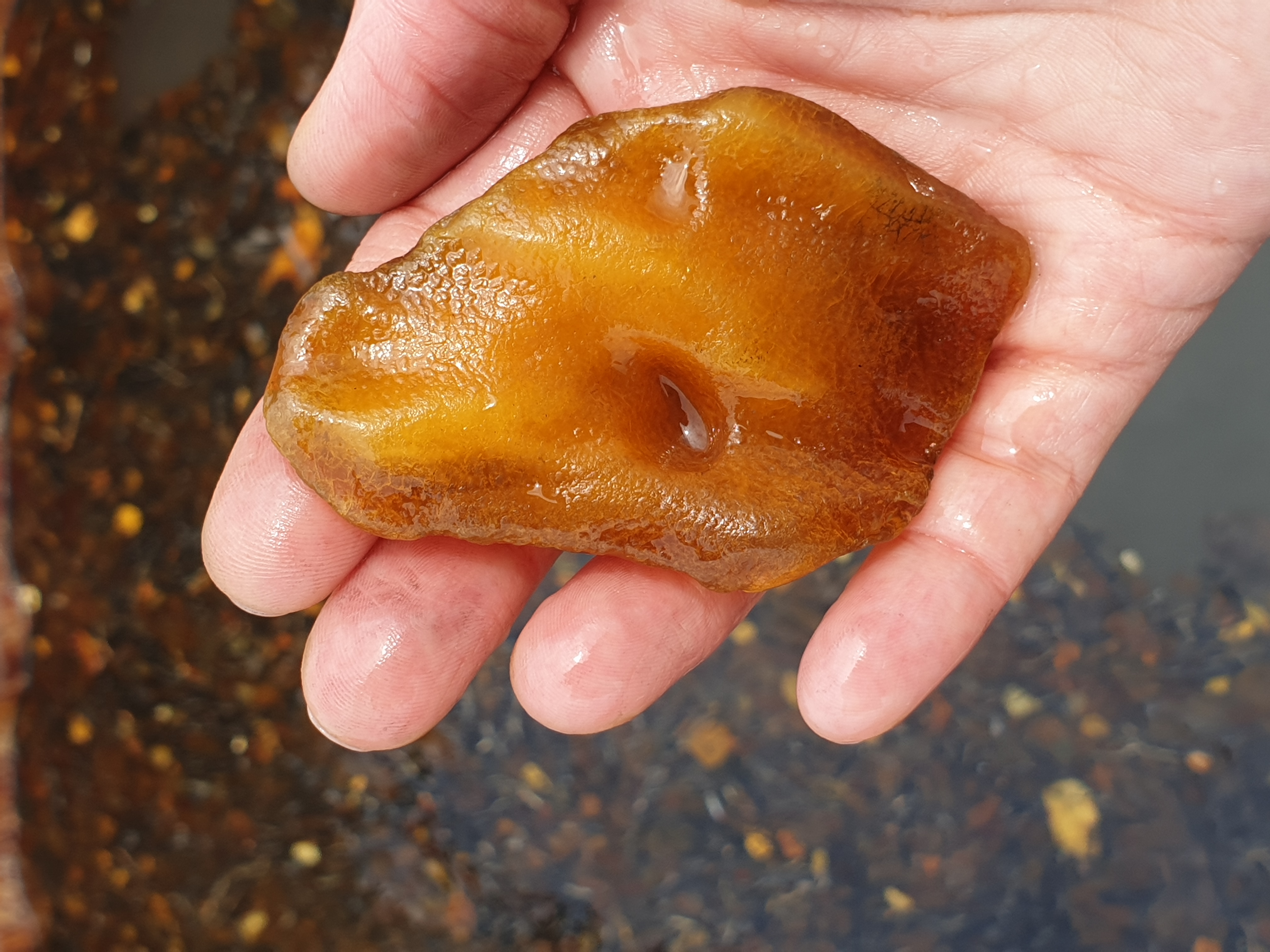
Photo: Small fractions of amber are the most common and are very cheap. But you can't craft anything larger out of them. This is one fact. Also the bigger the amber, the better the colour and generally better the quality.
The size is then related to the shape of the final jewel. Raw amber is never perfectly regular in shape. Its surface is often uneven. Various depressions or even holes are not rare at all. So when you want to cut a perfectly symmetrical shape, it is logical that there will be a great loss of material in the cutting process. The rounder the shape, the higher the demands on the size and thickness of the rough amber. Two pieces of the same weight but different shape may have different prices. Beads have the highest demands on the shape and size of the rough stone. Therefore, round pieces always cost more than the flat, thin ones. Then when comparing, for example, the shape of teardrops, the rounder and fuller the shape of the teardrop, the higher the price.
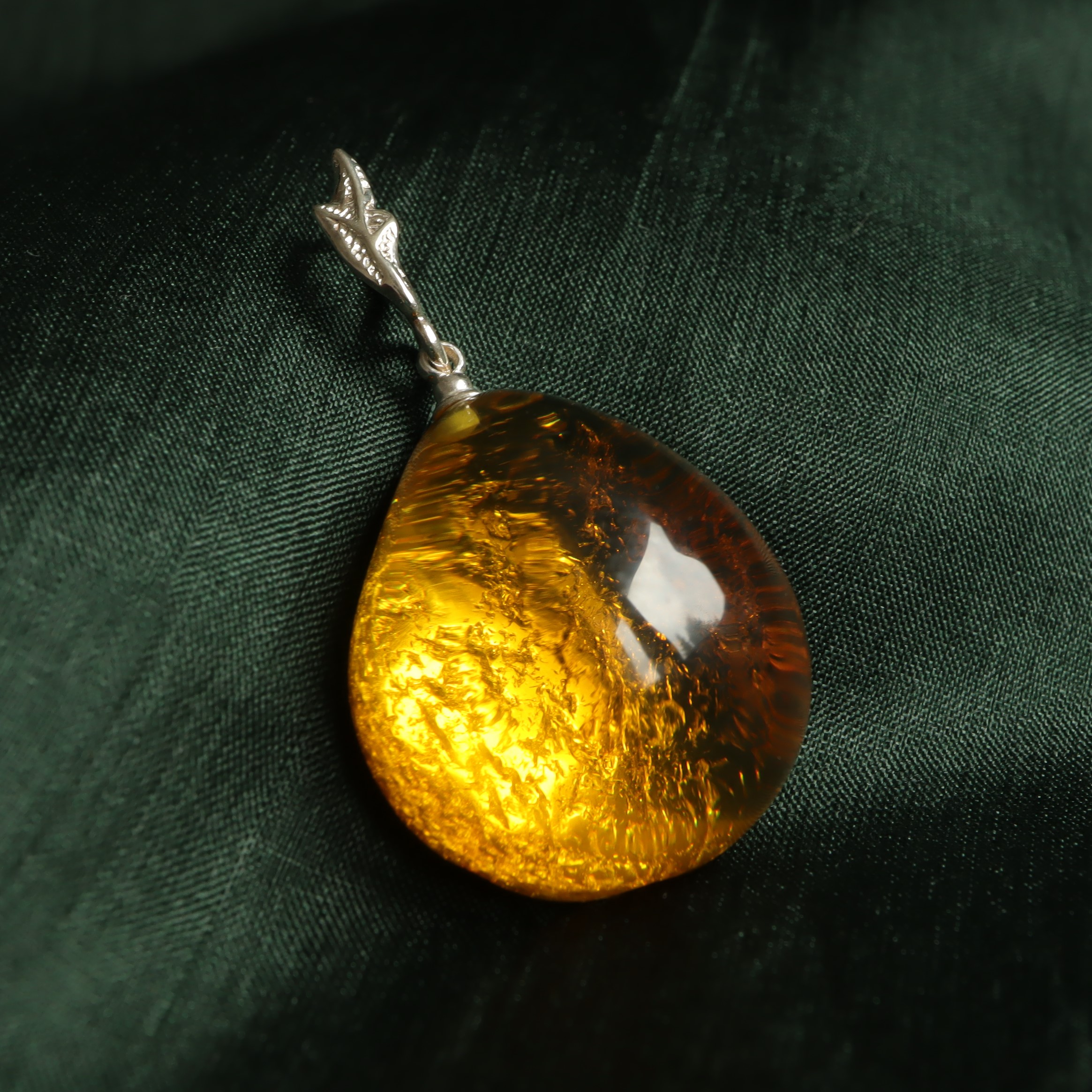
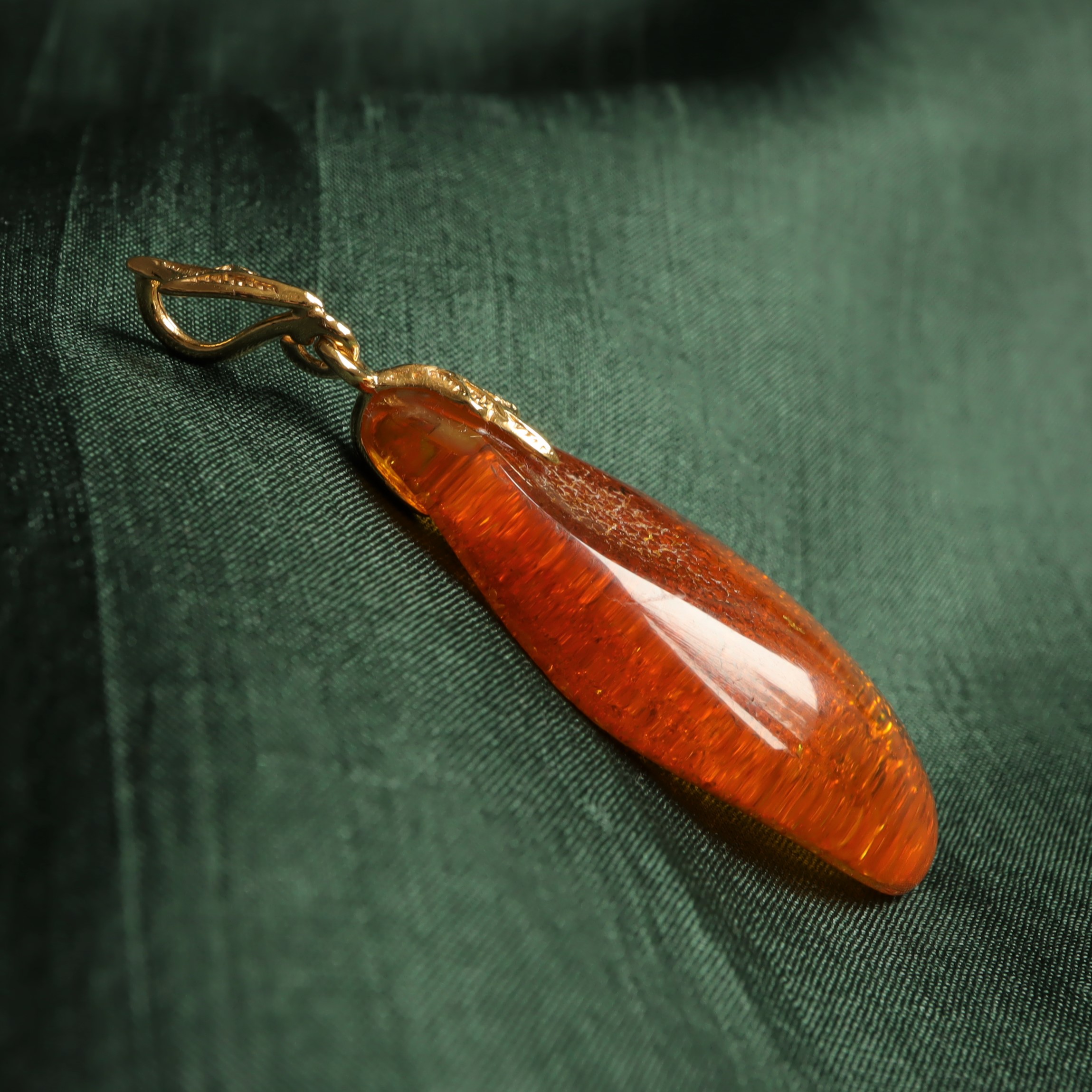
Photo: Even though the teardrop in the first photo is slightly smaller, by having a perfectly regular and full shape, its price will be higher than that of the teardrop in the photo below.
The higher price per gram will also be for shapes that have a high material loss during cutting and are demanding on the shape of the rough stone. Such shapes include round beads, but also donuts, barrels and similar round shapes (see photo below).
You can read more about how round beads are crafted here.
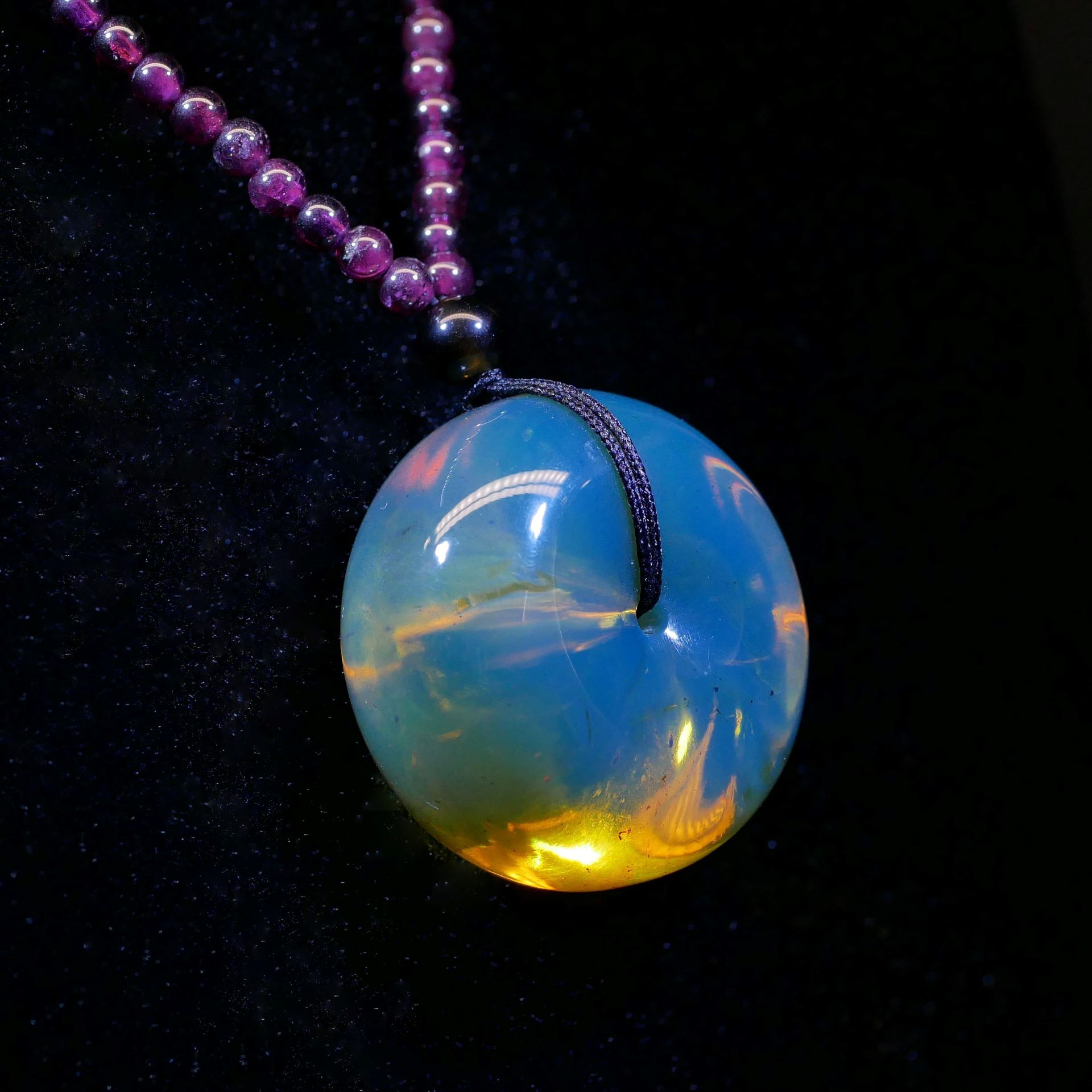
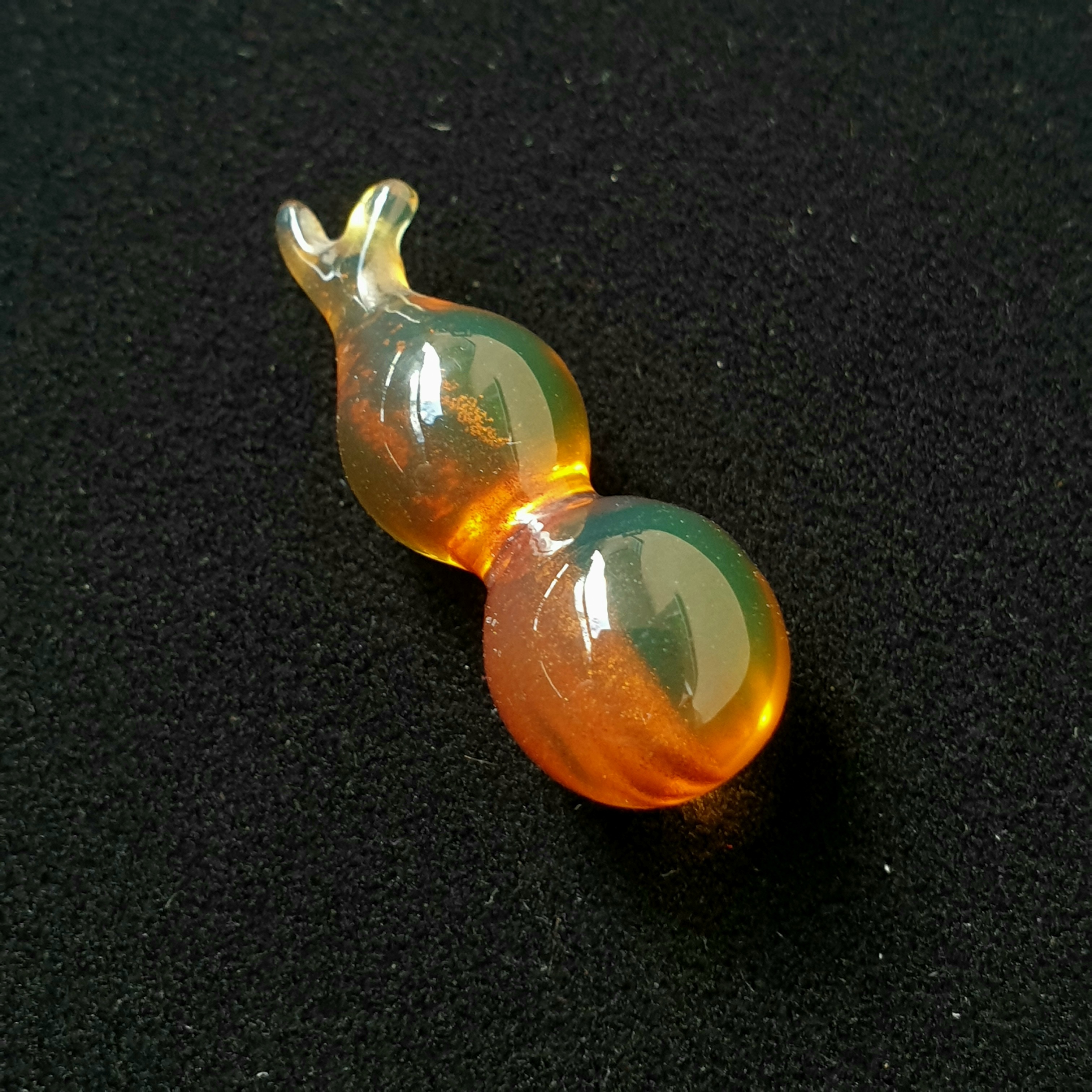
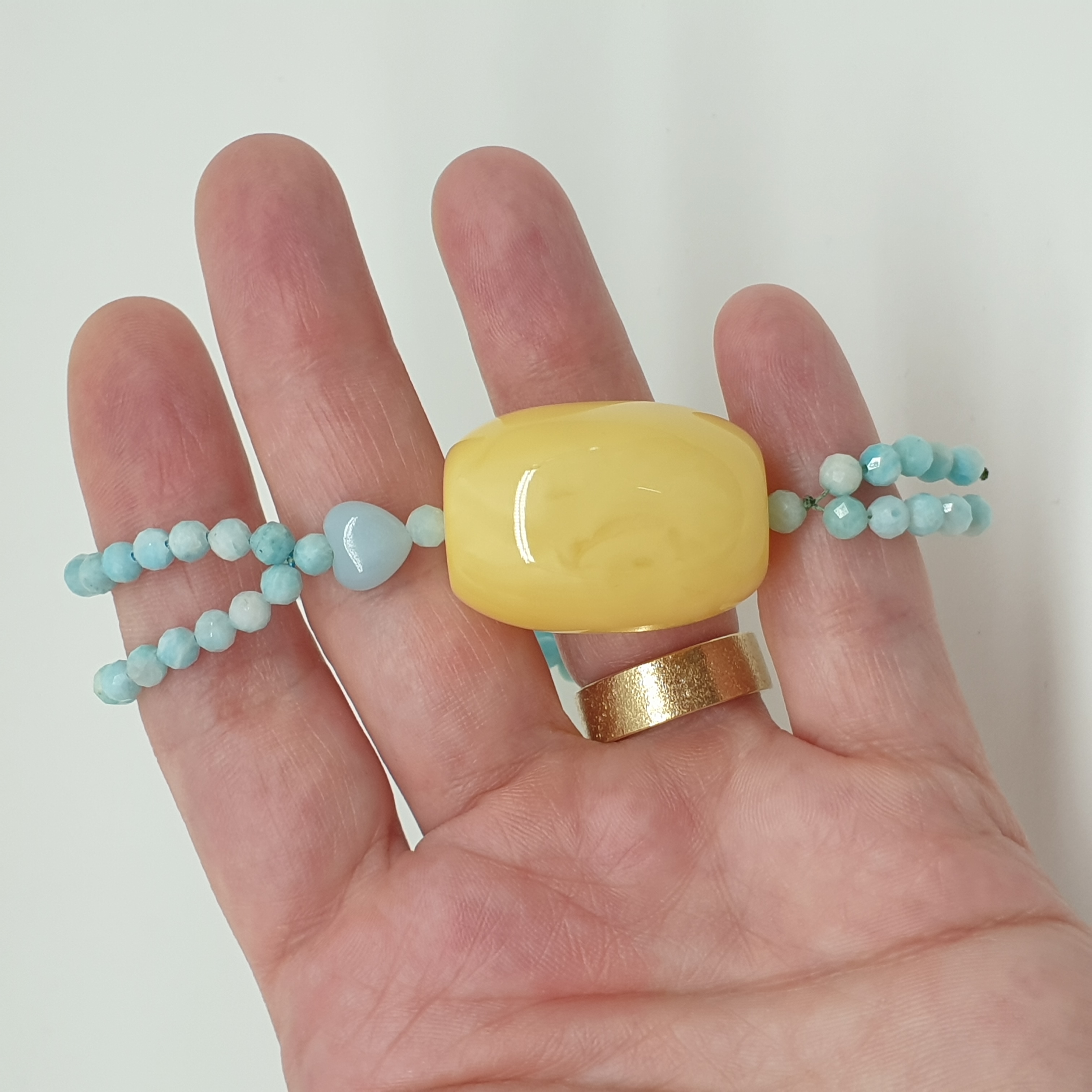
Special Features Found in Amber
Last but not least, peculiarities such as insect or plant fossils play a big role in the price of amber. Here it also depends on what kind of insect or plant it is, in what condition the fossils are preserved, i.e. whether the insect or plant is fully preserved or not and also whether it is clearly visible or whether it is covered by other inclusions, bubbles, etc.
Again, very generally speaking, small flies are quite common, and thus you can easily get them for a few hundred crowns. Much less common are spiders, real mosquitoes (as opposed to chironomids, which are relatively more common) or crawling insects like centipedes, etc. And you will literally pay a fortune for a scorpion, a butterfly wing or a lizard in amber. In the Amber Museum in Gdansk (highly recommended by the way) you can see a beautiful piece of amber with a well preserved scorpion. The museum bought this piece for about 1.2 million Czech crowns.
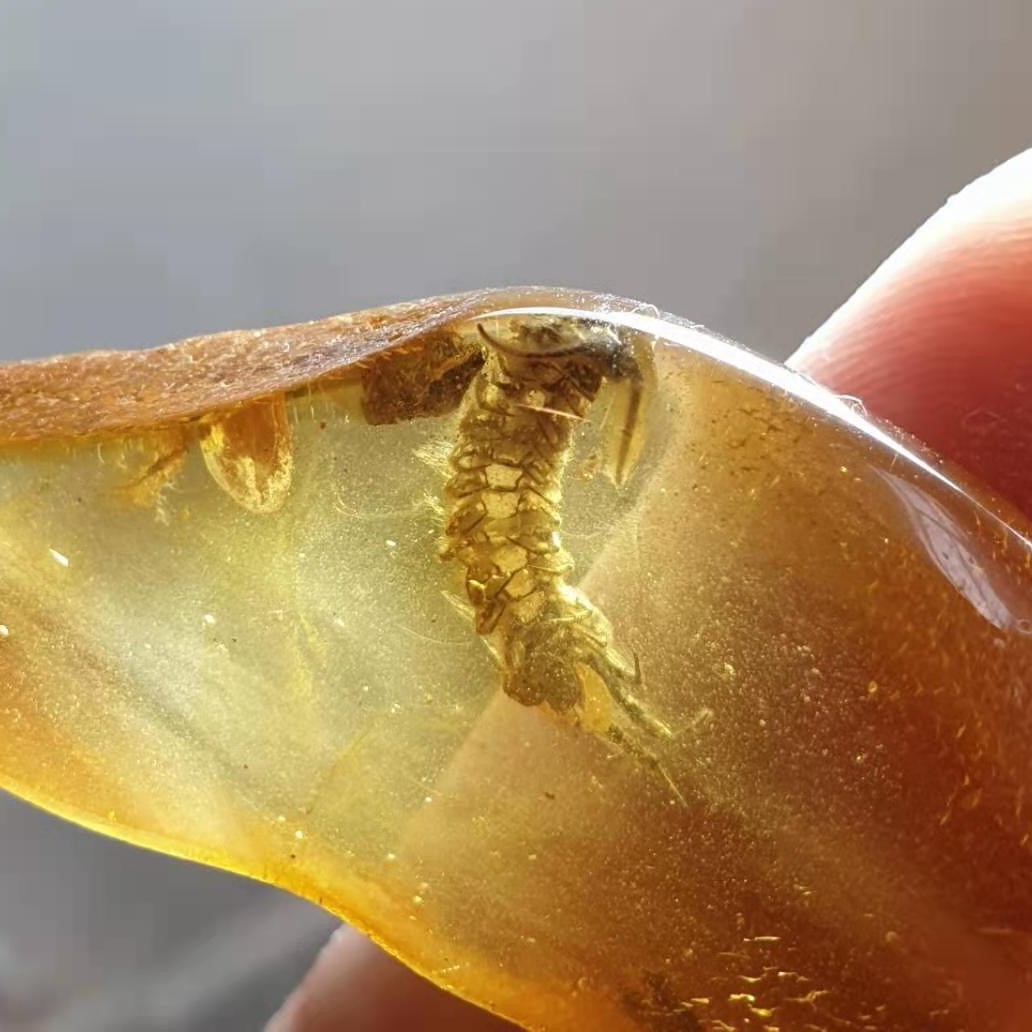
Photo: Various centipedes and similar crawling insects are very rare.
The peculiarities of amber do not end with insect fossils. The world of amber is indeed very diverse and you can come across incredibly interesting pieces, for example with preserved leaf impressions. But that's not all. There are many more of these oddities that we could easily write a book about.
Let's go back to our original question: what is the price of amber per gram? Well, the price for a gram of already crafted amber can range from a few hundred Czech crowns to several thousands crowns. Therefore, an amber jewel can become a valuable investment.
Amber jewellery is not just a beautiful decoration. Amber also has its cultural and financial value.
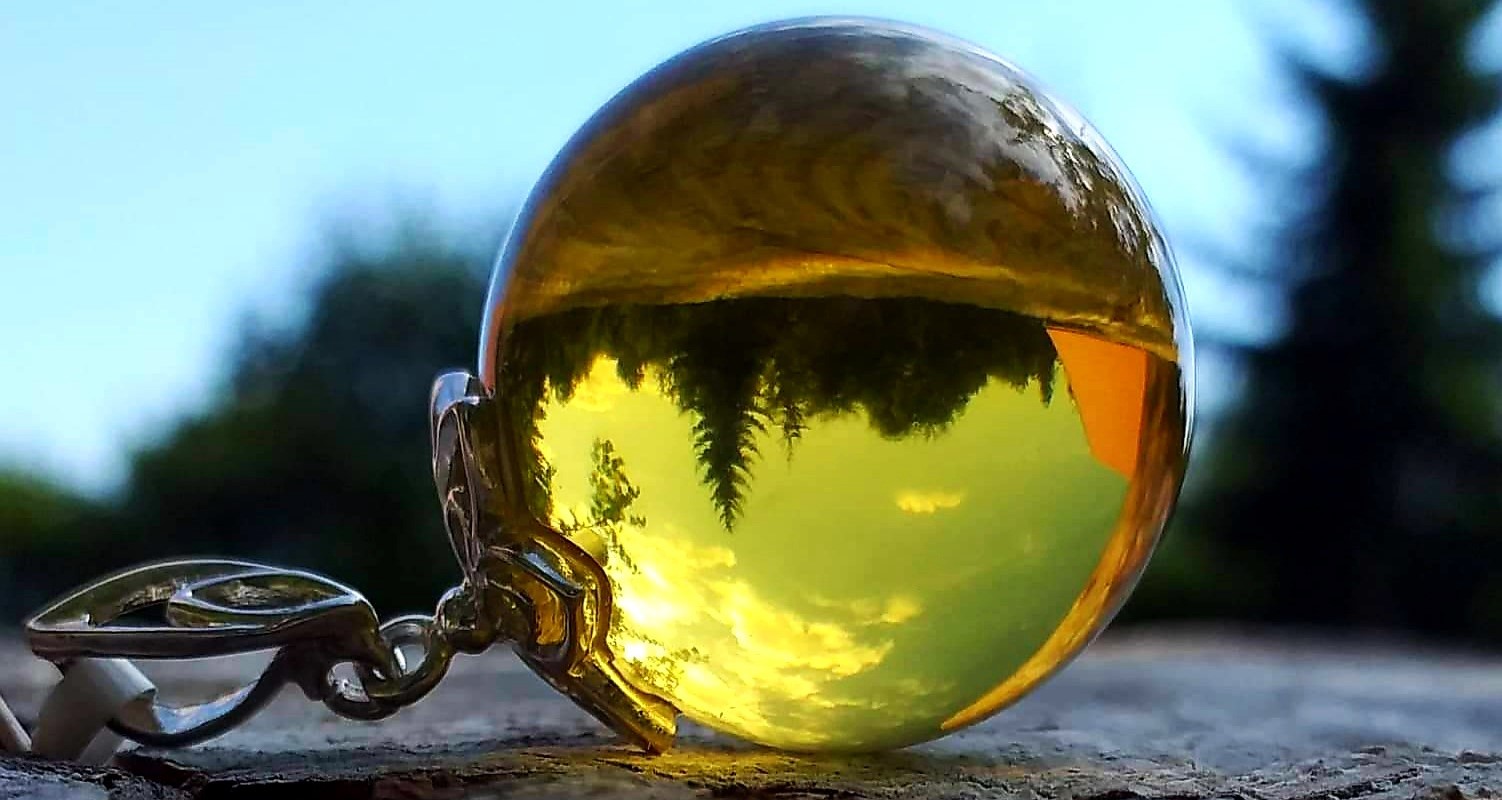
How do we craft round amber beads?
Amber is a unique gemstone whose magic creates a bridge between nature and man. How does a rough amber stone transform into elegant, timeless bead-shaped jewellery? Open the gate to a world where the craftsmanship combines with the deep symbolism of jewellery.
The symbolism of amber beads
Symbols and talismans are an important part of our lives. They are all around us, seen by anyone who is open to them. Even round amber beads are such small talismans that remind us of the beauty and fragility of human existence, but at the same time they symbolise the power of nature. They preserve the power of the sun and the history of our planet for over millions of years. Round shape represents perfection, wholeness and fulfilment. Amber as a gemstone radiates peace, warmth and harmony. By wearing amber jewellery in the shape of round beads, we can connect with this archaic material that opens the door to many cultures and their belief in the power of amber.
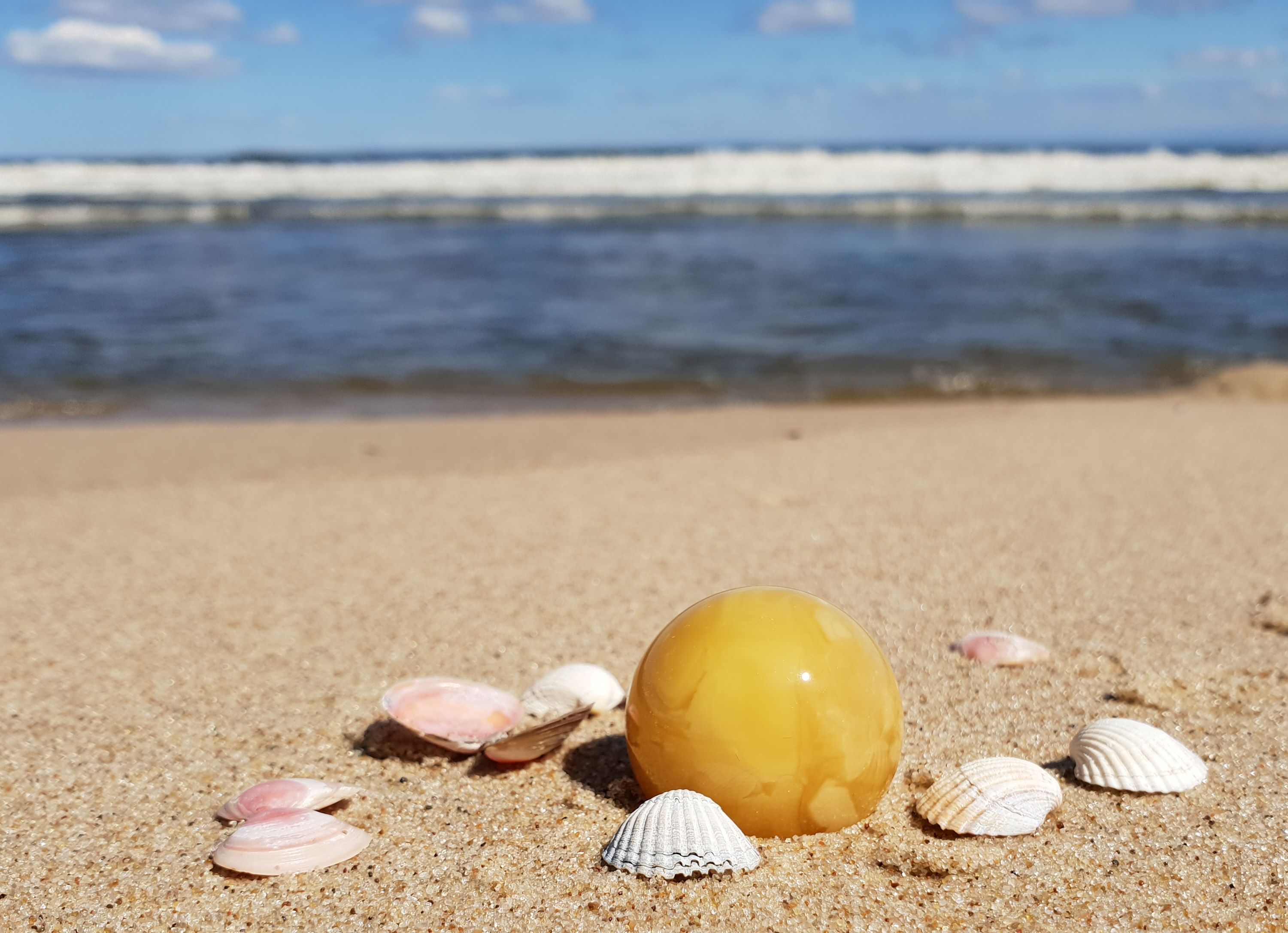
How to craft round beads
Let's take a look at how rough amber stones are turned into perfect round jewels.
- As the first step we have to select suitable rough amber stones, because we can not make a round bead out of every piece. Stones must have sufficient thickness and ideally they have to be as round as possible to minimise the loss of material. The more irregular the shape, the more of it will be cut off. And amber is not a cheap material...
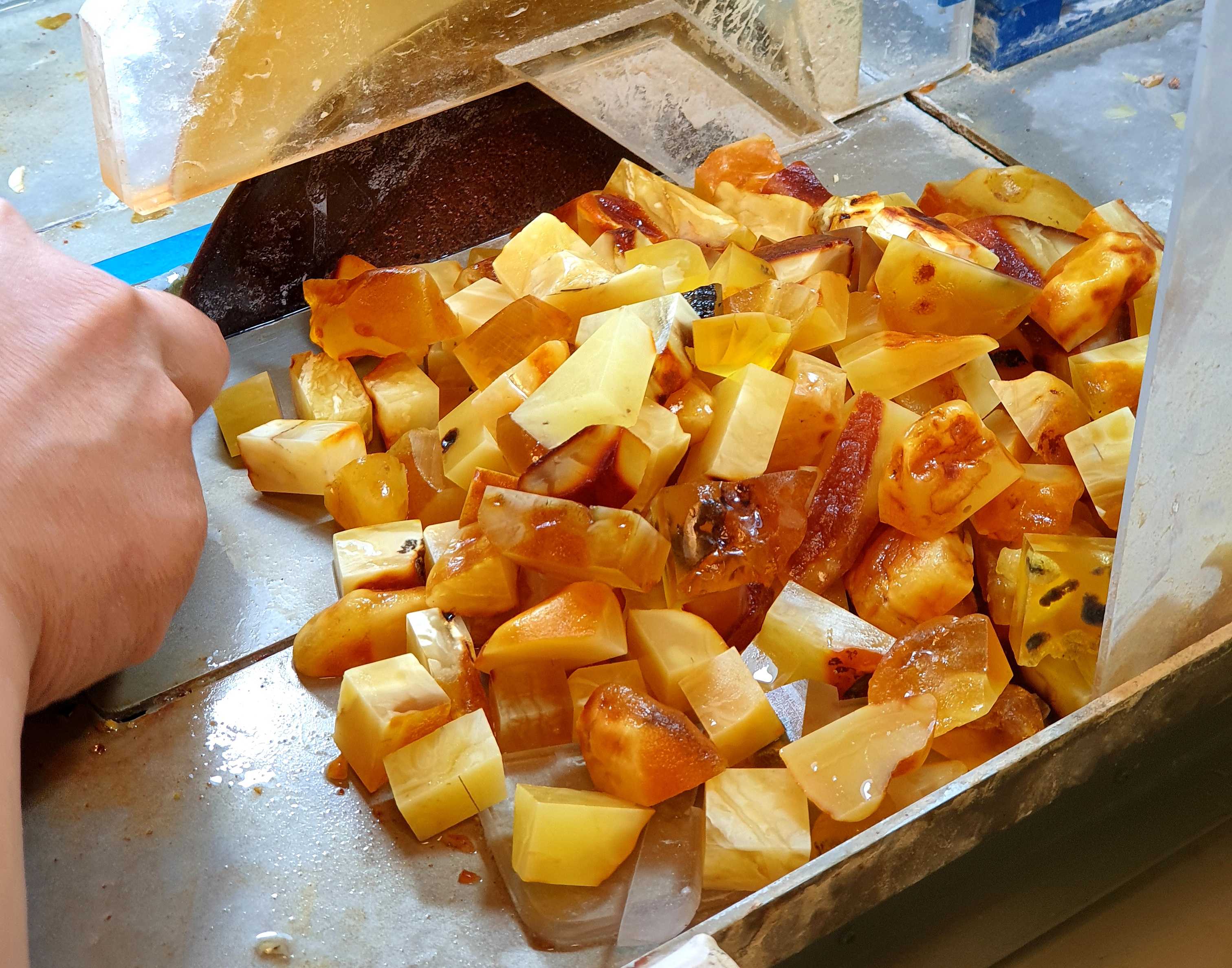
2. Selected stones of raw amber are cut into regular cubes.
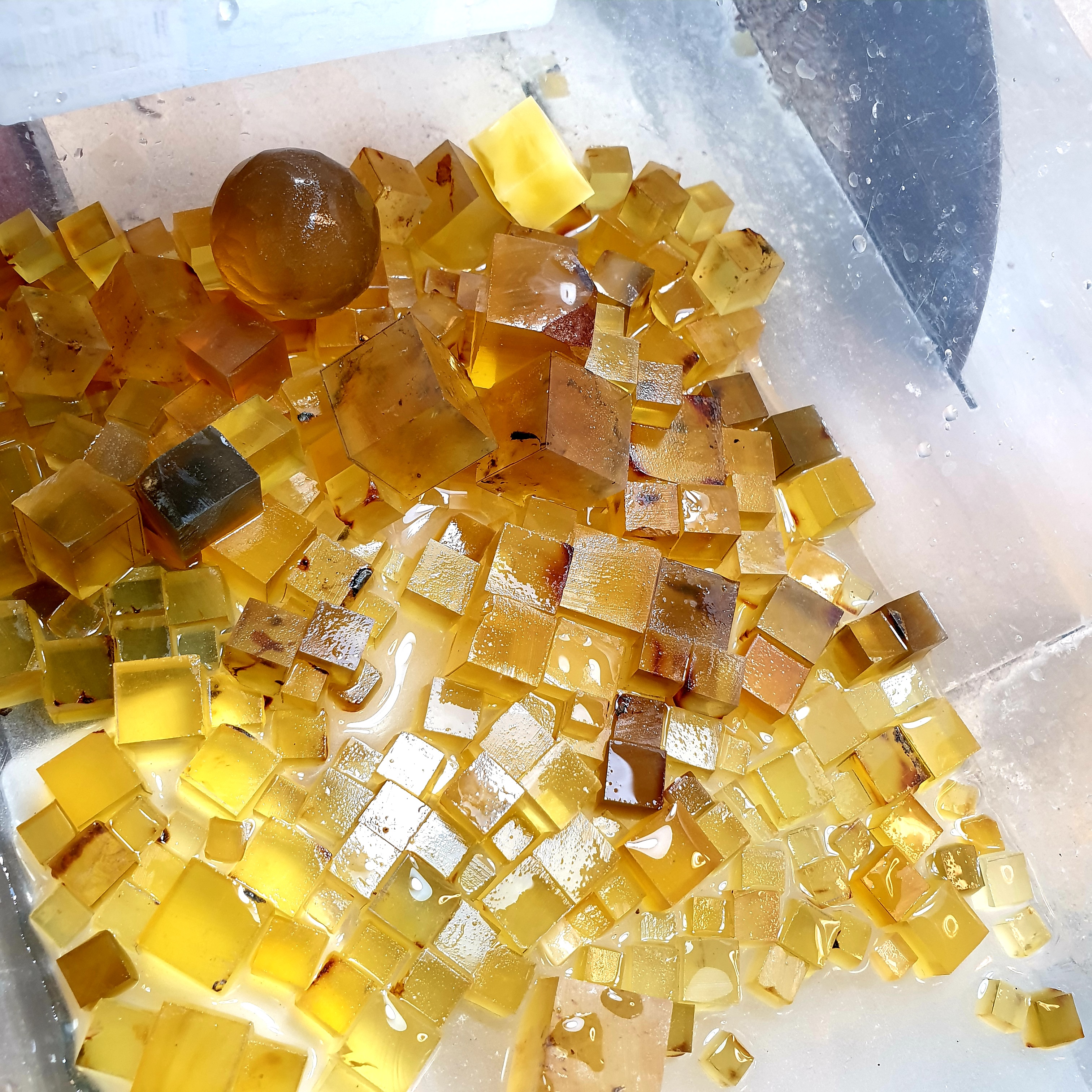
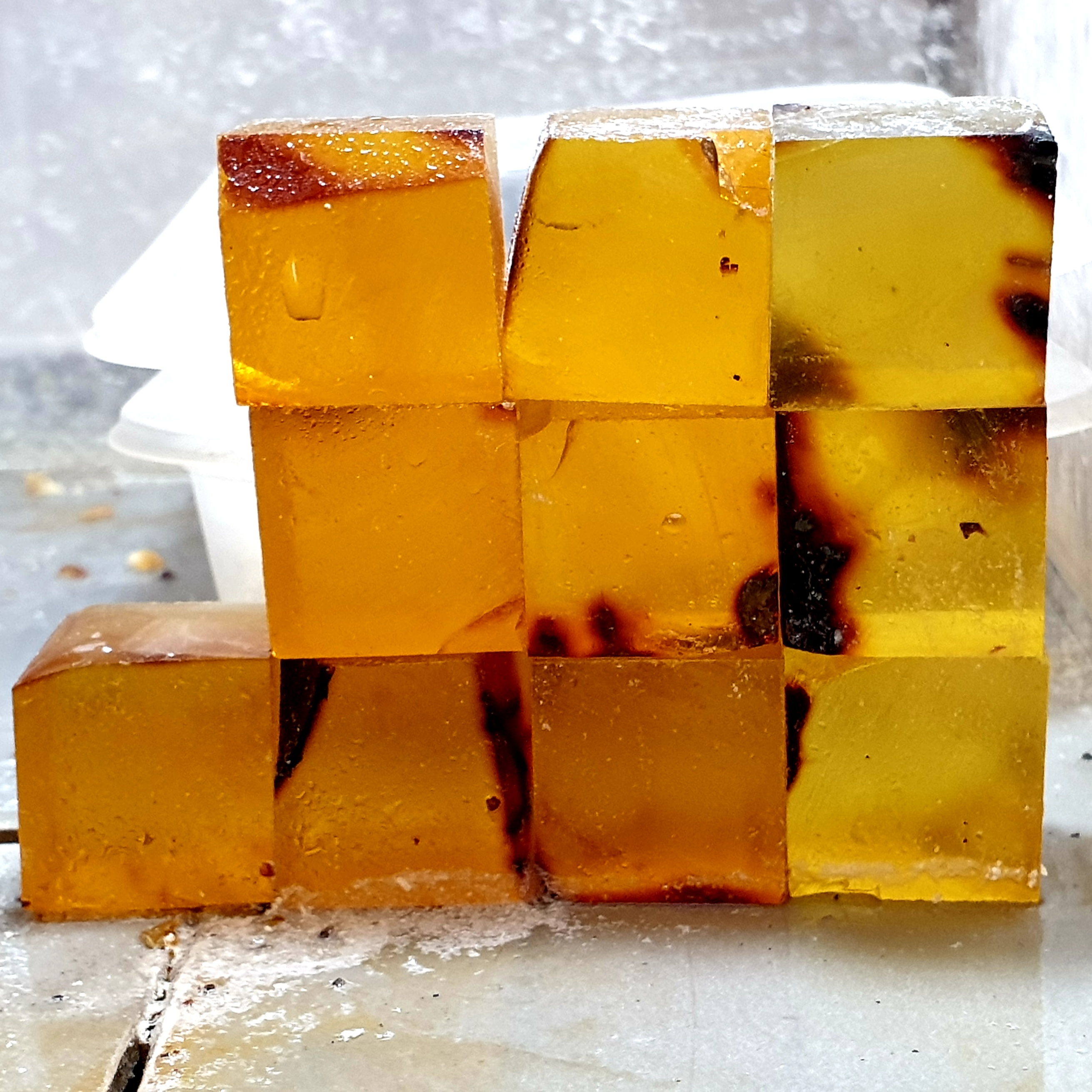
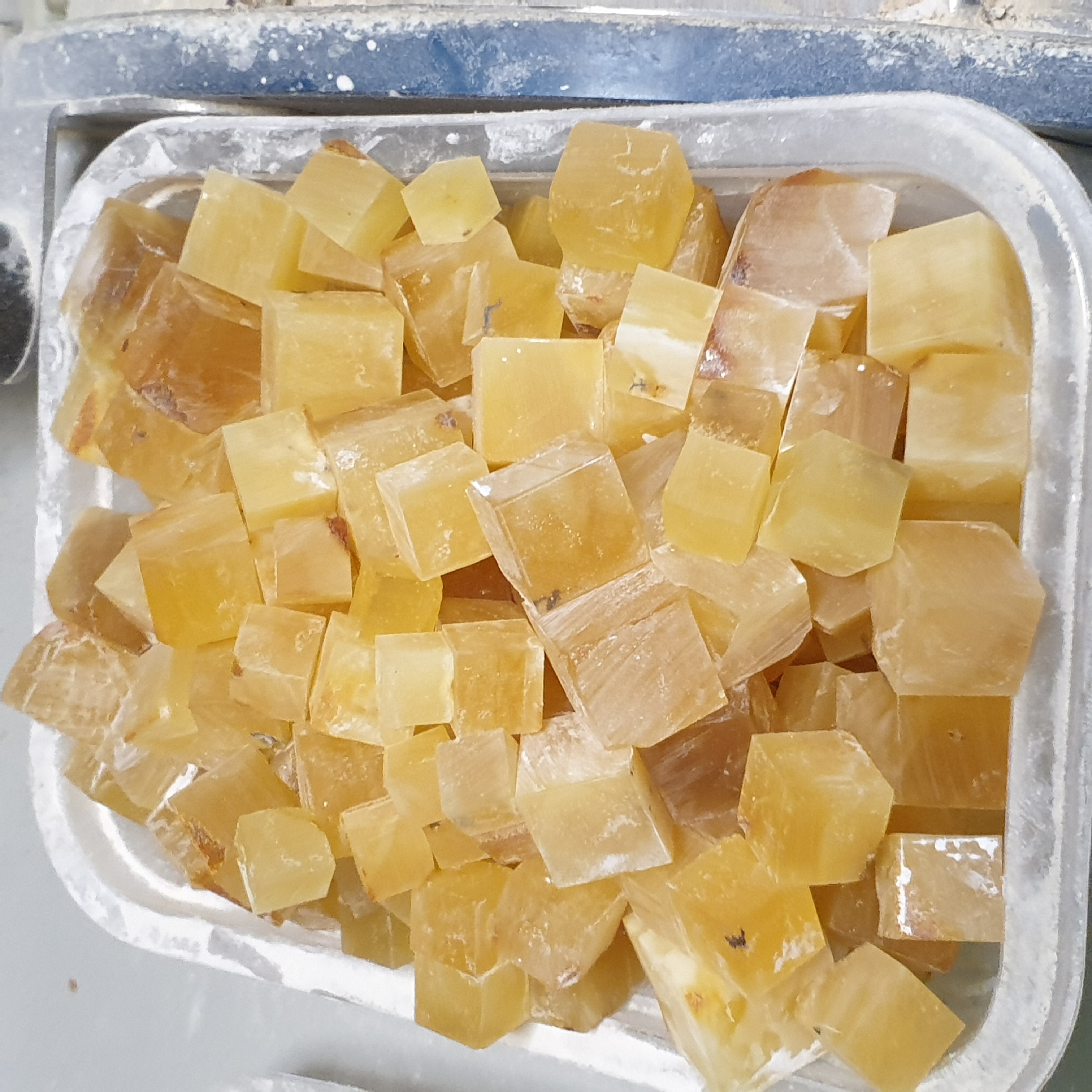
These first two steps are the most challenging. Both on patience and time, but mostly it is about the ability to select the right stones suitable for the beads.
3. The next step is to grind off the edges of the cubes. The larger ones are grind by hand, the smaller ones, usually 9 mm or less in diameter, are tumbled. Some factories, especially those that focus on small beads and use smaller fractions of raw amber, tumble the amber straight away. In this case, however, there is a greater loss of material.
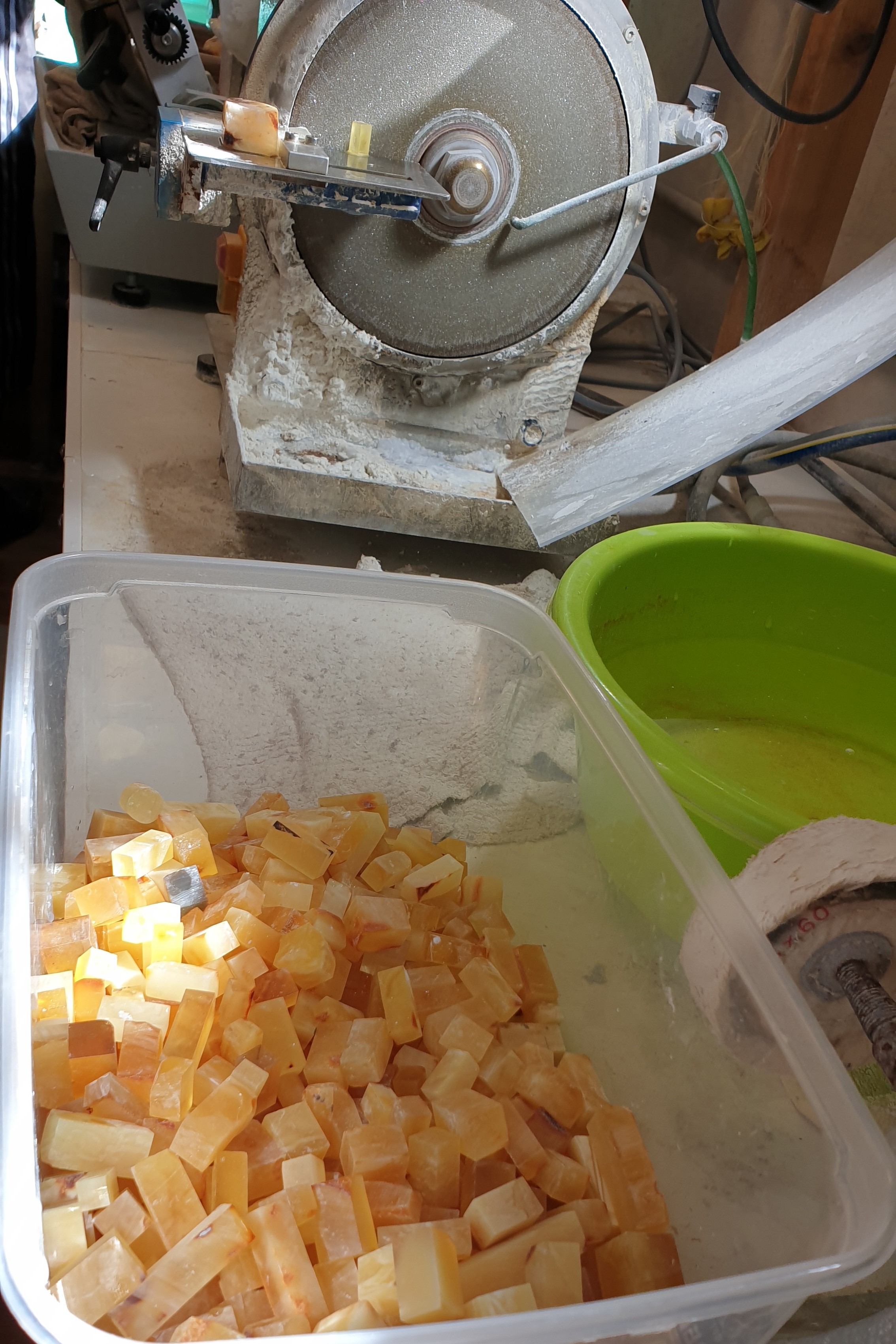
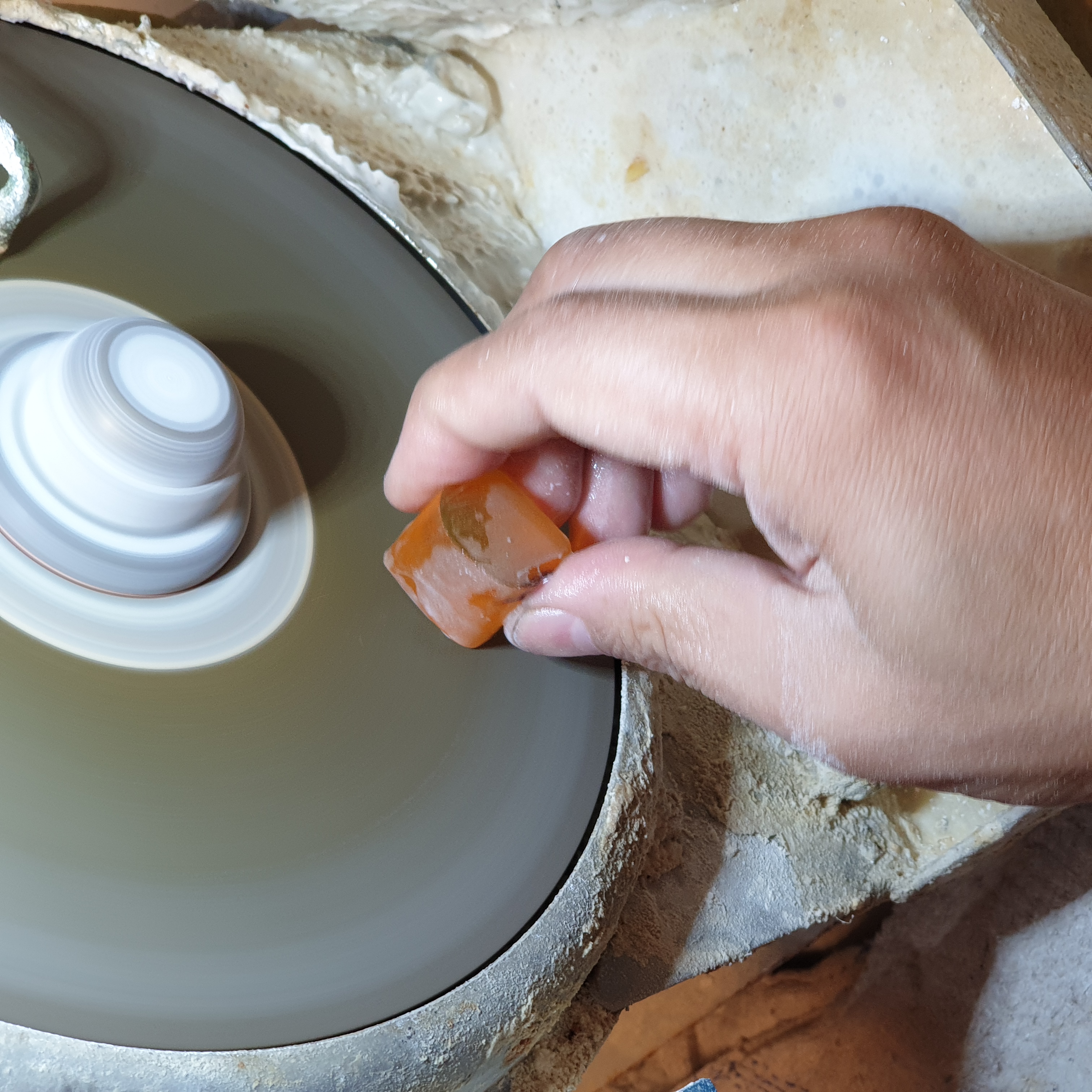
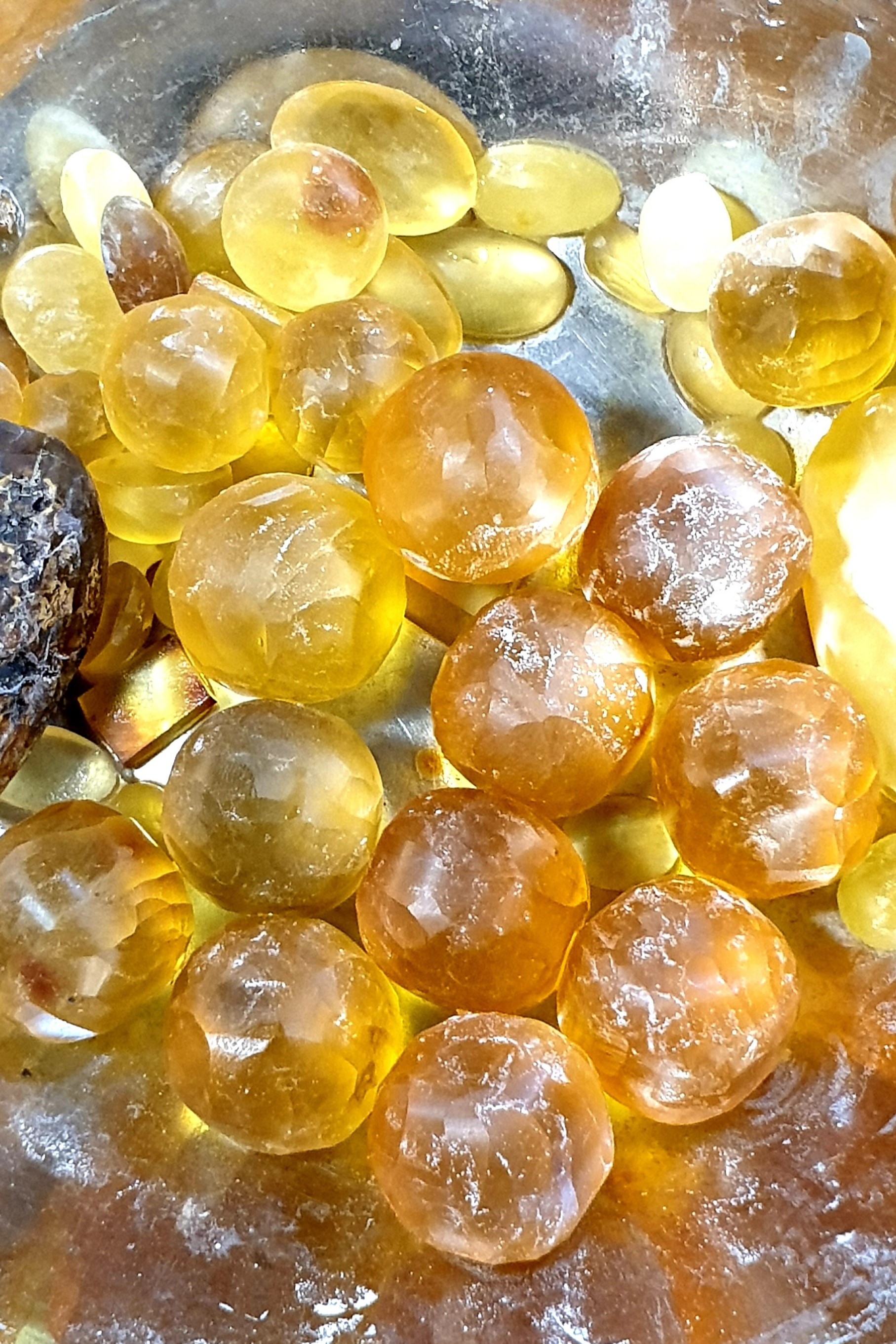
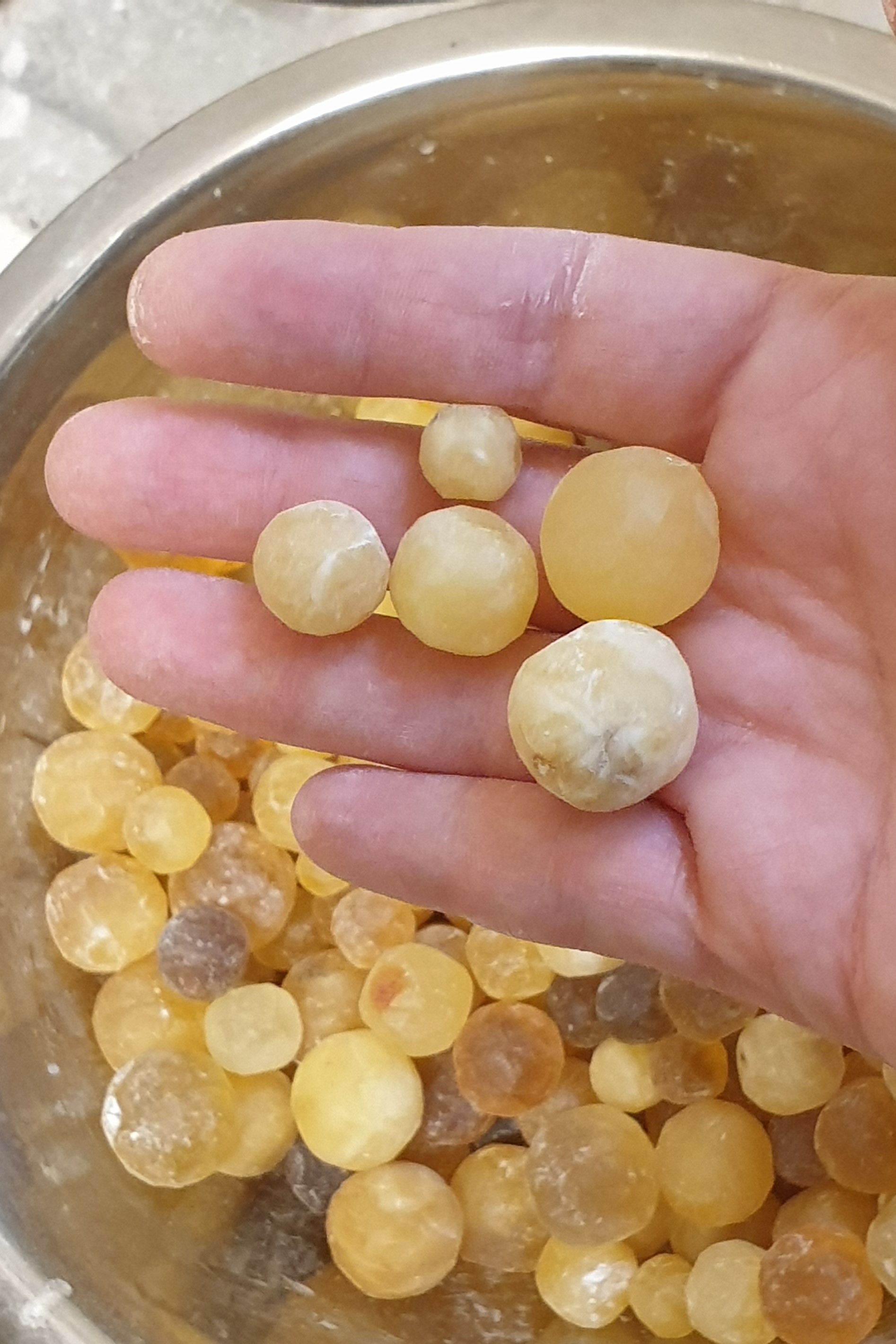
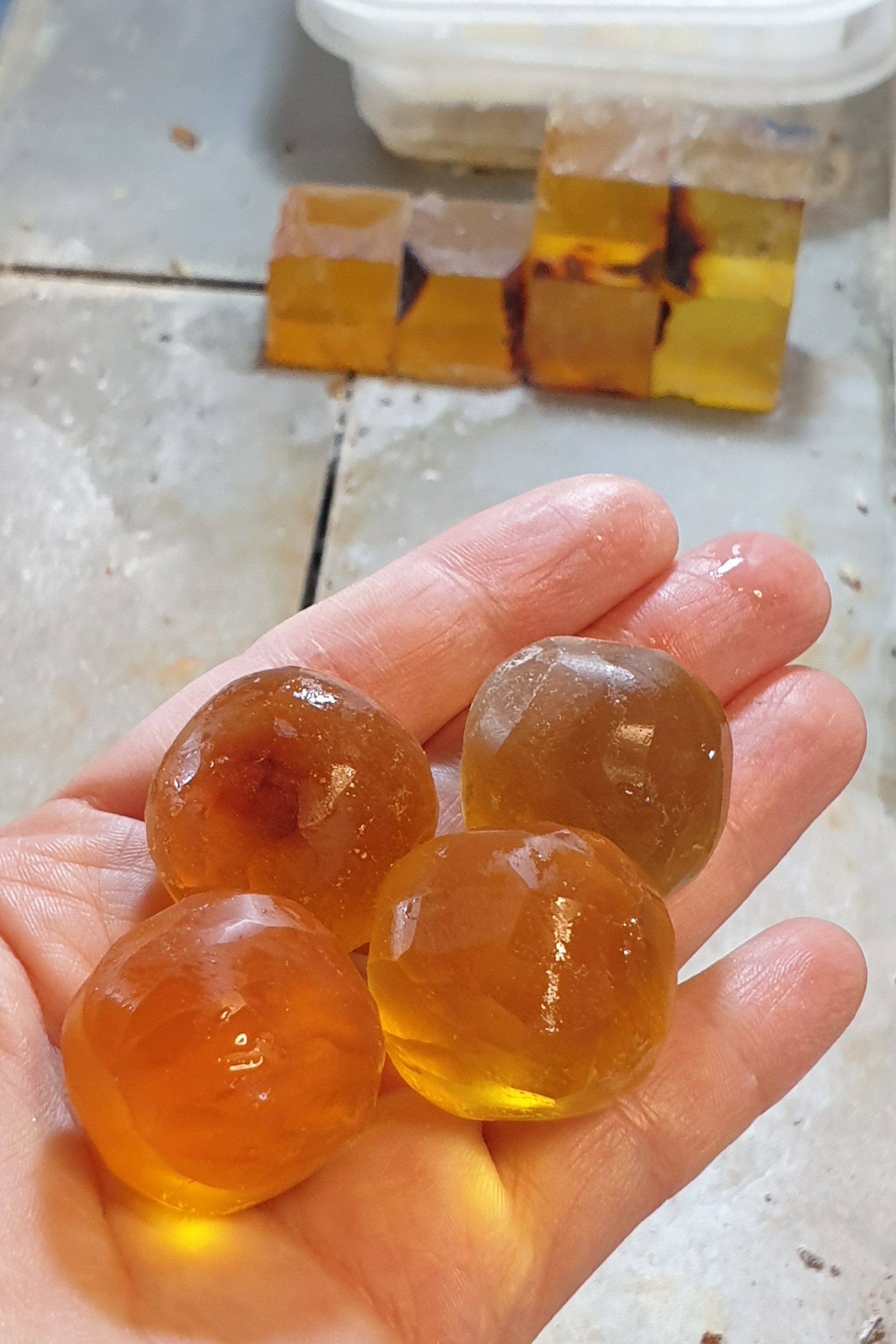
4. Next comes the ball shaping on a special lathe, we call it a ball sizing machine. Here, we shape beads one after another.
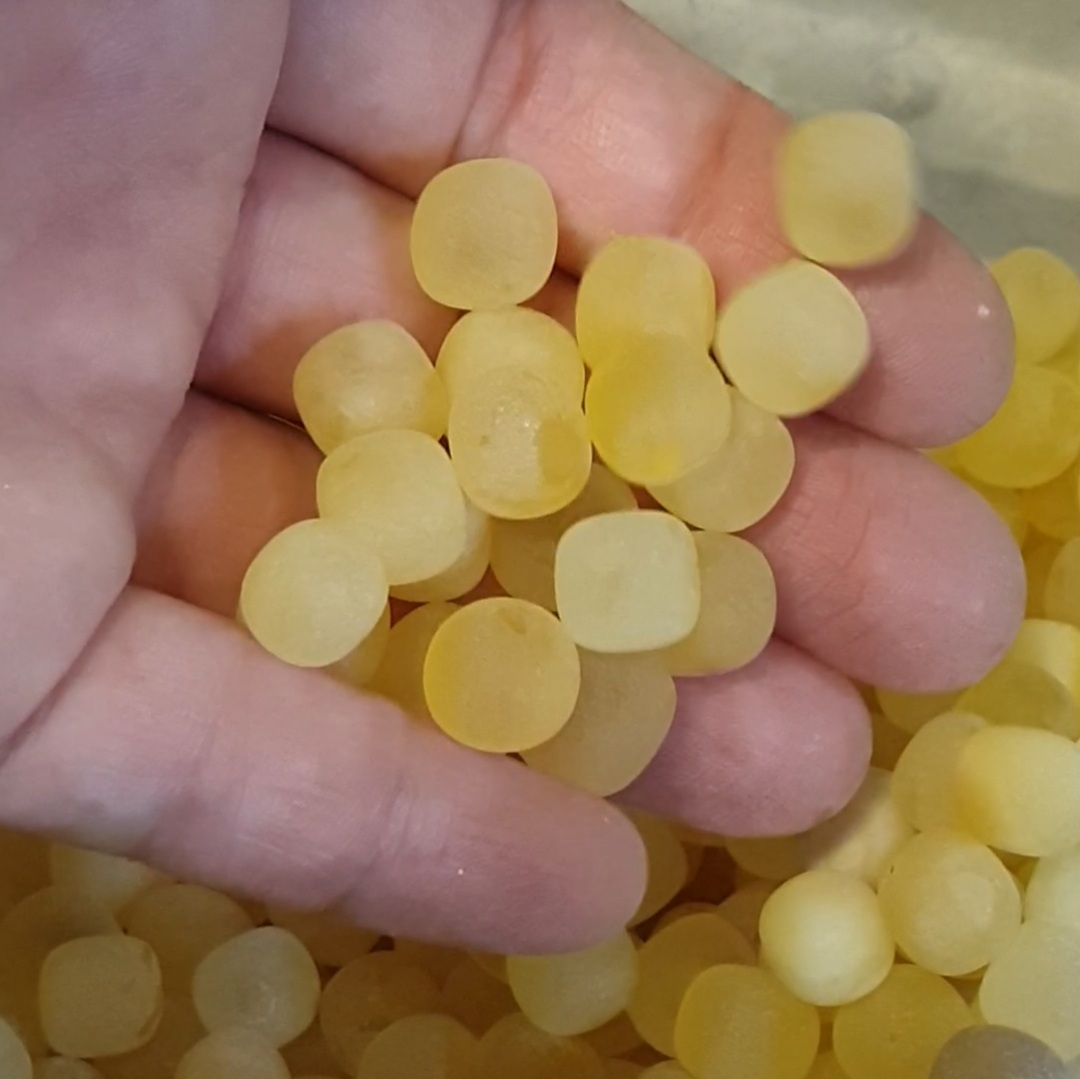
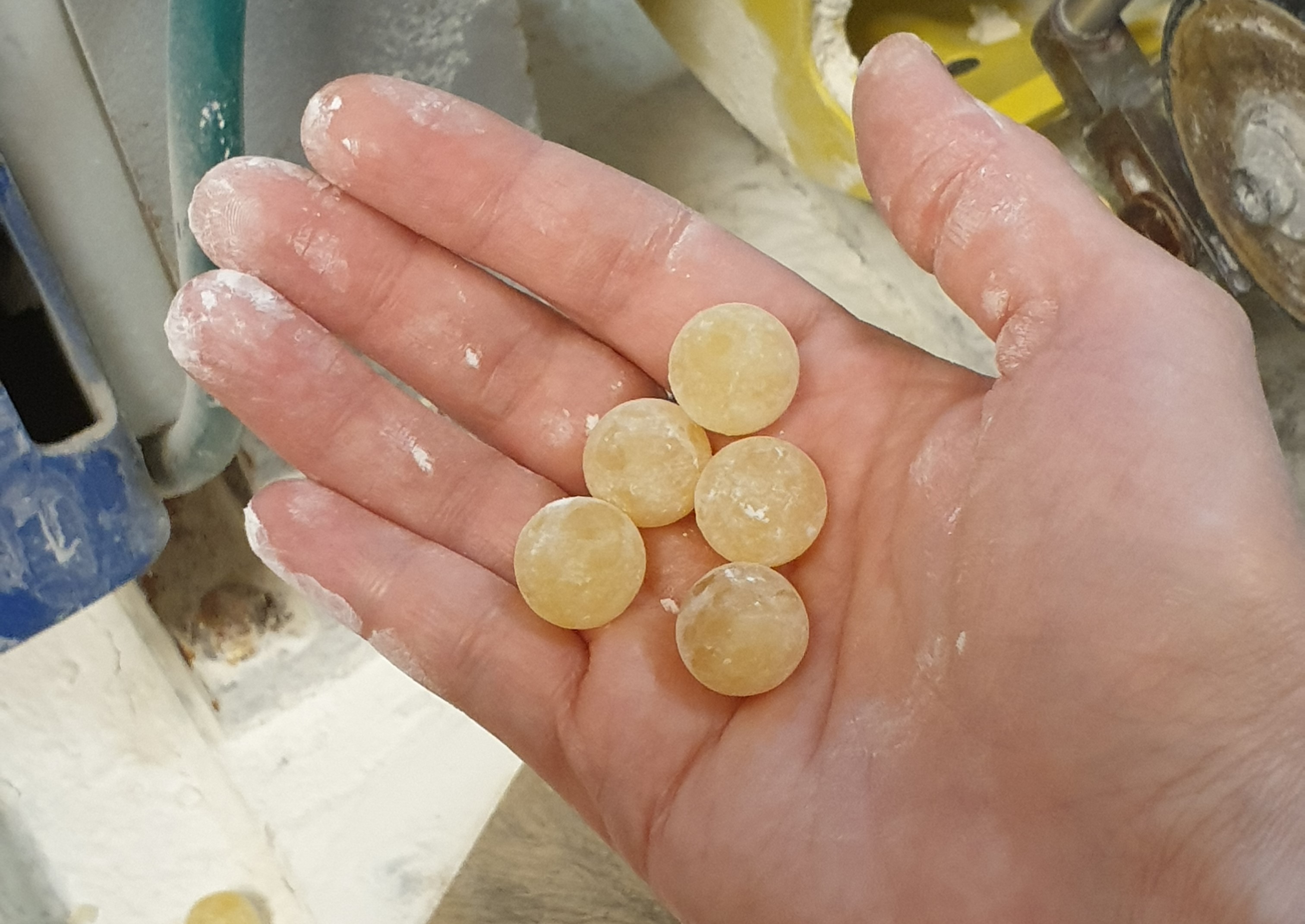
5. Now when we have a nice round shape, we can start polishing. This is a long process that consists of several steps. It will take another day or two to get a nice shiny round bead. Fortunately, this stage is already done in the polishing machines, so we just check that everything is going smoothly. After finishing the main polishing process, we polish the larger beads by hand to get the perfect shine.
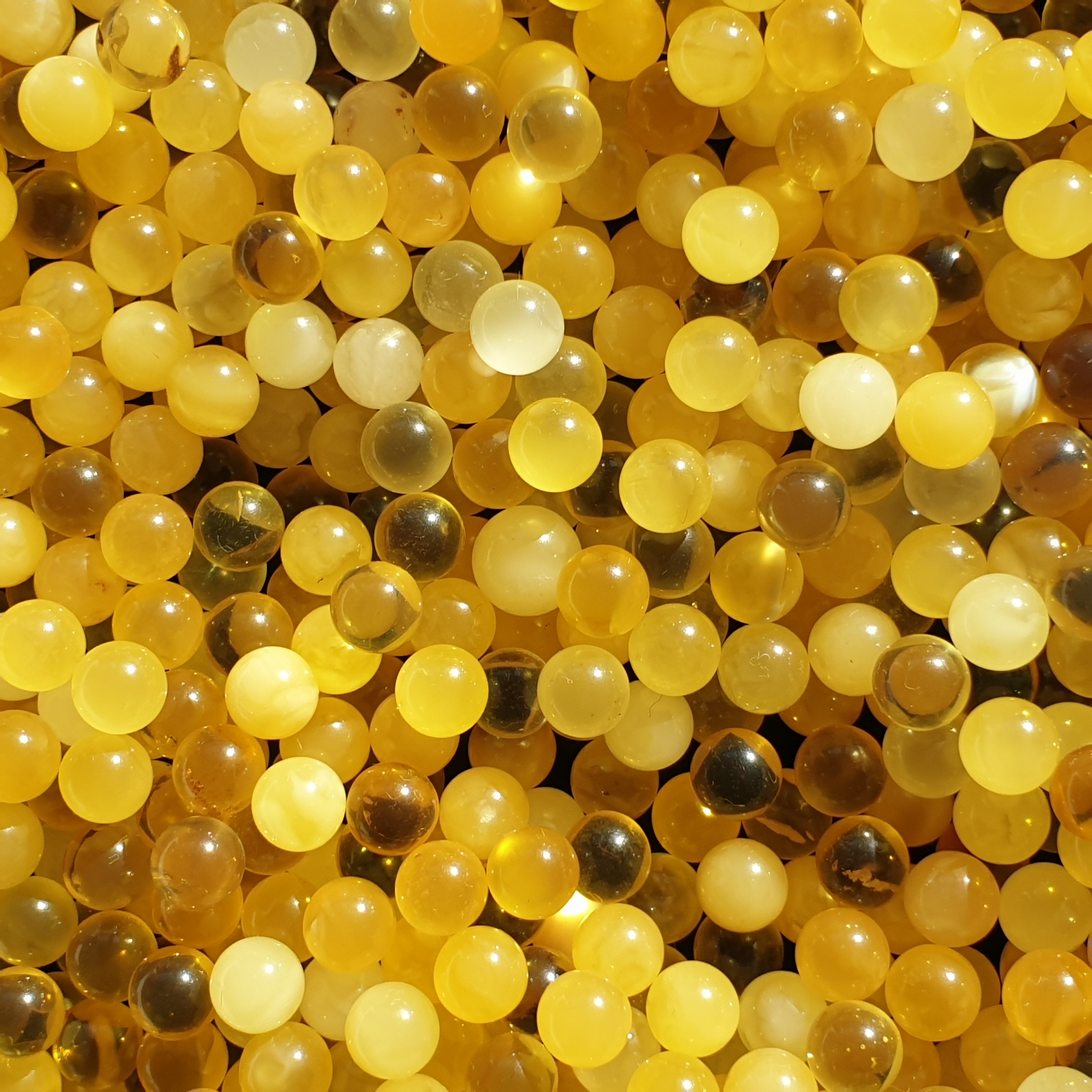
6. My favourite part of the whole process is sorting the beads by size, quality and colour. I carefully check every single bead for cracks or impurities.
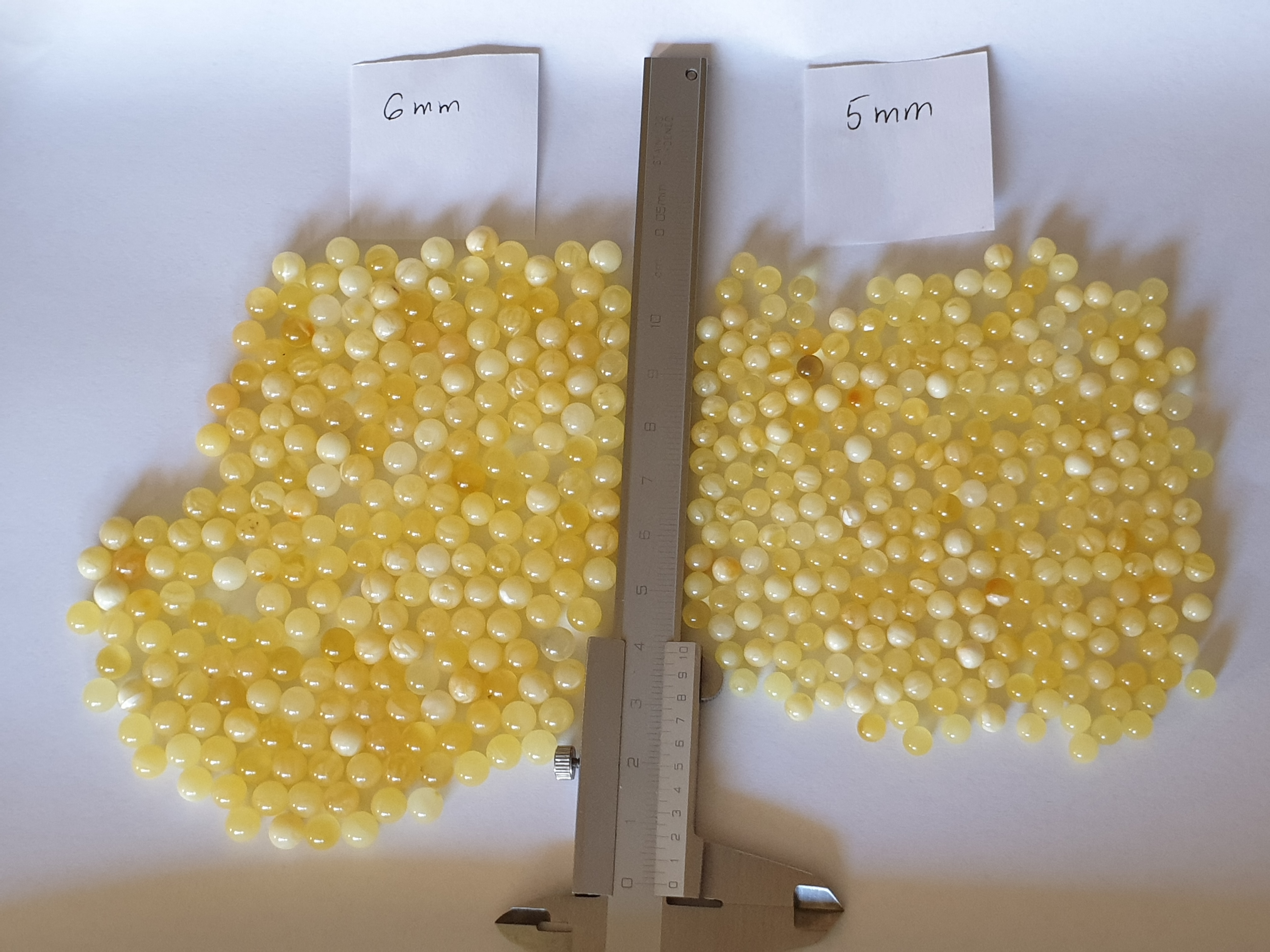
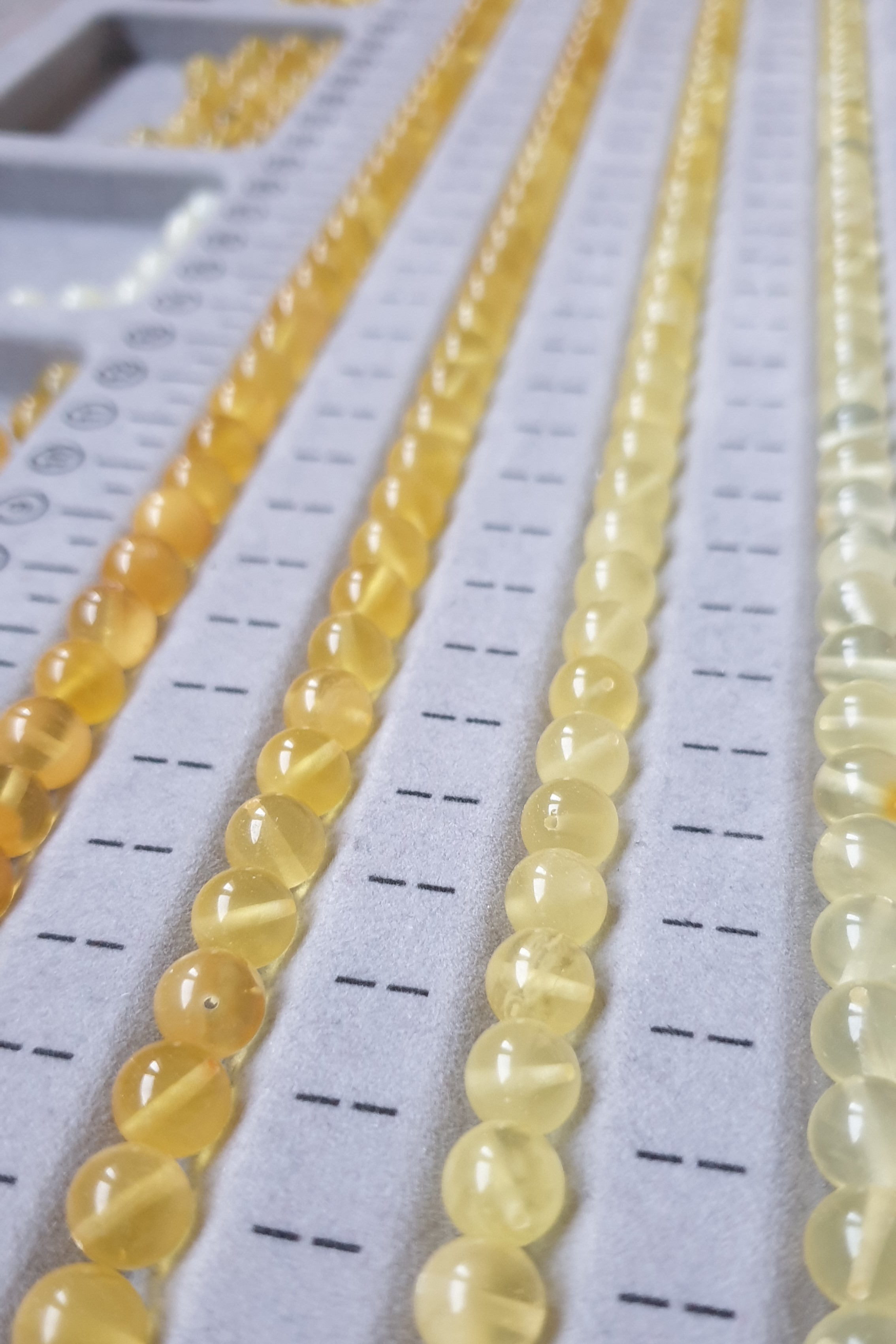
7. Once we have the beads sorted, the pinhole drill comes into play. This is where it sometimes happens that if there is a hidden crack in the bead, it will crack. Once the holes are drilled, we begin to assemble.
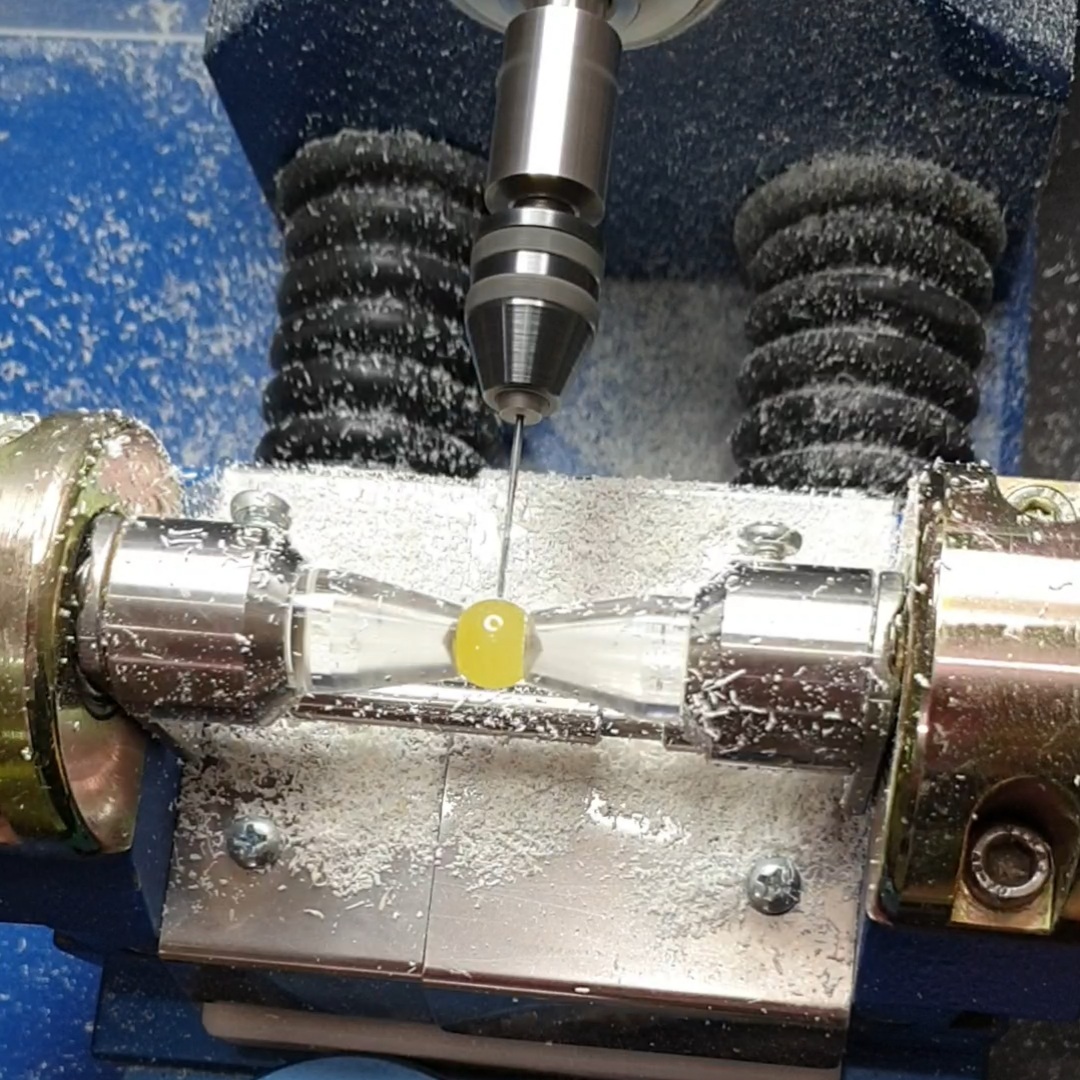
8. In order to assemble ball bracelets or necklaces of a uniform colour, we have to choose from a really large amount of balls of the same size and quality. Especially with large beads, this is quite a challenge, because the larger the amber, the more unique its hue and pattern tends to be. It is harder to find large beads with a similar pattern and colour.
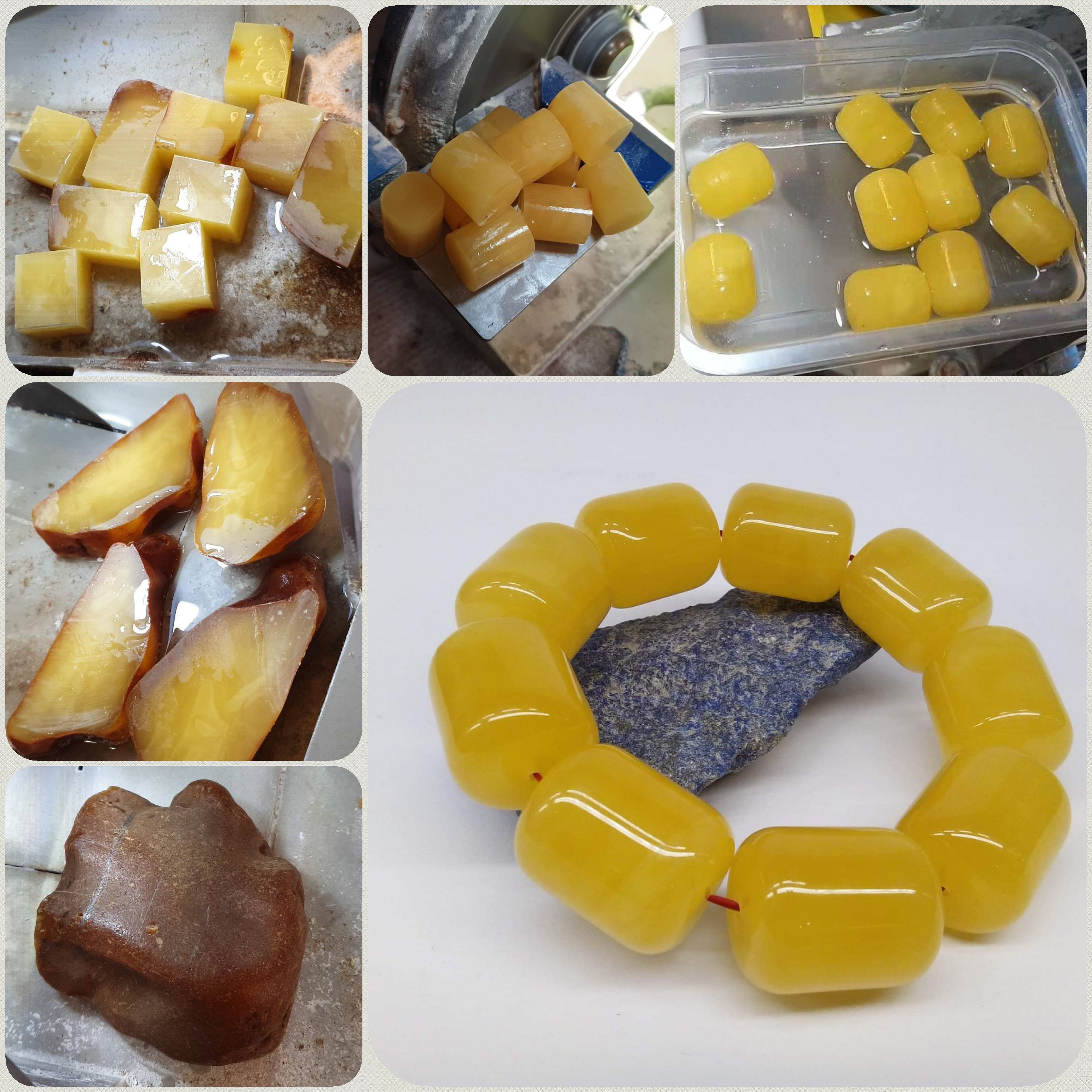
Sometimes customers want a bracelet made of large beads or barrels of the same colour and quality. If they have high standards for a uniform bracelet appearance, there is no choice but to cut one large stone into cubes and grind it into the exact number of beads or rollers needed. However, the price of such a bracelet is much higher than if the bracelet was assembled from beads made of separate amber stones. There is also a high risk of cracks or inclusions hiding inside the large stone. In this case, it may happen that the stone will not be enough for the entire bracelet. Sometimes it's really a lottery.
Amber beads are not only made into bracelets. From earrings, rings to pendants and necklaces, you can make beautiful sets out of them.
You may have noticed that I've mentioned the quality of the beads a few times. In some of the next articles, we will show you how to check the quality of amber and how to distinguish cracks from the pattern of the amber stone.
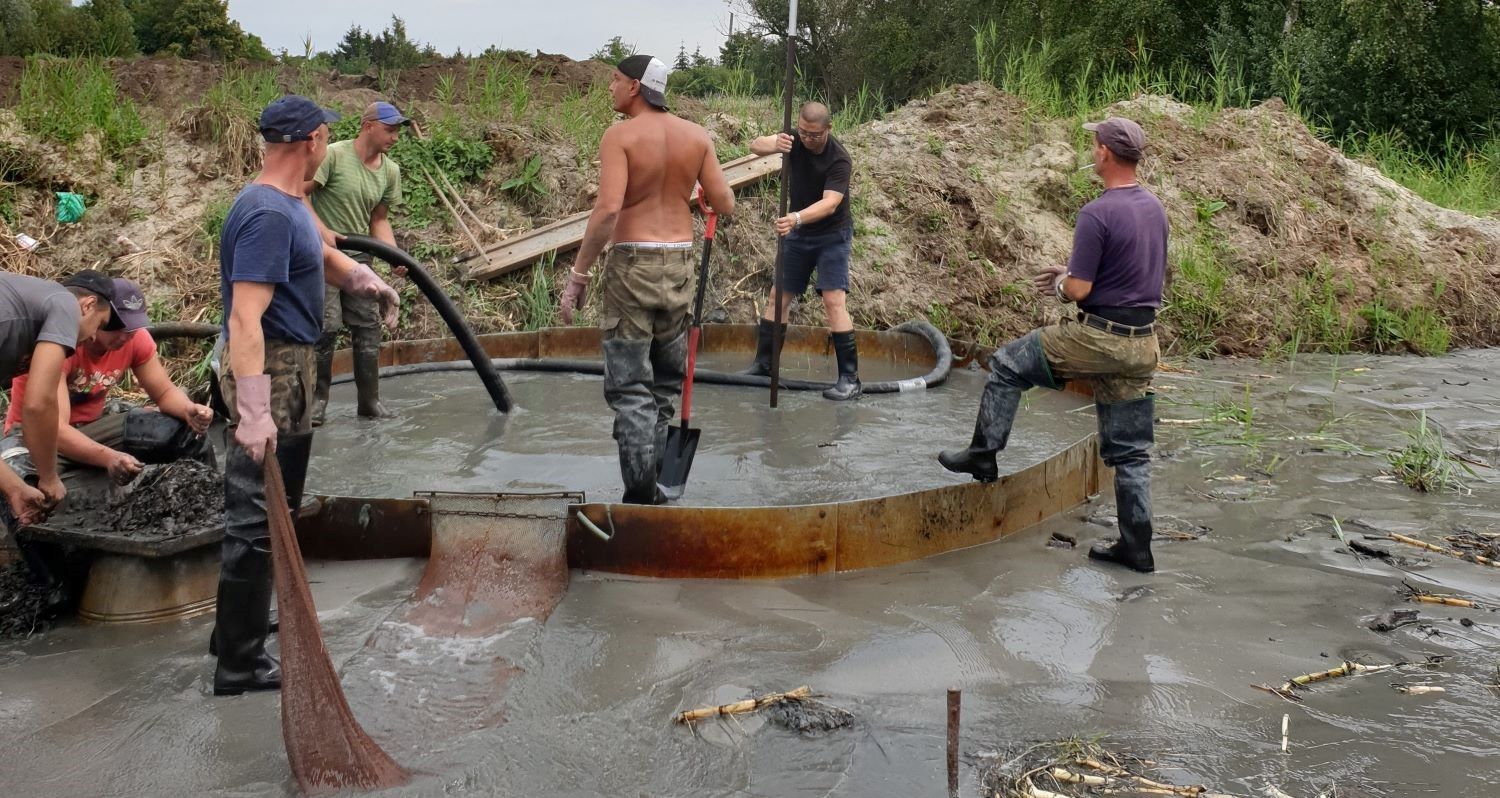
We always wanted to find a nice piece of amber on the seashore. Every time we go to the Baltic, we stay as close to the beaches as possible so that we can go straight to the sea in case of a storm. You might think that only a fool looks forward to a storm by the sea, but anyone who wants to find amber on the beach has to endure the discomfort of stormy weather. One morning we were awakened by thunder and lightning. It was a nice storm, so we already knew it is a great opportunity. We must get out as quickly as possible! Even me, for whom getting up early in the morning is the worst punishment, got dressed in a flash. When the storm had died down a bit, we ran to the beach and embarked on a little adventure. We dug through washed up twigs, shells, rocks and sand. But nothing... Except for one tiny amber grain, we found nothing. The storm wasn't strong enough, and there were already a few searchers on the beach ahead of us. At least we got to enjoy the sunrise.
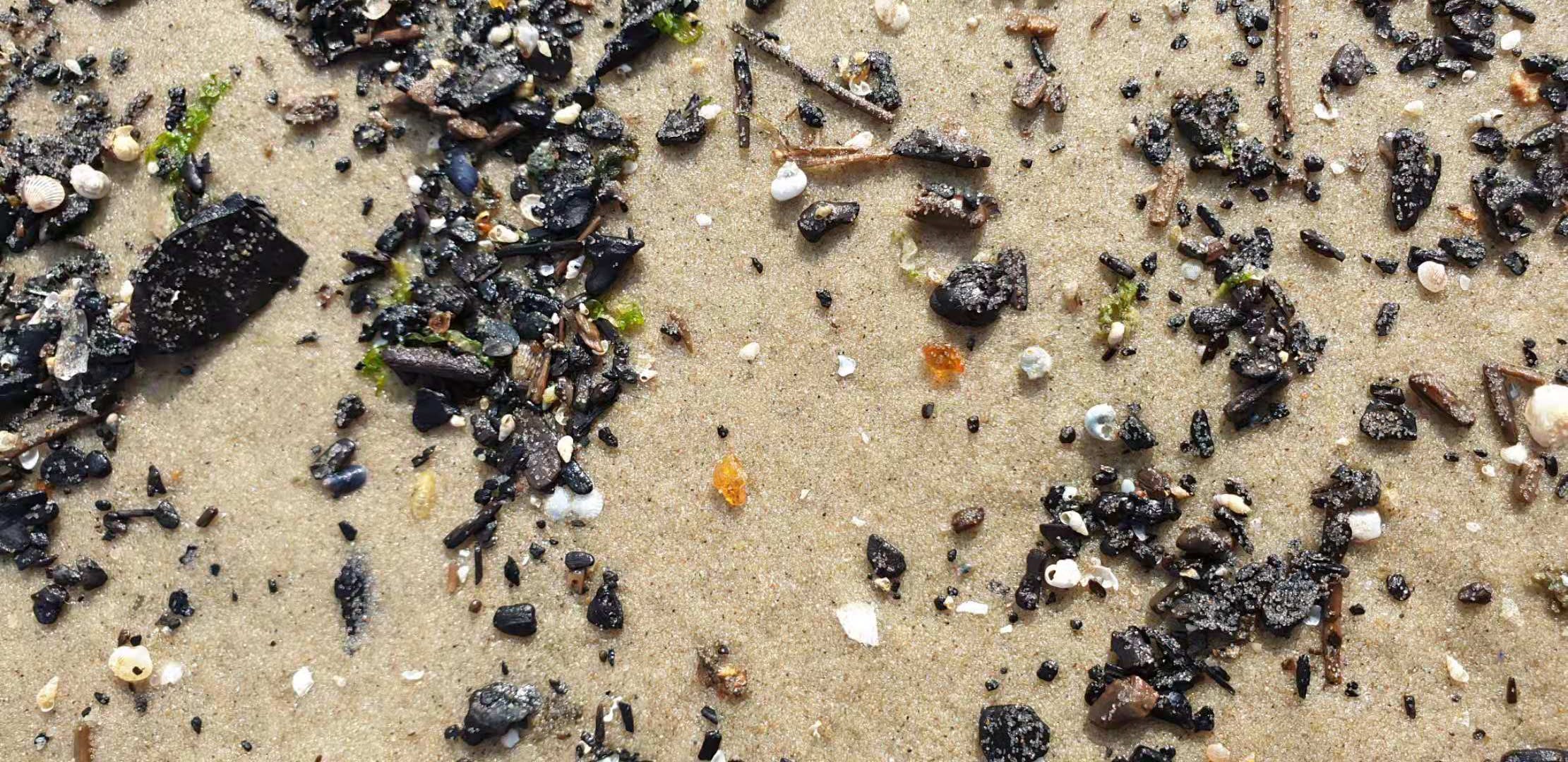
Photo: These tiny bits of amber really do look like little teardrops washed up by the sea.
Later, a friend who lives in Gdansk and lives near the sea explained to us that now the sea does not wash up so much amber. And if it does, it's just small grains. Larger pebbles either get caught in fishing nets or the sea washes them out only during really strong storms, the ones of a kind that break the trees. That's when the branches and seaweed in which the larger amber stones are trapped are washed out of the sea. But storms that strong tend to happen in late autumn or winter only. That's when the locals come out with torches and buckets. Regardless of the bitter nor'easter and frost, everyone is searching. Nowadays, when the price of raw amber is high, tens to hundreds of people are on the seashore after such a storm. Of course, everyone is trying to hunt for some amber stones, but they are getting scarce and the searchers are getting more and more numerous...
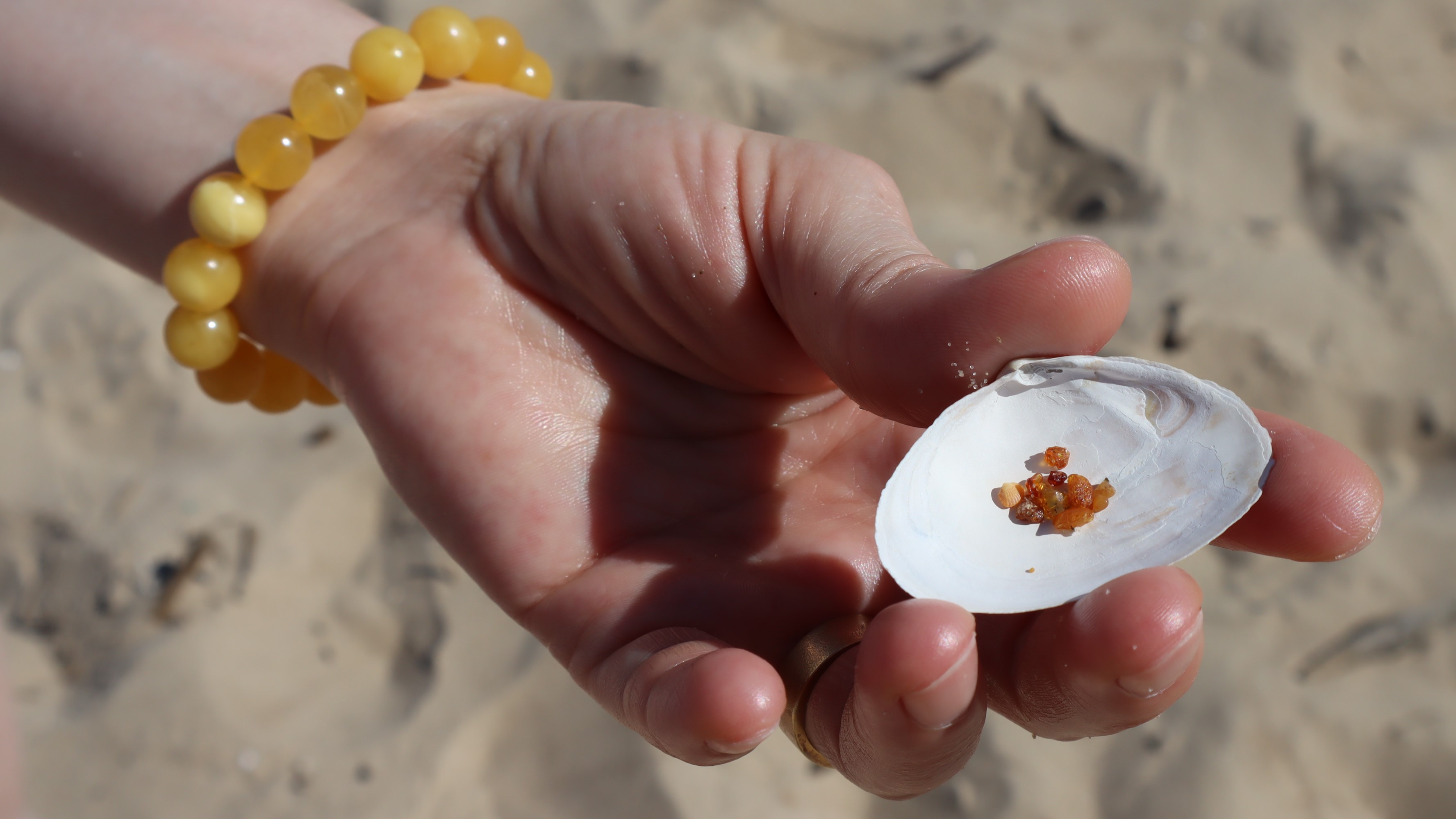
Photo: This is probably the biggest catch we managed to collect at ones
Today, amber from the sea is becoming more of a rarity. If you have a different experience, please, tell us where to find the best seashores for amber hunting.
Most of the raw amber sold on the market is mined from the ground. So, if we couldn't get it from the sea, we were lucky to get it on land. A friend of ours has a licence to amber mining. For a long time he walked around a field which he knew was a rich deposit, because he used to mine in its vicinity before. Finally, after two years of dealing with all sorts of permits, he was able to get to work and we could experience how amber is really mined.
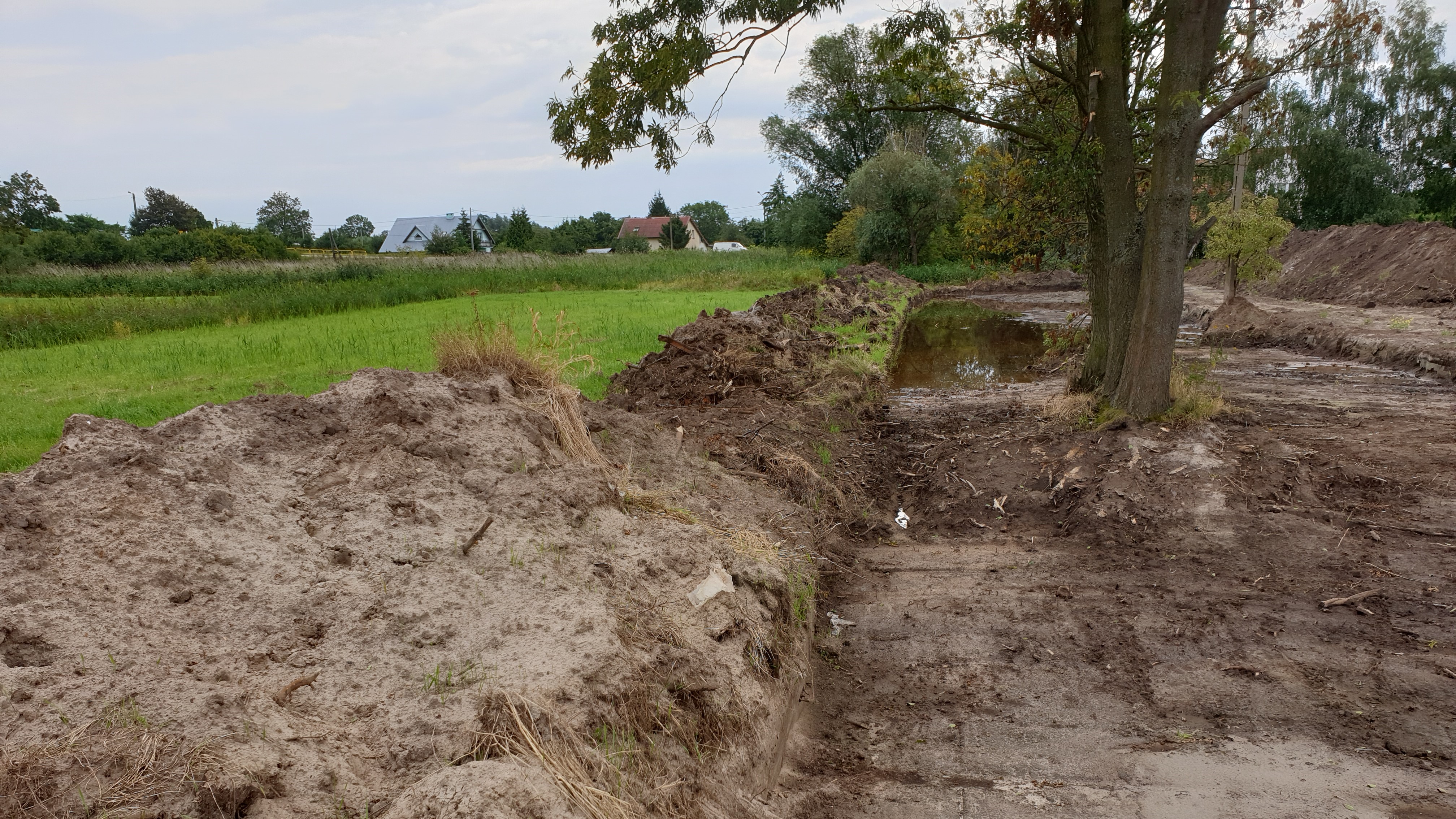
First, the topsoil in the field has to be removed. It's done in strips. Once the mining has been done, the topsoil must then be returned to its place and reclaimed.
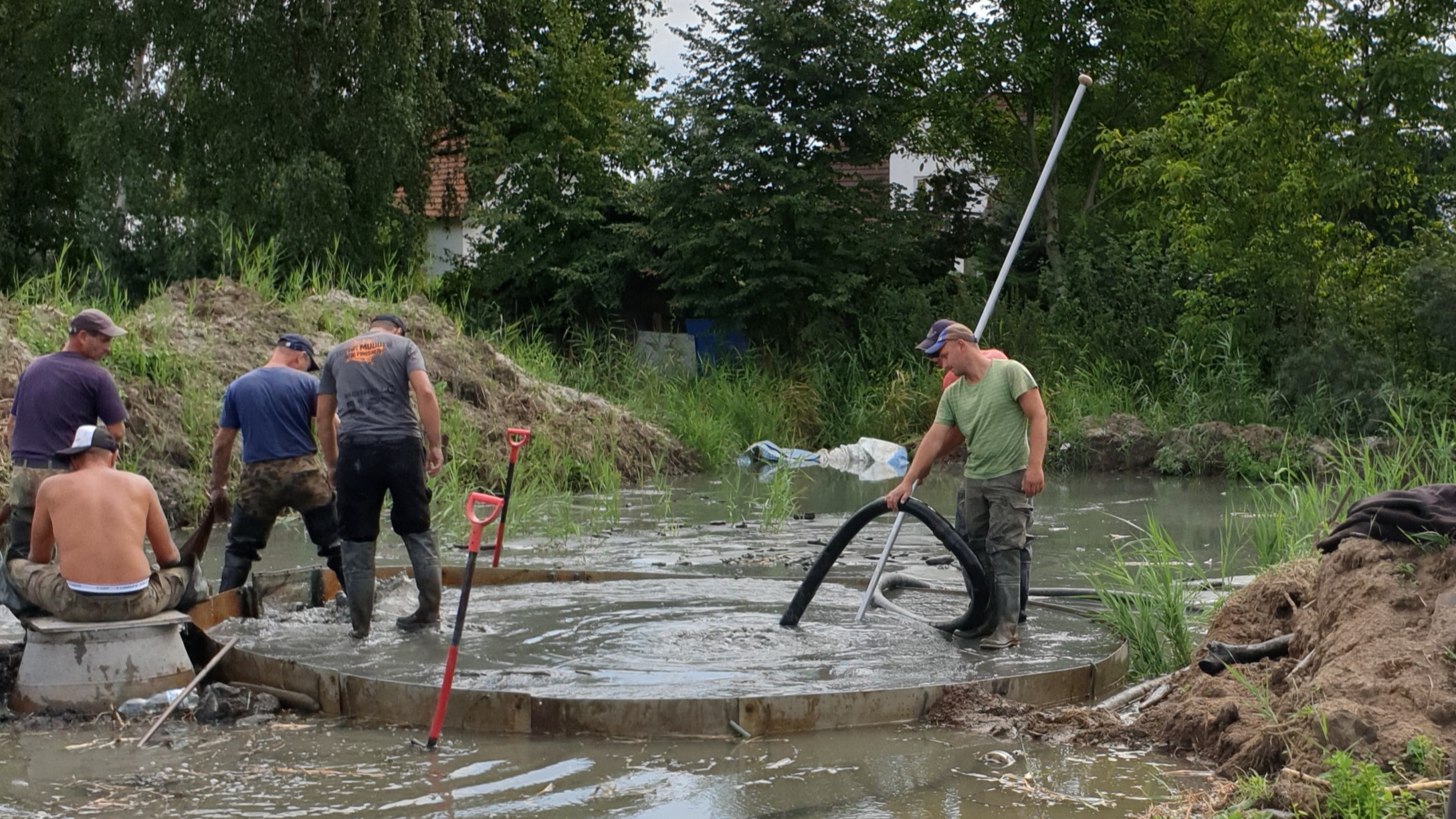
Where the topsoil has been raked, 'wells' of about 10 to 20 metres deep are then dug bit by bit. First, a metal hoop is placed on the ground. A hole is dug in the middle of the hoop with a steel rod about 20 metres long. At the same time, a strong stream of water is forced into the hole. The soil is sandy, so it works quite well. The flow of water loosens bits of wood, grass and stone from the deposits and they float to the surface.
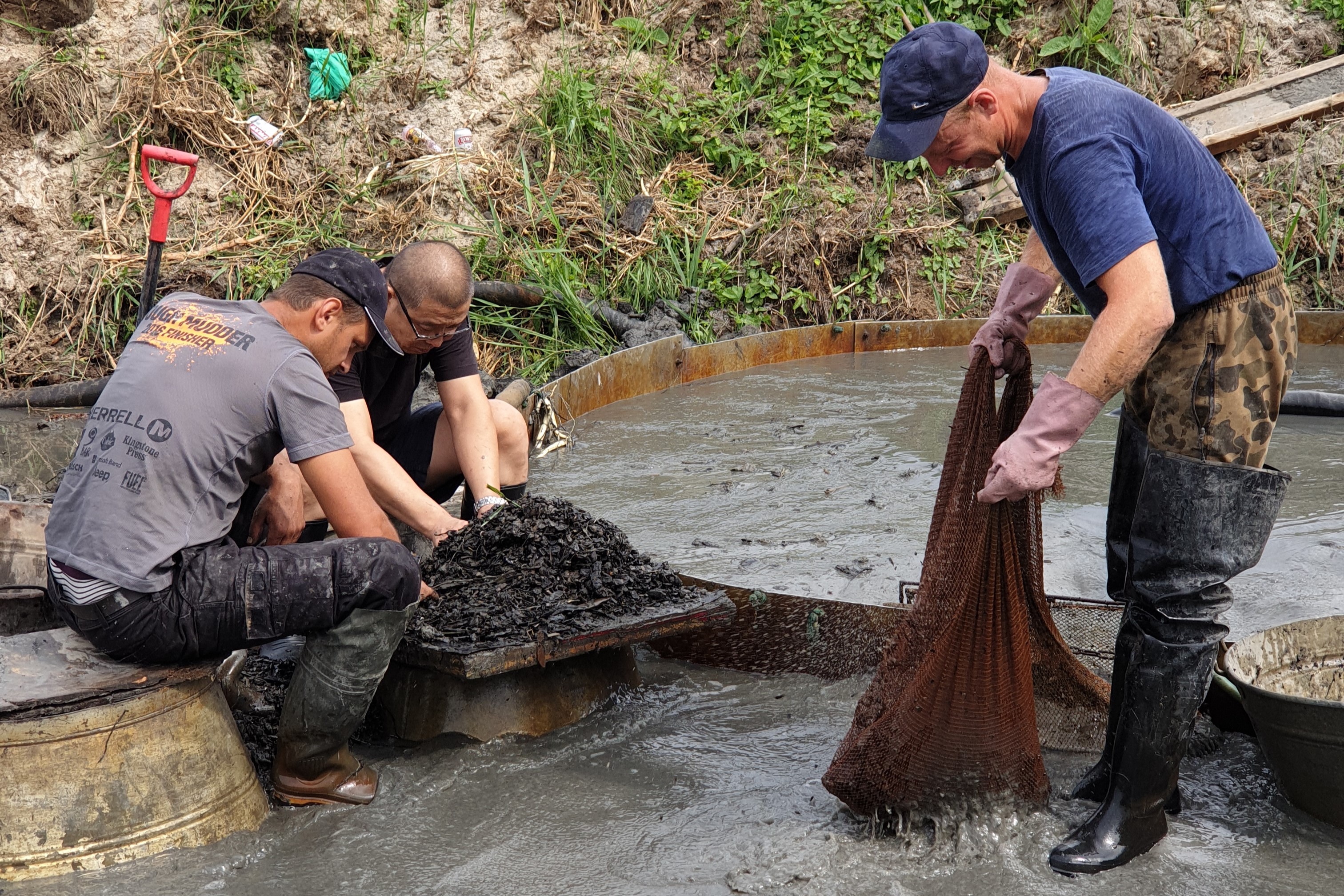
Everything is captured in a large net at the mouth of the hoop. From the net, the contents go into smaller nets where the initial sorting takes place.
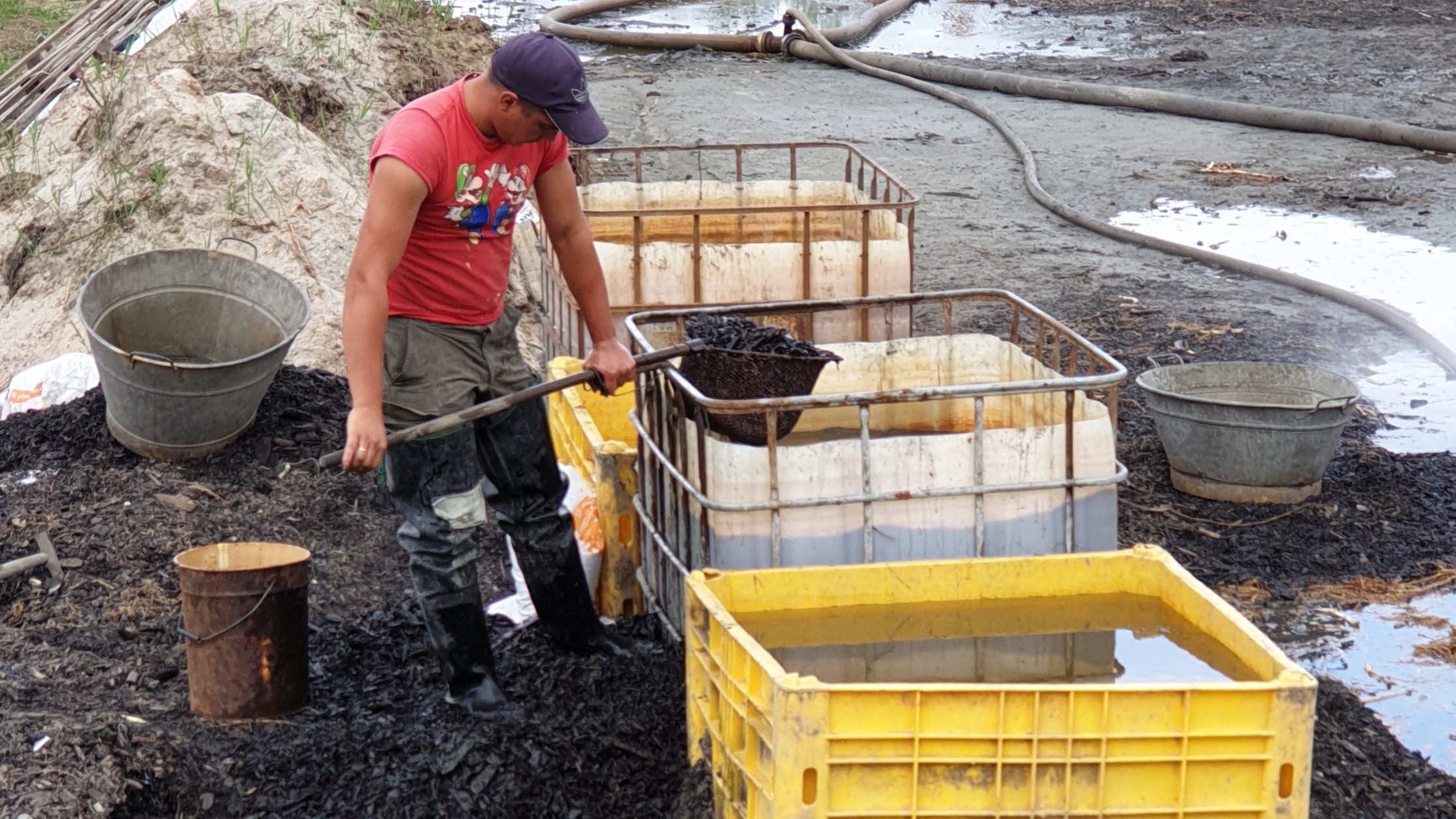
In the next step, the contents of the sieves are dumped into large tanks of salt water. The amber is light and floats to the surface in the saturated salt water. In contrast, grass, roots and stones sink to the bottom.

A further sorting and cleaning process follows. Here the miners use sieves. Amber stones are sorted according to size into several categories, from grains weighing 1-2 g to amber stones weighing over 100 g. Of course, the tiny stones are the most numerous. To give you an idea, out of 500 kg of raw amber there are only about 10 kg of stones weighing over 20 grams. And the larger ones, over 100 grams, even less than that.
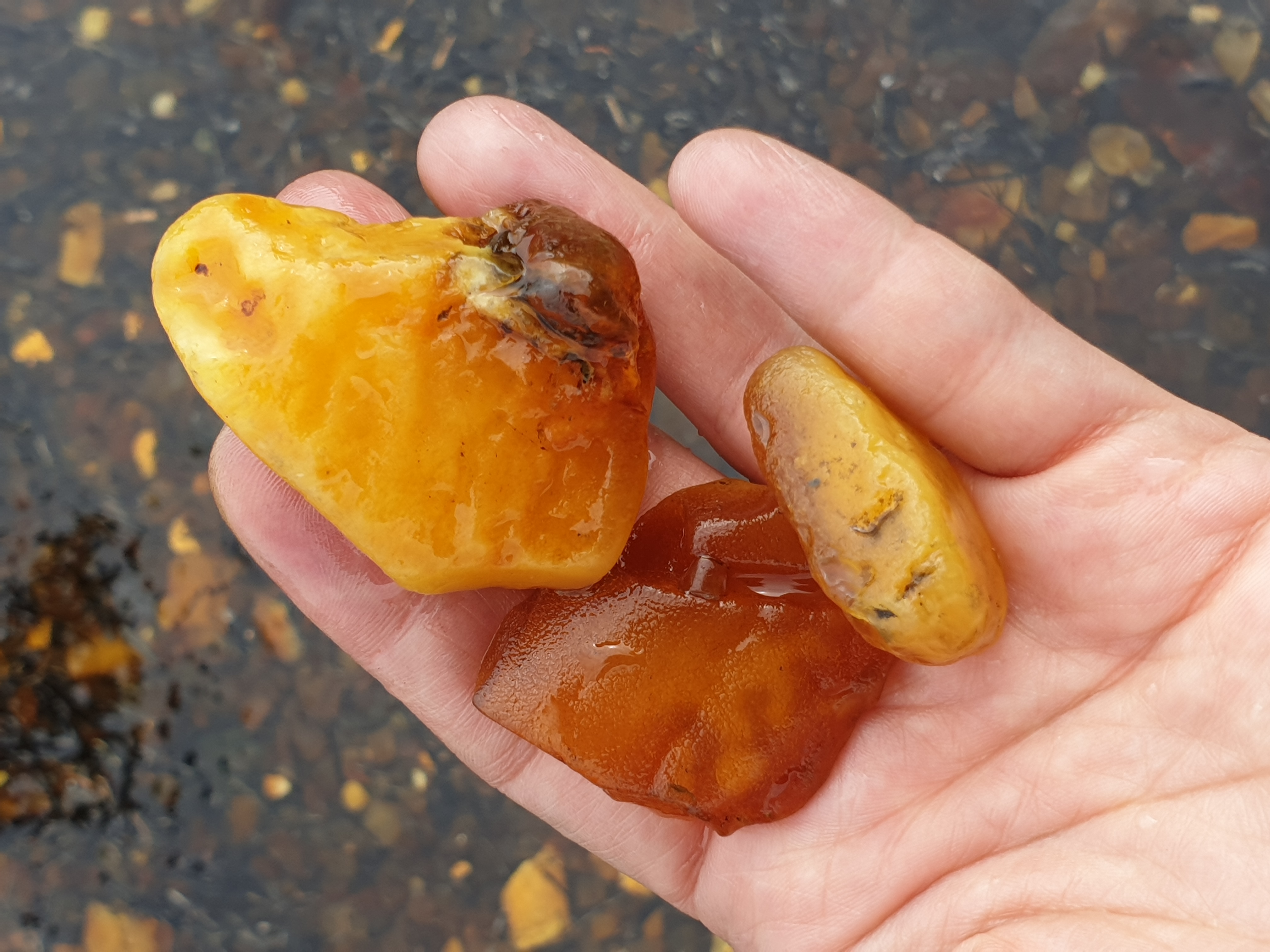


Amber mining is pretty tough. In the end, my husband and I agreed that we would rather craft raw amber and leave the mining to the experts.
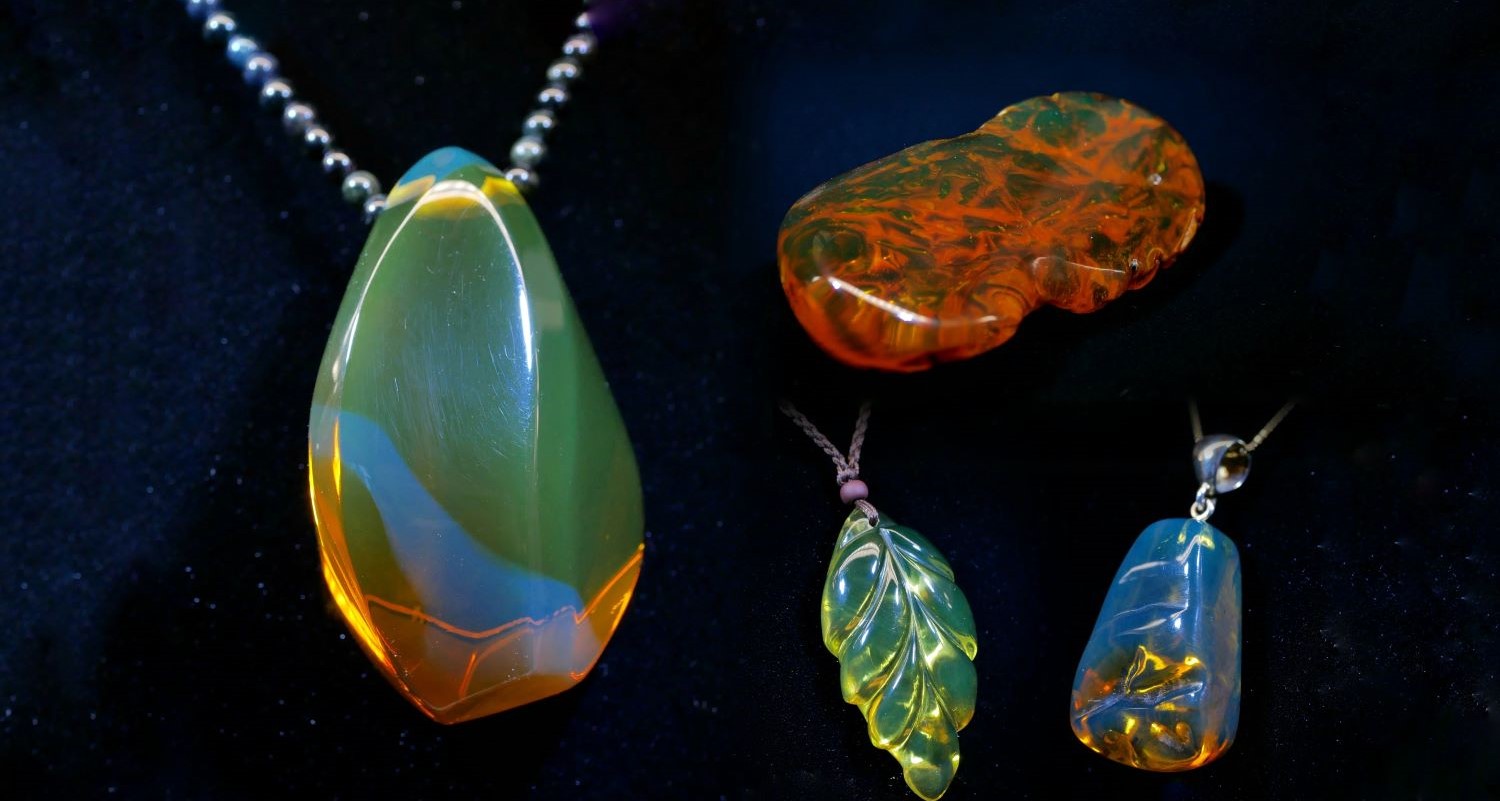
Sun-drenched sandy beaches, coffee, rum and cigars. That's probably the first thing that comes to your mind when you think of the Dominican Republic. But there is also another treasure hidden - the amber.
Christopher Columbus and amber
For centuries, the original natives of Taíno people have used amber as an ornament. When Christopher Columbus anchored off the coast of Hispaniola for the second time in 1493, he made a lucrative trade with them. He gave the chief of the tribe a necklace made of Baltic amber and in return received a pair of shoes decorated with local amber. He was captivated by the colour of the amber. He tried to convince the other conquistadors that the island held many treasures, not just gold. But the lustre of the gold was more appealing, and for the next four hundred years it became a major export. Meanwhile, amber was forgotten. It was not until the Baltic amber supplies began to run low in the 1950s that the Dominican government invested in training local craftsmen to work with amber. Around 1960, when the world began to discover Dominican amber, they were ready. The locals also started to mine more amber. By 1966, they mined just under 2,000 kg of amber a month. Compared to Baltic amber, this was a very low amount. However, considering how it was mined, it's not so small.
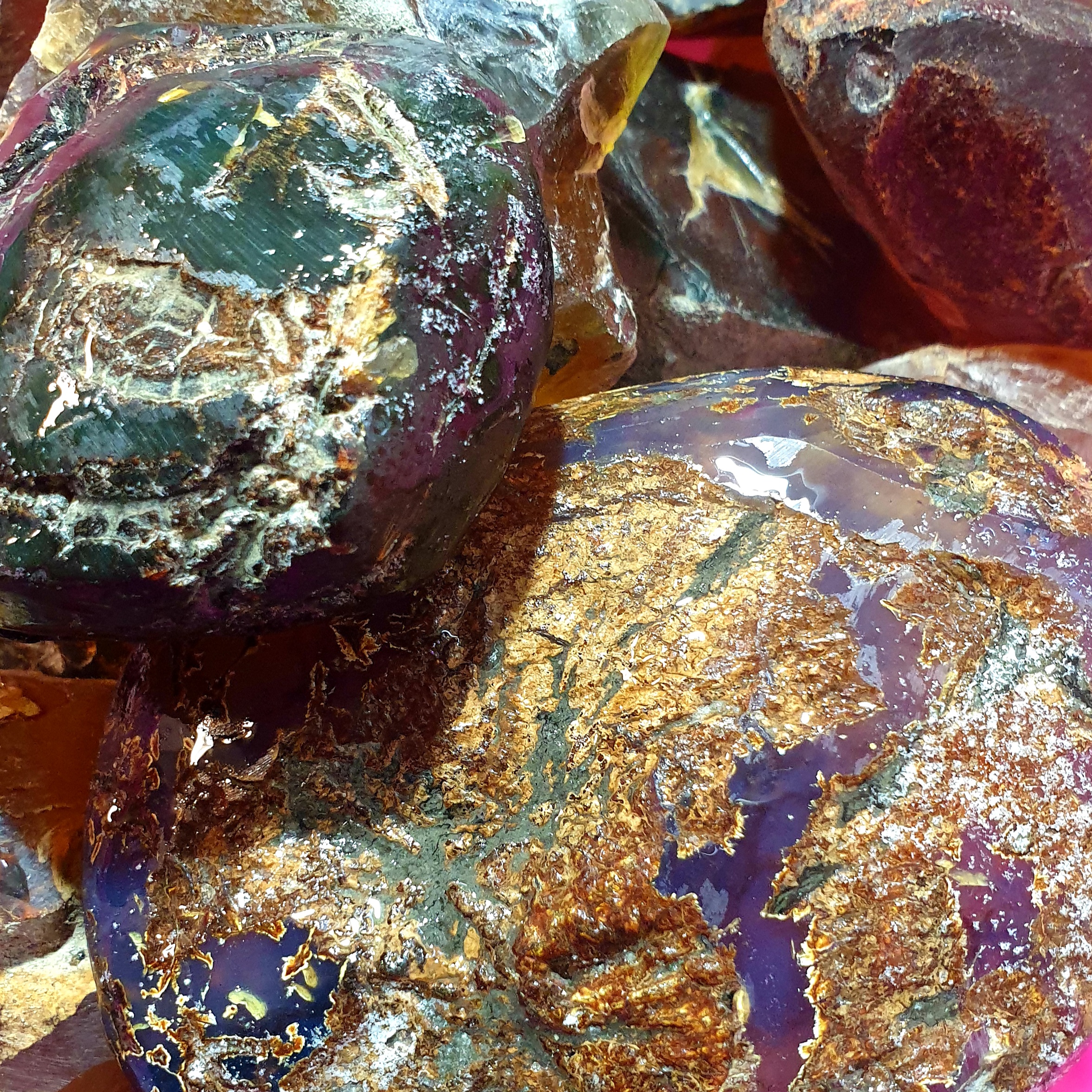
Photo: Raw green and blue amber from the Dominican Republic
In the 1960s, Dominican amber attracted mainly palaeontologists and scientists. Dominican amber has probably been the most widely found source of various fossils of insects, plants and other interesting inclusions, such as bird feathers, spider webs and bone fragments from 15 to 40 million years ago. The big boom in Dominican amber came after 1993, when Spielberg's Jurassic Park premiered. That's when prices skyrocketed, especially for amber with insect fossils.


Photo: Dominican amber preserves insect and plant species typical of tropical regions. Unlike the insects preserved in Baltic amber, the insects in Dominican amber tend to be relatively large.
Amber from Jurassic Park
Speaking of Jurassic Park, remember the opening scene? The one where the miners in the mine find a beautiful shining amber with a giant mosquito in the middle, with a nice big drop of dinosaur blood in its belly? Well, that scene was supposed to depict an amber mine in the Dominican Republic. A little stylized, and not exactly true to reality. Amber mines on this island look a little different. Even the raw amber underground doesn't look that clean. It's usually encased in a layer of clay, and a person who is not expert in amber would probably not be able to tell it from a regular rock at first glance. It takes experience. Only a small "window" is made in the stone, i.e. only a small area is polished through which you can see what the amber hides under the crust. You really need to have a lot of experience to be able to judge the quality of the stone, and its price accordingly...
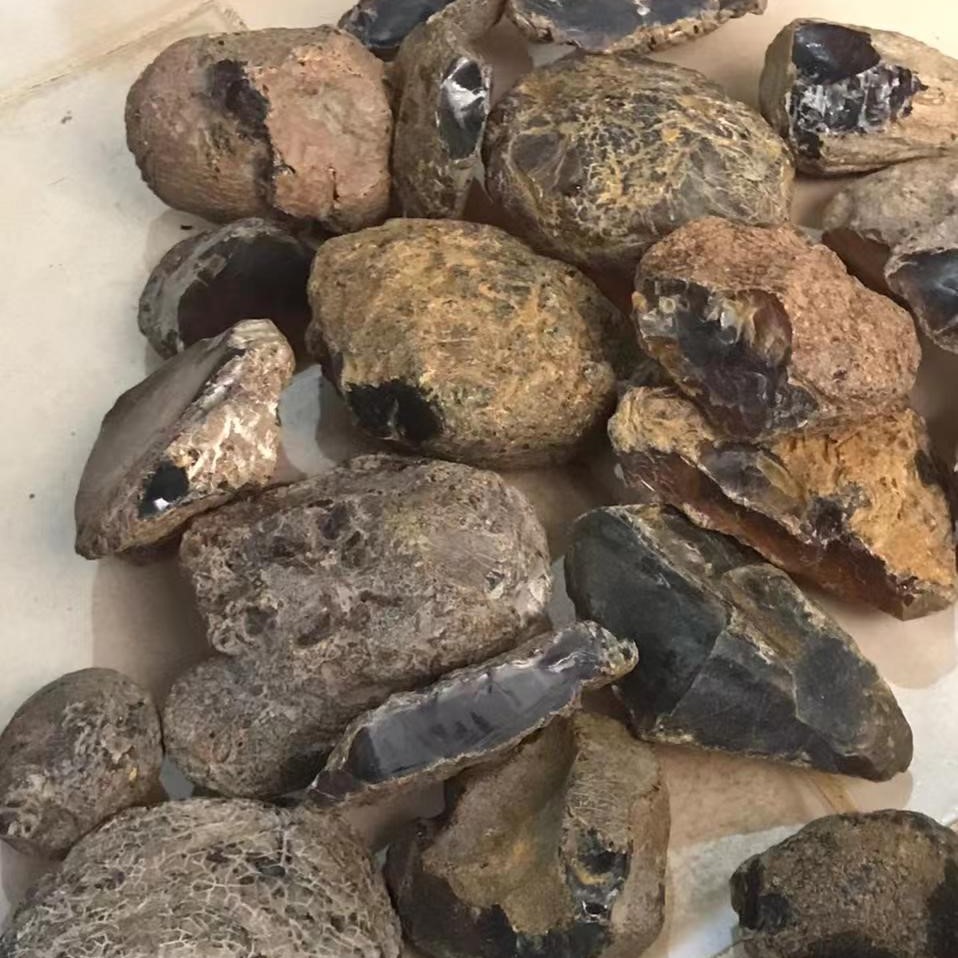
Photo: Unworked rough green amber from the Dominican Republic
How Dominican amber is mined
But let's get back to amber mining in the Caribbean. Due to the specific geographic and geological conditions, amber in the Dominican Republic can only be mined more or less by hand. No professional mining equipment or mining trucks. It is mined in so-called 'foxholes' over 300 metres long or in wells about 20 metres deep. One can hardly stand up in these holes. The humidity is high, up to 100%, and the only light is candlelight. (This is more out of habit than lack of resources. The workers who dig the amber earn a fair amount of money by local standards). In the rainy season, mining is dangerous and, in fact, impossible. These are just a few reasons why only a small amount of amber is mined in the Dominican Republic each year. It is estimated to be only about three ten thousandths of the total amount of amber mined in the world.
Amber deposits in the Dominican Republic
Amber in the Dominican Republic is found mainly in the northern parts of the island in the Cordillera, Cot ui and east of Sabana. The largest amber market can be found in Santiago, which is outside the tourist areas. Many people tell us, they never came across amber while on holiday in the Dominican republic. Different types of amber are found in different parts of the island. The most important deposits are found in the areas of Los Caballeros, Los Cacaos, Palo Quemado and Loma el Penon. Some of the deposits contain mainly amber with insect fossils, while elsewhere there is mainly classic yellow amber without the fluorescence typical of green or blue amber. Some deposits are known for brownish-red amber, while others are known for amber with green or blue fluorescence, the so-called green and blue amber.
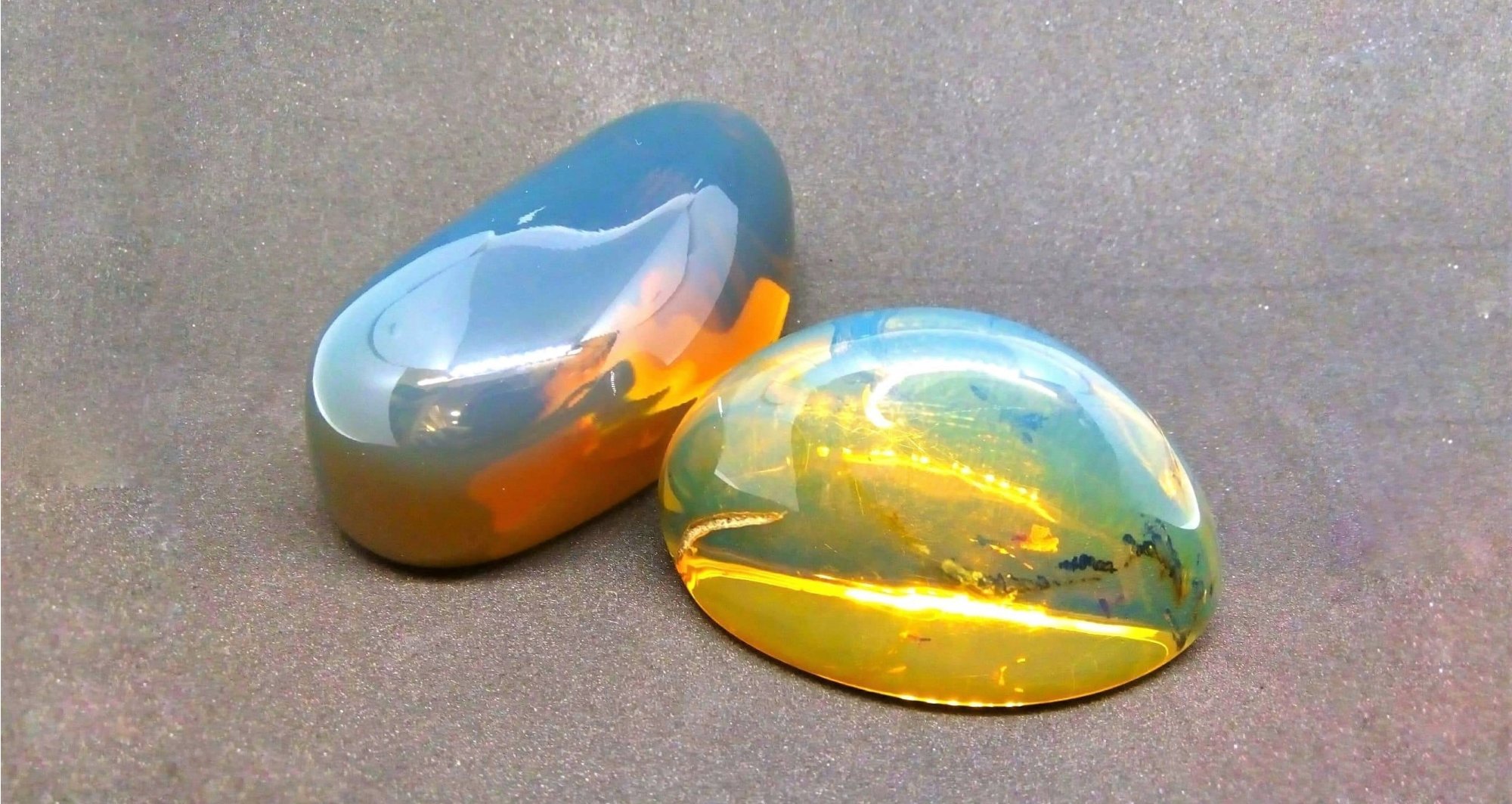
Metamorphosis of Dominican amber
Why is blue and green amber from the Caribbean called blue and green when it is actually yellow? No, it's not colour blindness. Nor is it a translation error. Dominican blue and green amber has earned its name rightfully. So what's the deal with it?
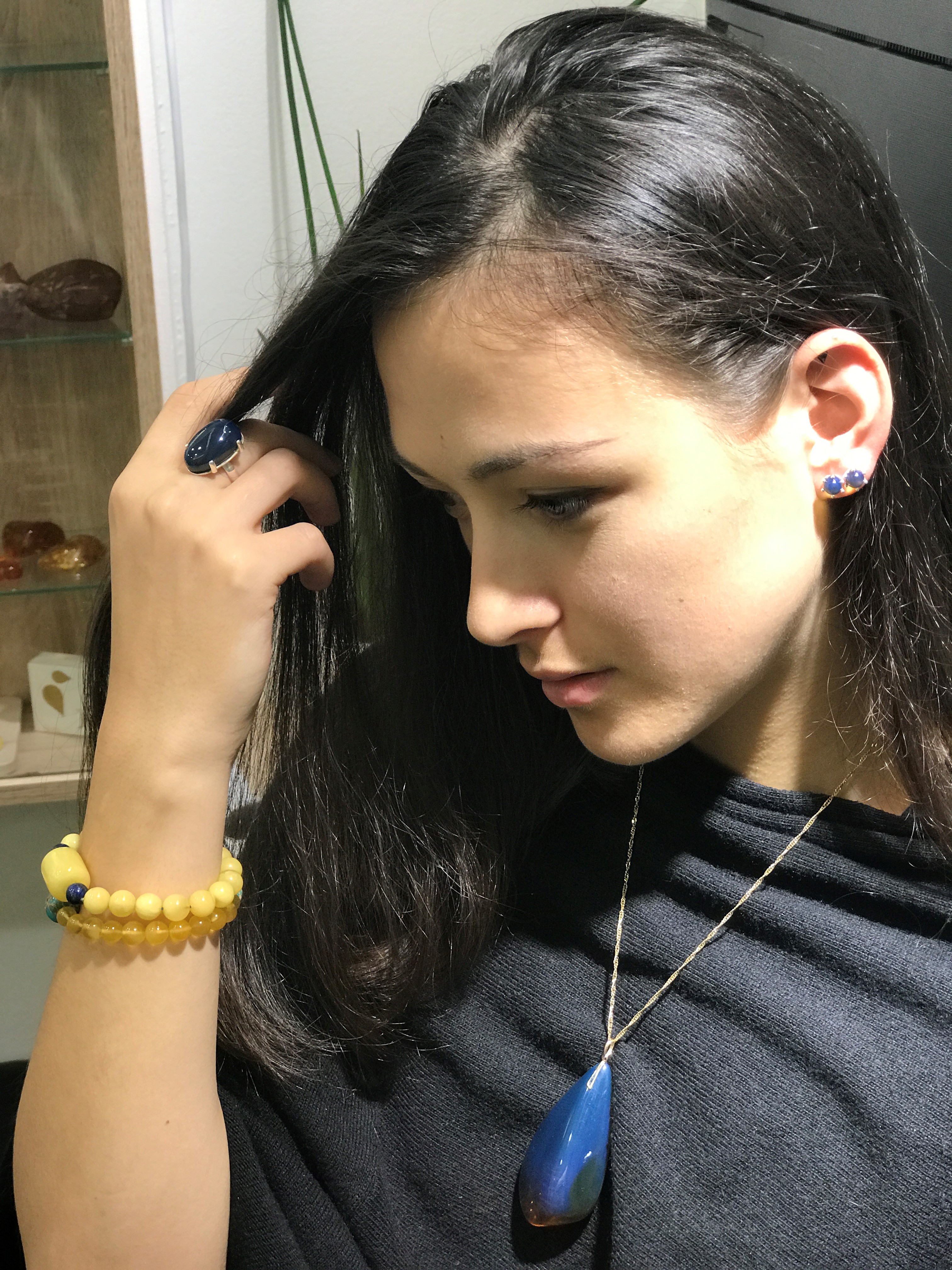
What is the origin of Dominican amber?
We could almost start like a fairy tale. Once upon a time, behind seven mountains and seven rivers, across distant seas and oceans, there was an island. Lush greenery, clear seas, tropical warmth... On this island strange trees grew. Their fruits looked like giant bean pods (maybe the fairy tale about Jack and the miracle bean is not entirely a fiction...). When the tree was attacked by a disease or injured, resin oozed out of the wound. And there was a lot of it! This substance coated the wound and healed the tree. When the tree later died, its resin was buried underground with it. In a few places, it didn't decompose as it normally does, but became petrified. There was no black magic or Medusa or anything like that. It was more like nature's alchemy. The right temperature, pressure, humidity, underground environment, etc.
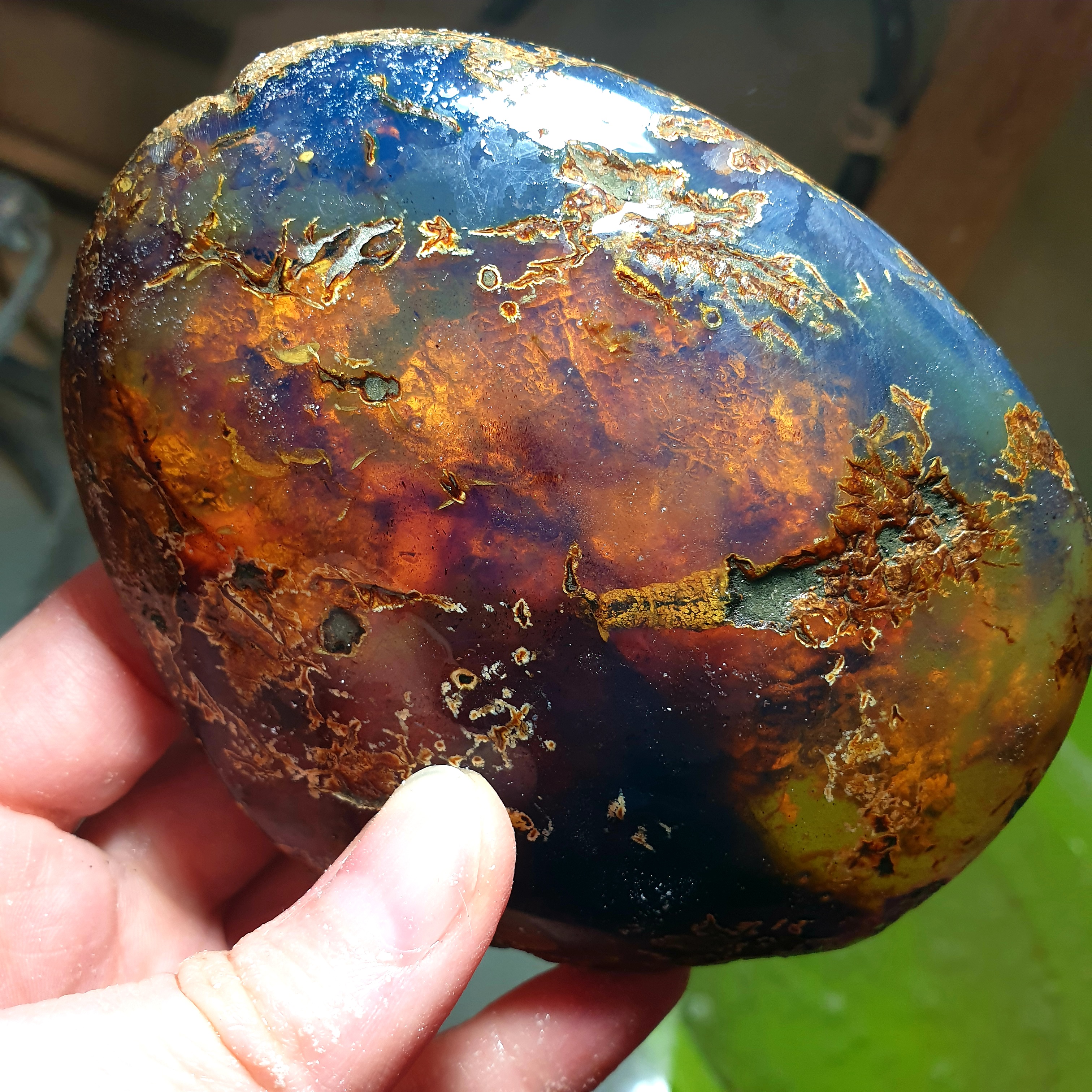
Photo: Rough blue amber from the Dominican Republic - this one has already had its bark grind off so that you can see what it contains and work with it further
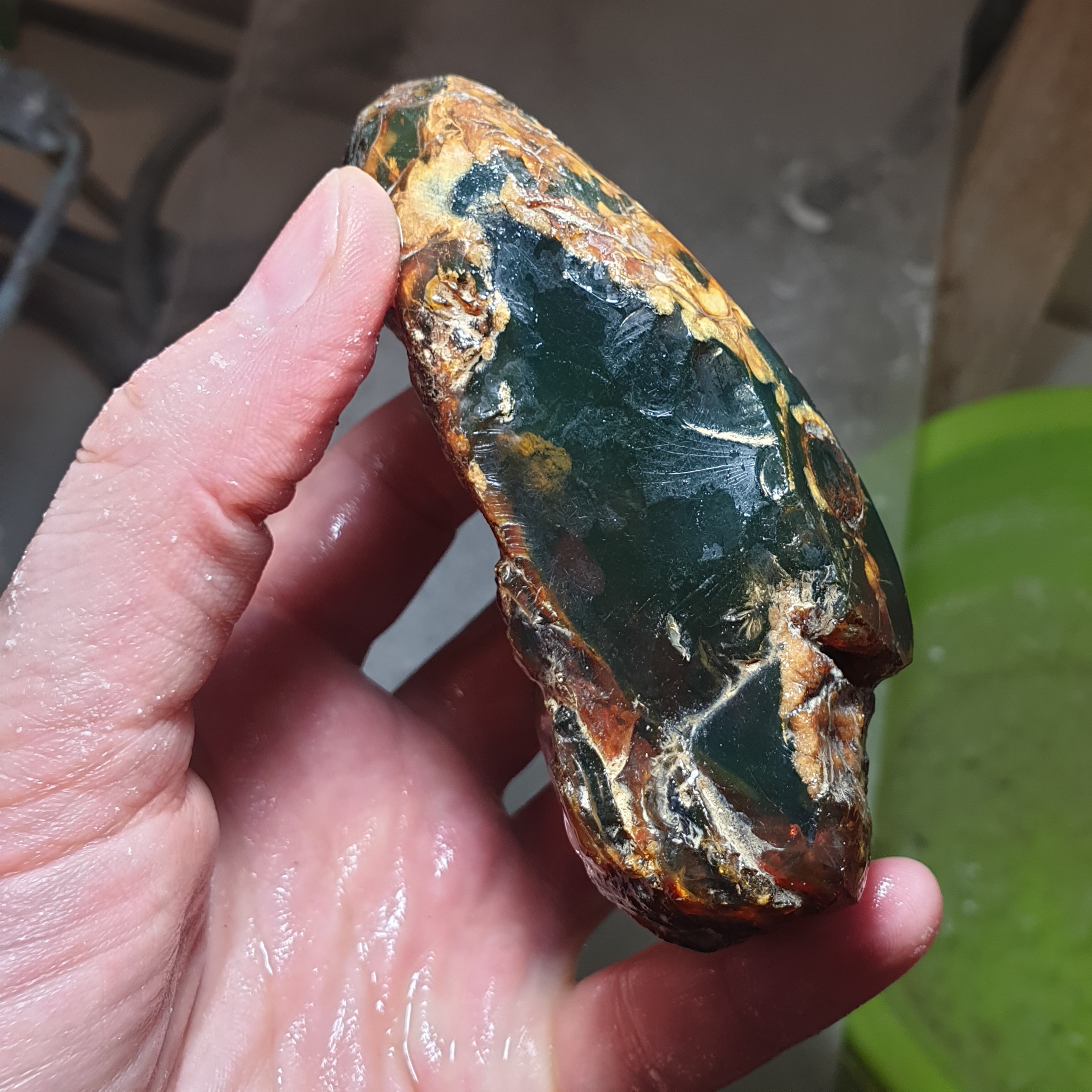
Photo: Raw green amber from the Dominican Republic
At that time, during the Oligocene and Miocene periods, the continents were slowly coming into their present position. As the Earth's plates shifted, it was common for an island to erupt into a volcano here and there. It spewed out lava, and where it flowed, it heated up. It didn't even leave the fossilised resin underground alone. It melted, but as the ground cooled, it turned back to stone. Another time, in another place, it happened that a fire burned the whole forest. Such a fire did not completely melt the amber underground, it was no match for the heat of the lava. However the amber underground warmed up and softened anyway. Then it fossilised again. And that's how the miracle happened. The heat, and who knows what else, awakened a mysterious power within it. (To make it sound more technical, it activated photosensitive substances.) Then the amber matured in the ground for tens of millions of years until it was discovered by humans. And because humans have always liked all kinds of coloured stones, glitter and jingles, they began to cut and polish these stones. What didn't happen! When they looked through it, the amber was yellow. Or maybe it was brown or reddish-brown. But when they put it on a dark surface and the sun shone on it, it suddenly changed colour. Some of the stones turned blue, others turned green. It seemed as if the stone changed completely. It was as if suddenly it wasn't transparent at all. From different angles, it looked a little different, but always had the same magical look.
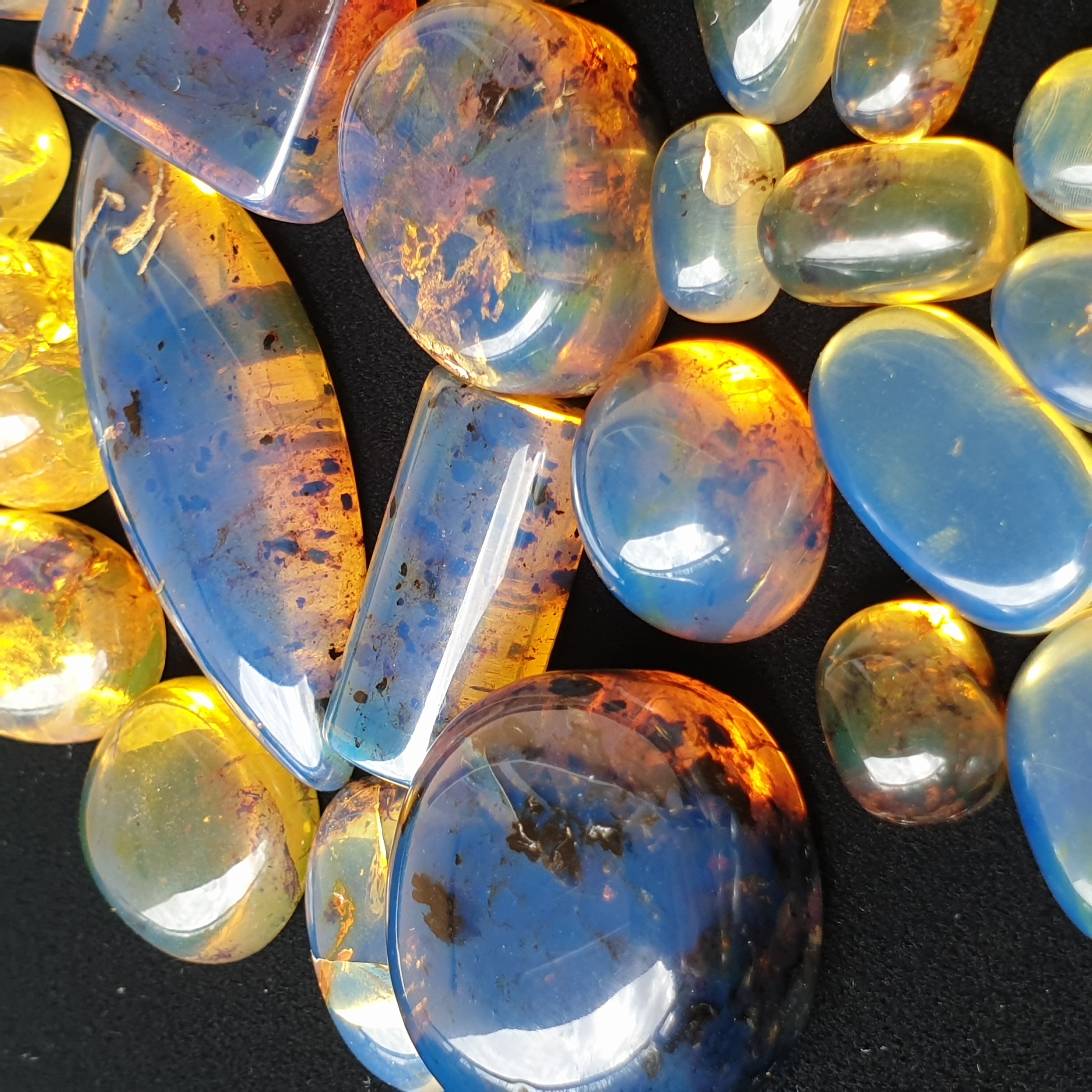
Photo: For Dominican amber to change colour, it has to be polished, otherwise the reflection of the light rays will not be sufficient.
Why does Dominican amber change colour
I guess this is where our tale ends. Yes, we were talking about Hispaniola, the second largest island in the Caribbean Sea, which today is home to the Dominican Republic and its green and blue amber. To this day, scientists are still trying to find out what process caused its special optical properties. Melting by volcanic activity in blue amber or forest fire in green amber is just one theory. But what we do know is that green and blue Dominican amber contain photosensitive substances. Some scientists believe these are aromatic hydrocarbon compounds. These are activated when ultraviolet light hits the surface of amber, causing a phenomenon known as fluorescence. This means that amber reflects this ultraviolet light. This occurs at the surface of the amber or slightly below the surface if it is thick enough. The ultraviolet light rays do not penetrate through. The original colour of the amber does not change, but it turns blue (in the case of blue amber) or green (in the case of green amber) on the surface. Therefore, it will look as if the originally transparent amber has suddenly ceased to be transparent. When the amber is thick enough, this ultraviolet light can penetrate a little more deeply. This is best seen against a black background. The black colour does not reflect the light rays, so it enhances the fluorescence.

Photo: AAA-quality Dominican blue amber pendant on a white and black background - photographed under a spotlight daylight colour.
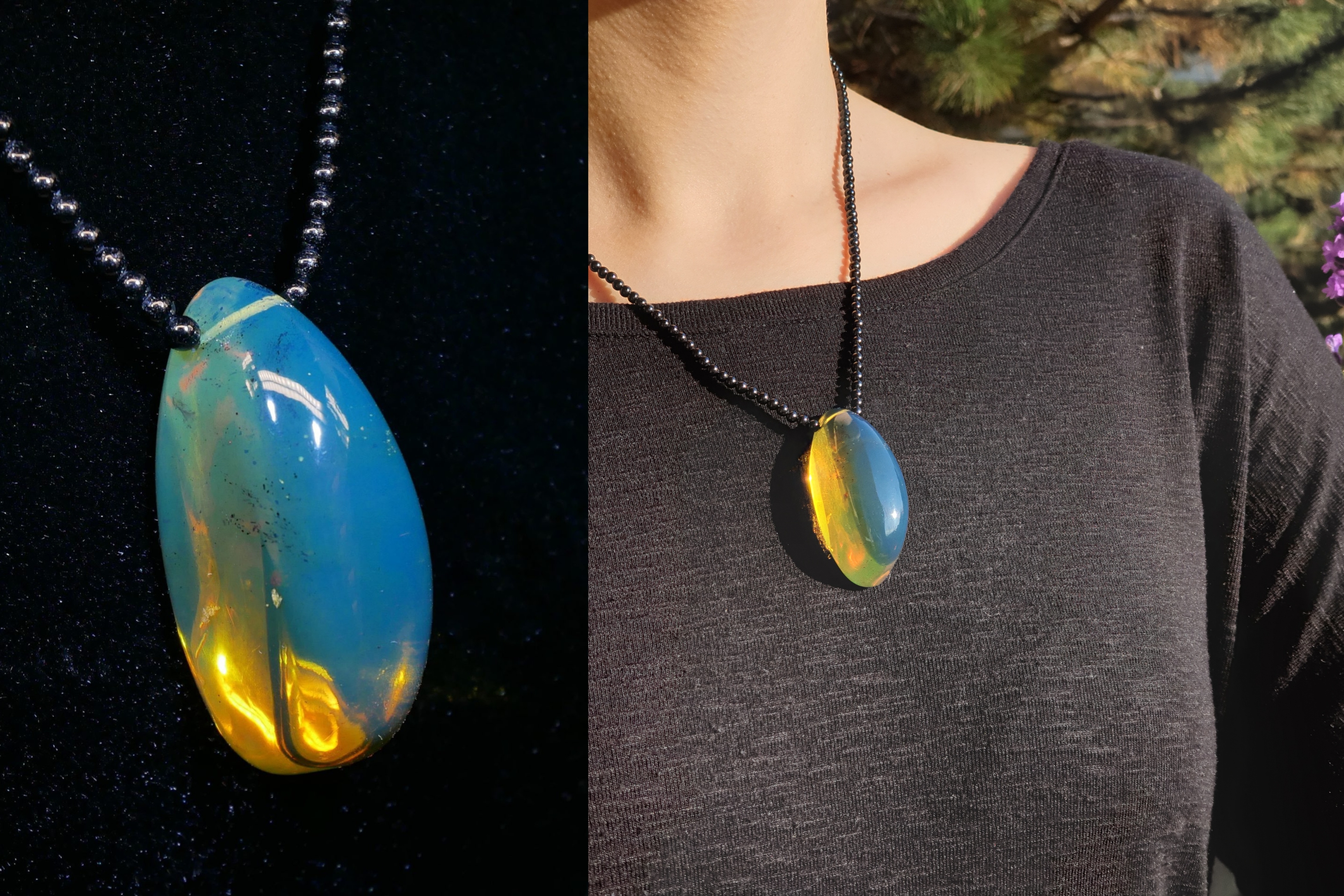
Photo: Dominican blue amber pendant photographed under a spot LED daylight light on the left side and under direct sunlight.
It is very rare to find pieces among Dominican amber whose body is greenish or reddish-purple even against a white background. However, even in this case, the fluorescence will show in sunlight and against a black background. If you get your hands on an amber that is bright green or blue even on a white background, and it is still the same shade of green or blue all the time, then it will probably be an imitation of amber or at best, dyed amber. Natural amber changes its colour in different light conditions.
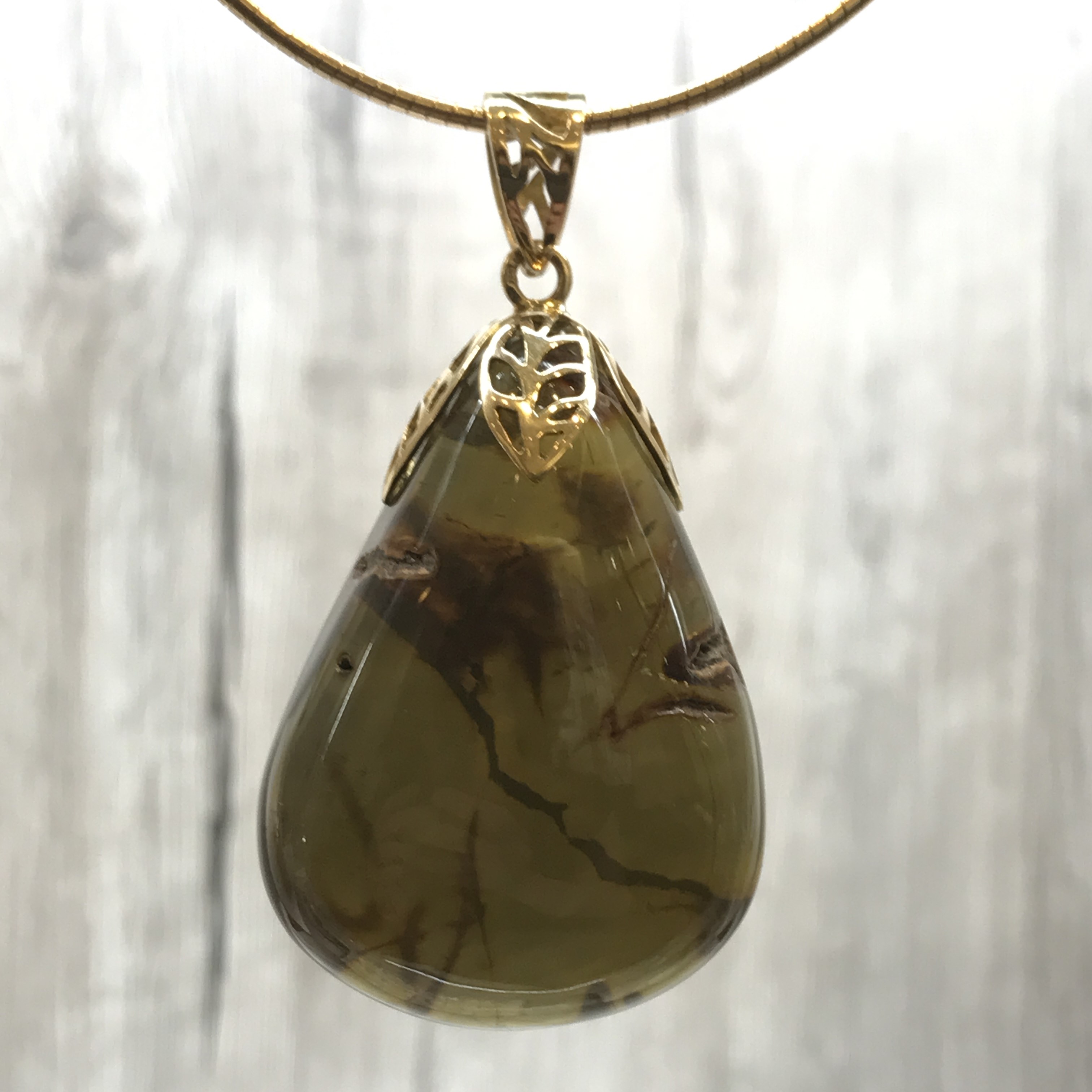
Photo: This pendant was made of Dominican green amber, whose primary colour was swamp green. Pieces like this are very rare.
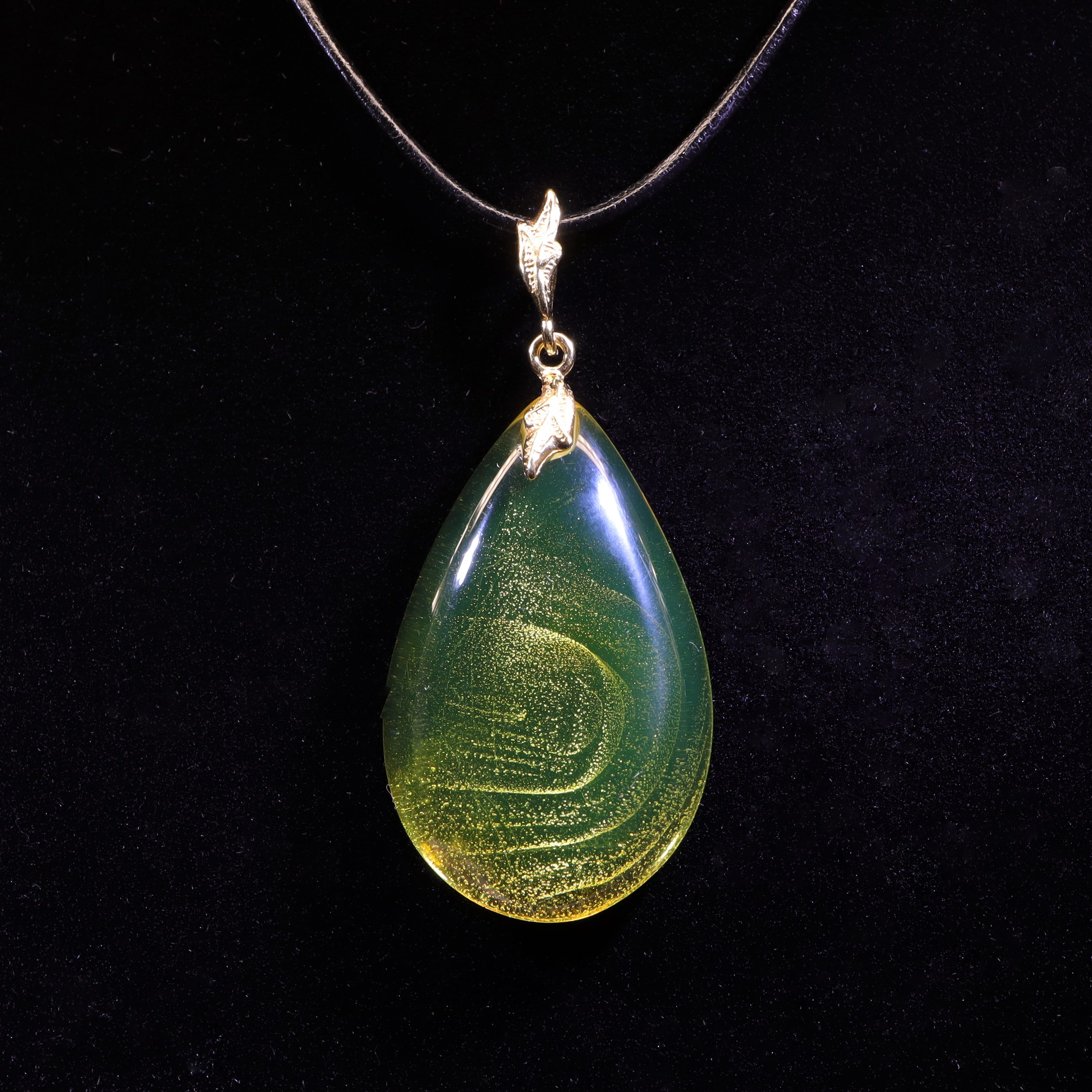
Photo: Dominican green amber, like Baltic amber, will form tiny bubbles under certain conditions. When intense light hits them, they light up like golden sand. In addition, they reveal the flow of the tree resin. It's like a secret message that only reveals itself at certain moments.
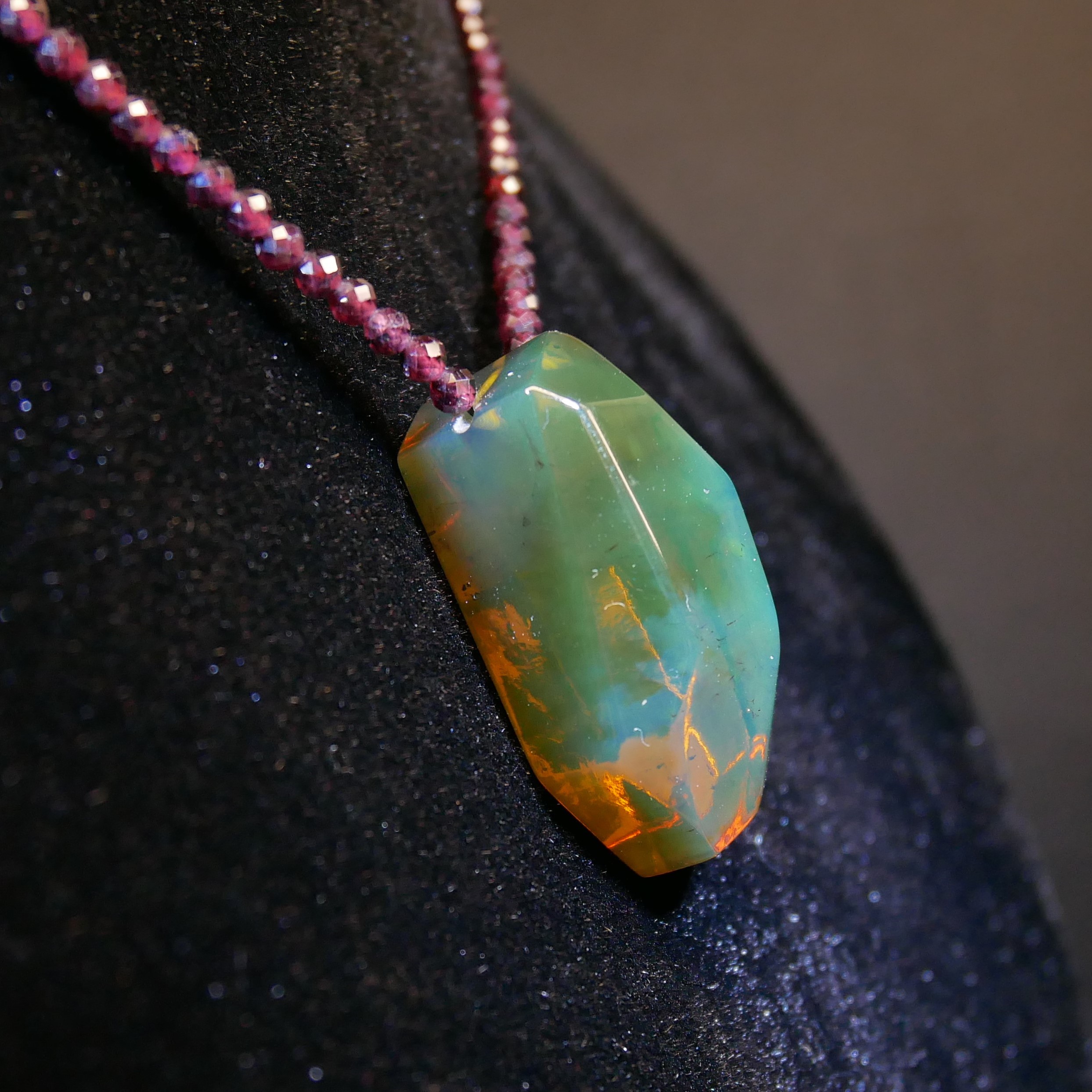
Photo: Dominican blue-green amber
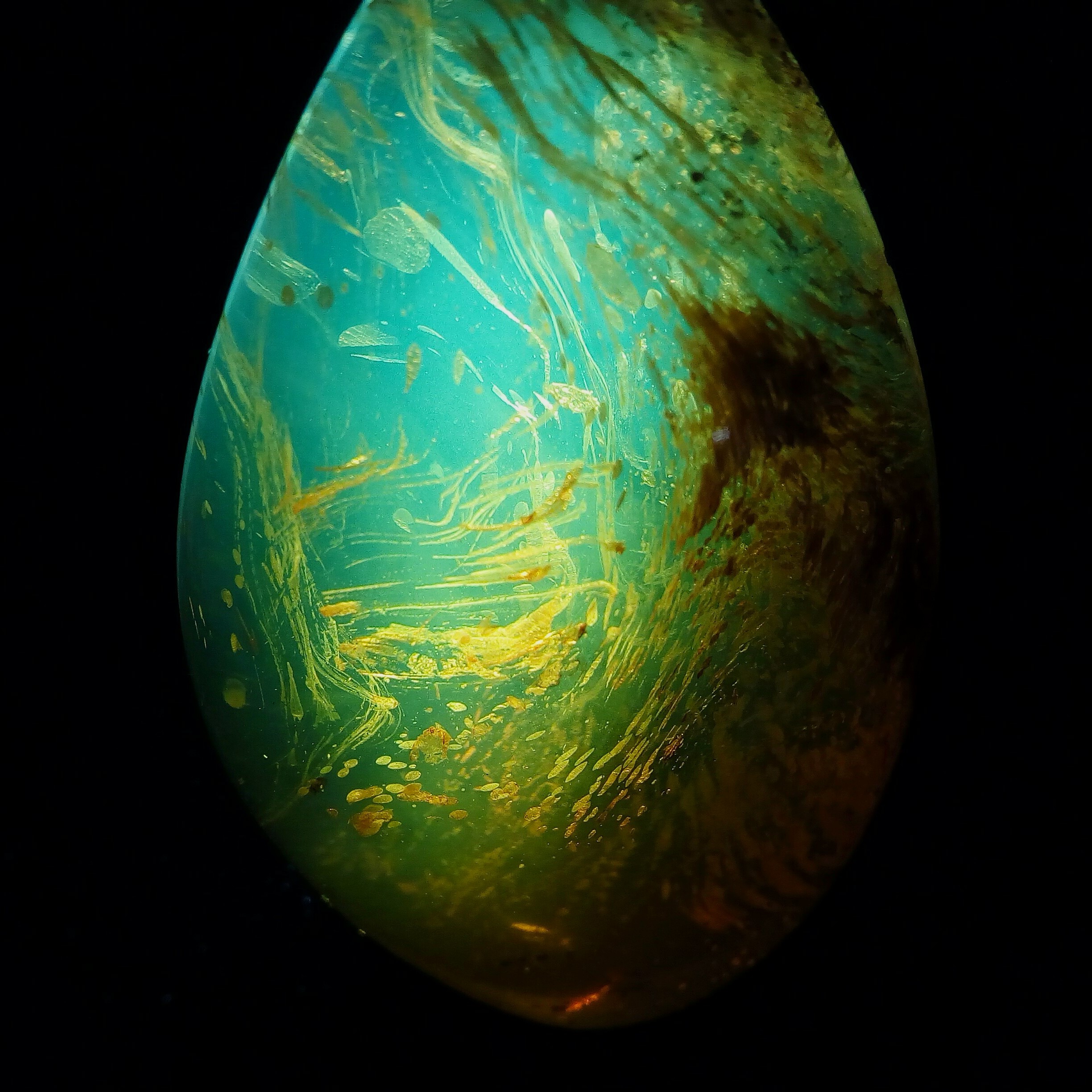
Photo: This blue amber containes inclusions of organic origin, probably pollen from a plant.
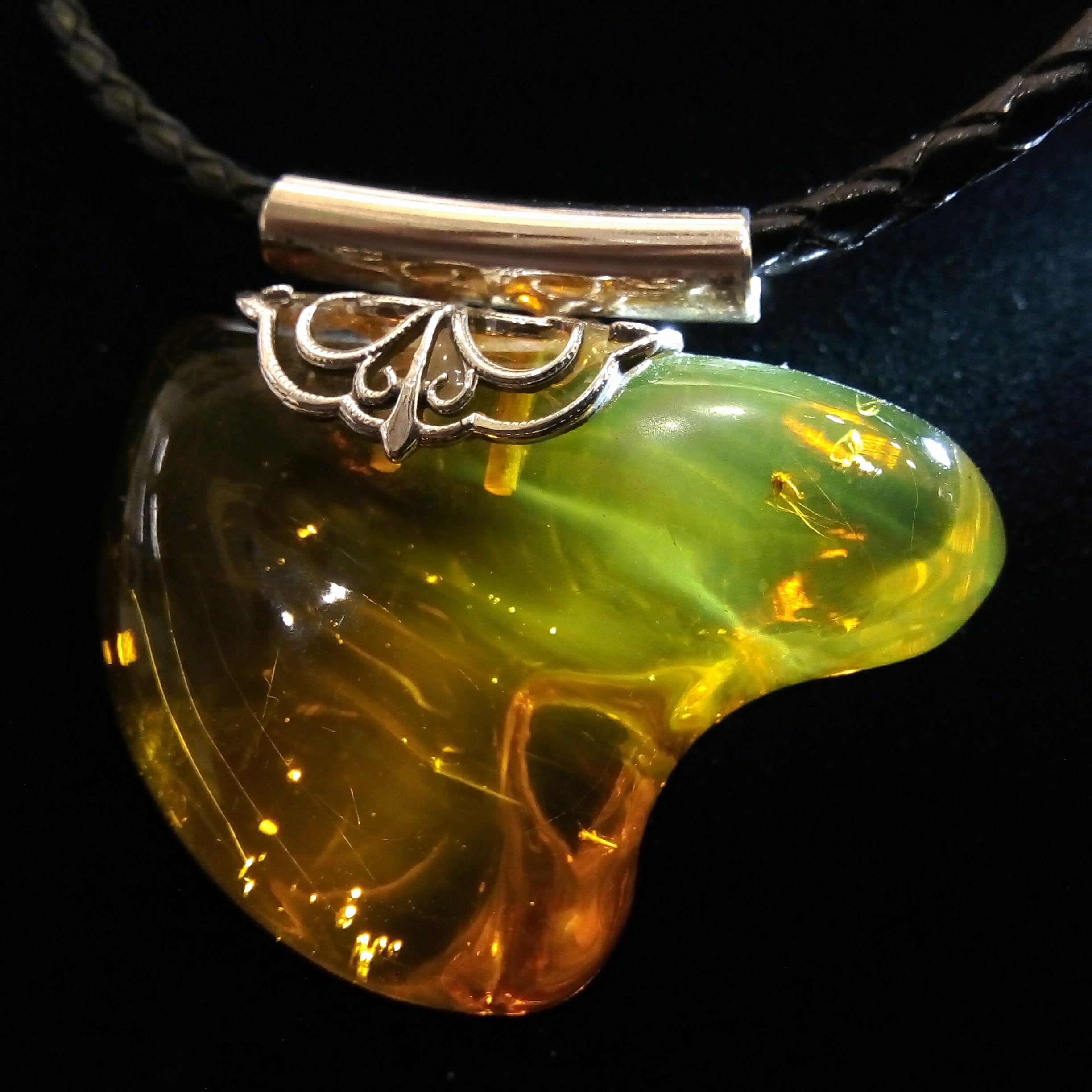
Photo: A small fly was preserved in this Dominican green amber pendant. Various insects are found relatively more frequently in green amber.
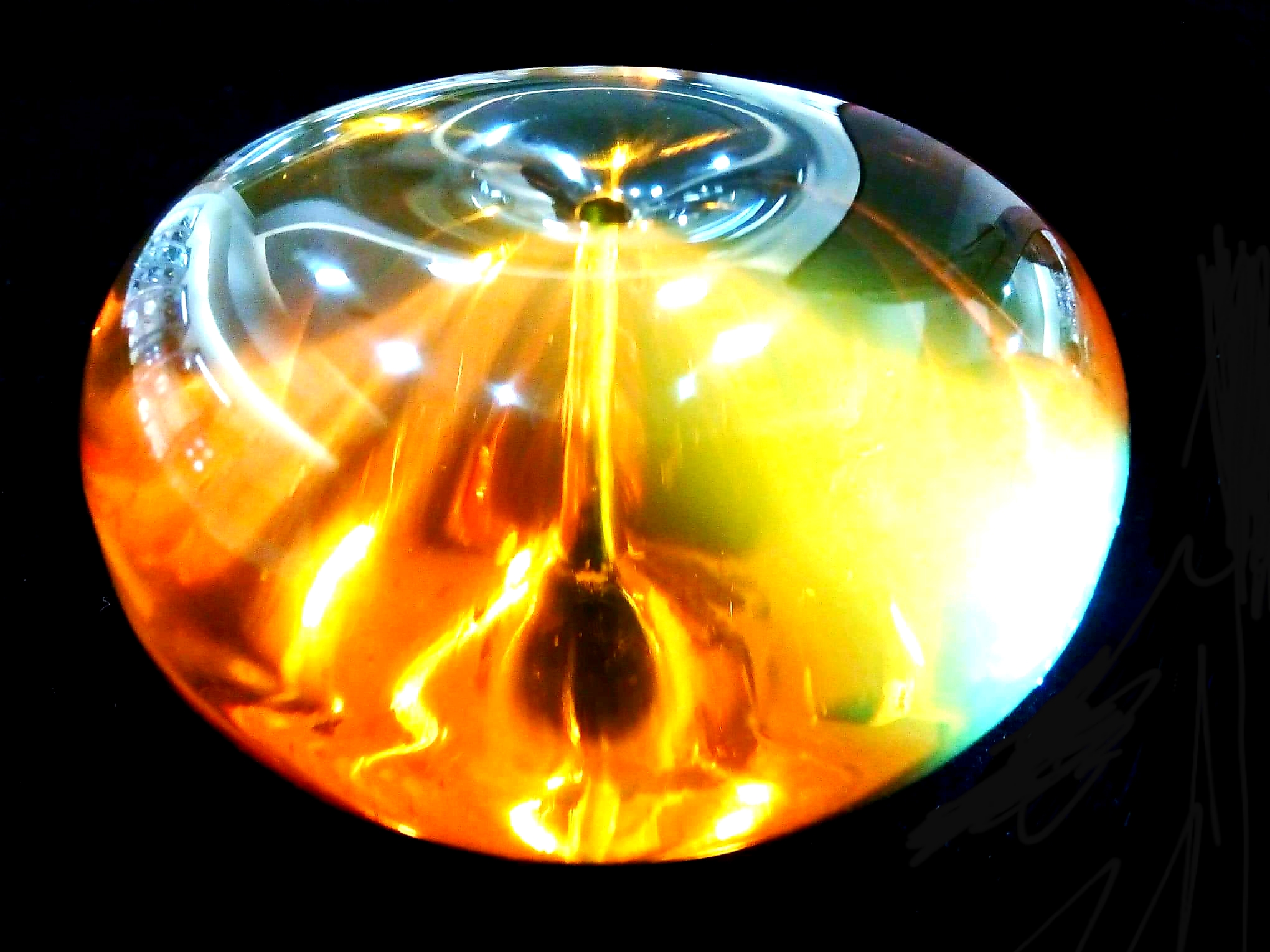
Photo: Amber likes to play with light, especially when cut into a donut shape.
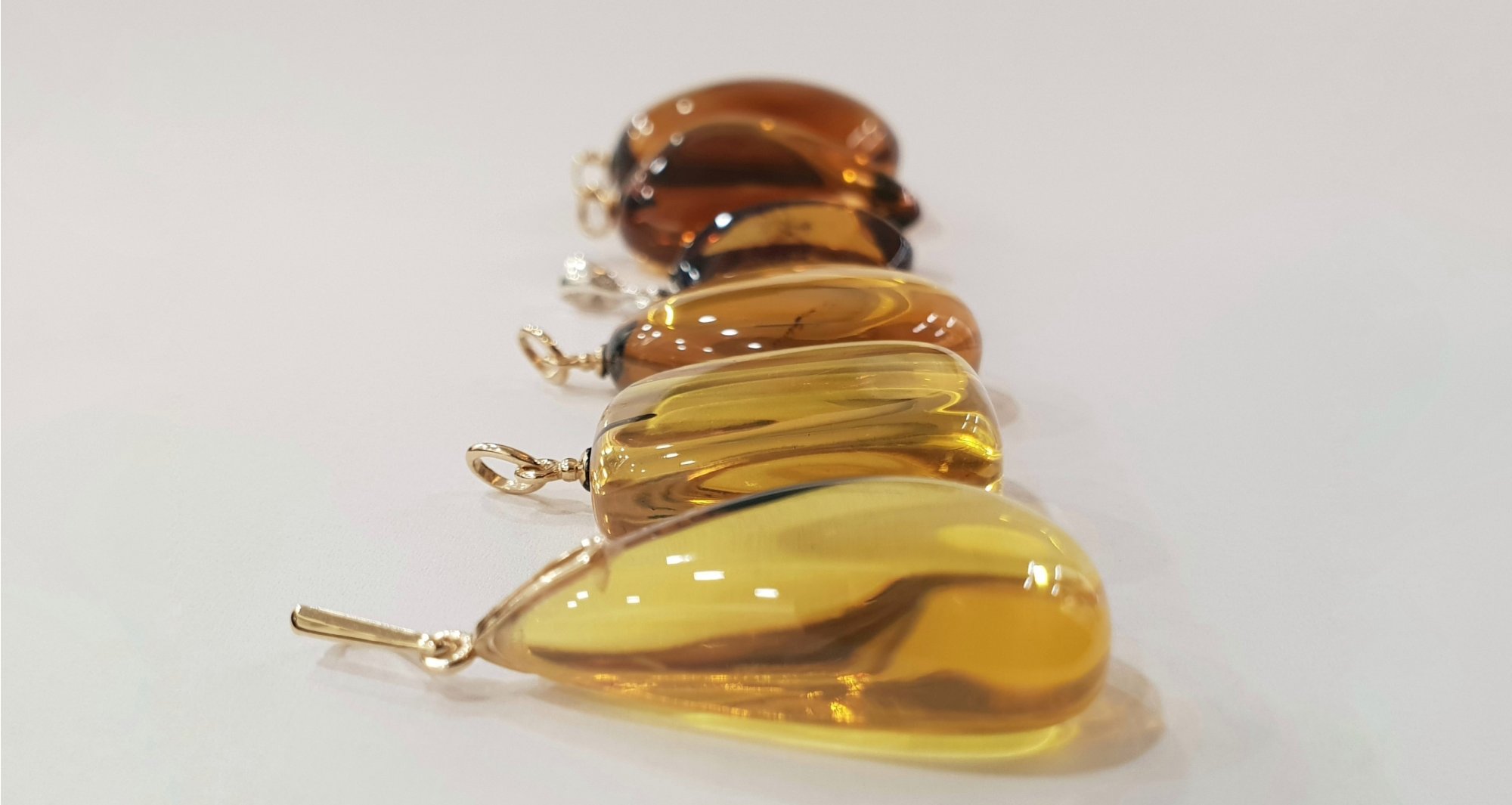
Among the most diverse colours in the world, we also often talk about “amber colour”. However, what is it really like? Yes, of course, you probably immediately think of that cognac colour, bright brown or dark honey yellow. But when we attribute just this one shade to amber, we do it a disservice. The cognac colour is only a tiny fraction of all the colours and shades that appear in the world of amber. Its world is very varied. In addition to the location and conditions under which amber fossilised, the type of tree from whose resin amber was formed contributes to the wide range of colours.
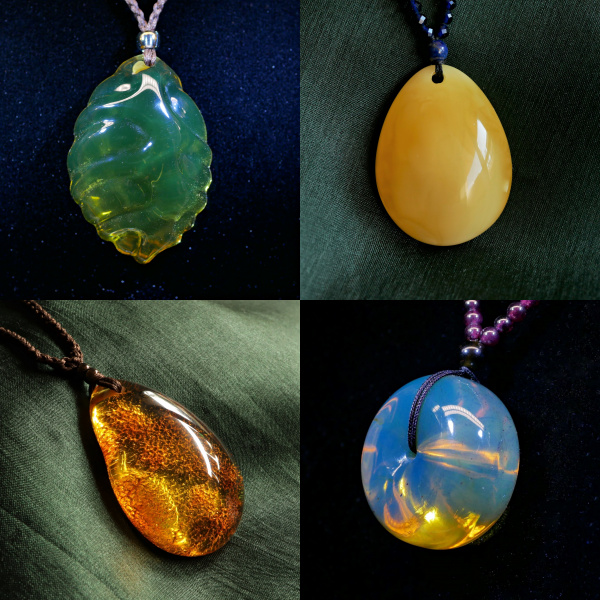
Photo: Natural amber can also be green, blue or reddish. In addition, amber likes to play with light. Dominican will turn green or blue. If you don't sand the bark of transparent Baltic amber, it will remain a rusty red colour, which is the colour of the bark of raw amber.
Where can we find amber
Baltic amber is the most famous of its kind, and it has the longest history of use in the jewellery industry. However, it is by no means the only one of its kind. Amber formed in many places on our beautiful planet. Apart from the Baltics, other major deposits are or have been found, for example, in Sicily, Romania, Germany and Ukraine, and outside Europe also in Burma, Sumatra, Madagascar, Mexico and the Dominican Republic. Even in the Czech Republic, amber has been found near the village of Valchov. It was named Valchovit after its location. Amber from different localities is characterised by its different appearance. Sometimes it is possible to tell at a glance where a piece comes from. Baltic and Dominican amber are the most suitable for jewellery making. When polished, it has a high lustre and high light refractive index.
Photo: Transparent amber of the highest quality looks like a petrified drop of oil. You don't even have to be an expert to know right away that it is a gem. Of course, the polishing process is also very important. This is the know-how that every workshop guards.
Origin and forms of Baltic amber
Baltic amber, also called succinite, comes from various species of the now extinct conifer Pinus succinifera trees. There are estimated to be up to around 350 species of conifer. Baltic amber has the highest proportion of succinic acid of all the species. It accounts for up to 8 % of its total weight. The richest deposits are estimated to be in the Kaliningrad region, as well as in northern Poland, Lithuania and along the Baltic coast. Its age is estimated at approximately 28 to 54 million years. It is older than the Baltic Sea itself. Under a yellow-brown layer of oxidised crust Baltic amber tends to be transparent, semi-transparent or completely opaque, called milky. It offers a wide range of colours, from snow-white to beige, lemon yellow, honey, orange, reddish and brown. The Polish scientist Adam Chetnik, in his Little Dictionary of Amber Varieties, defined around 200 variations. However, the variety of colours and forms of this organic gemstone does not end there. Nature has really played with amber and "painted" thousands of beautiful, most original designs in it. It could easily be exhibited in the Louvre alongside the world's most famous painters.
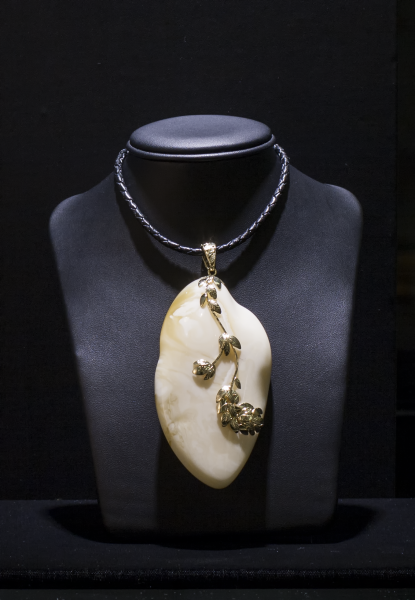
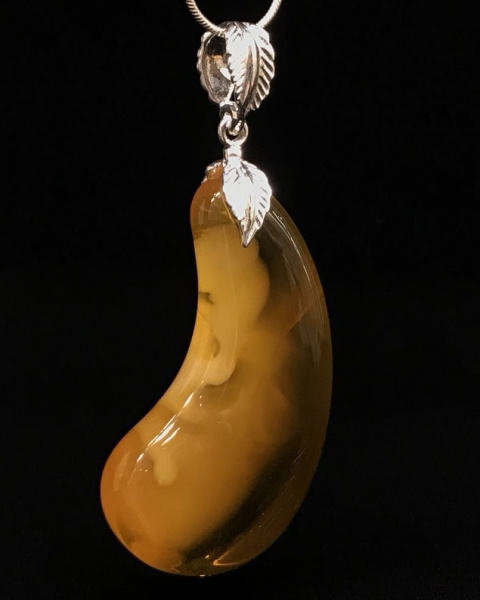
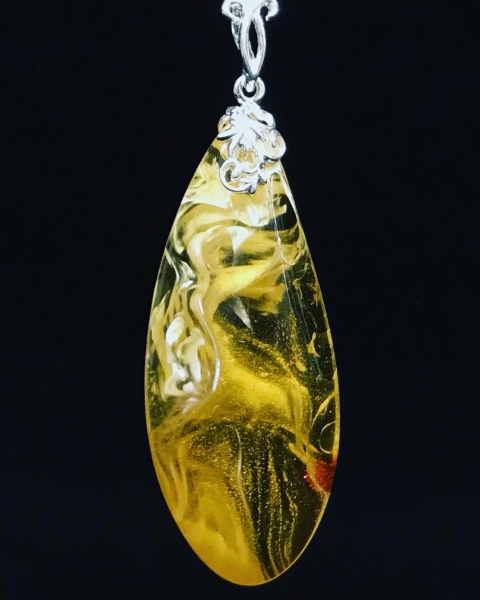
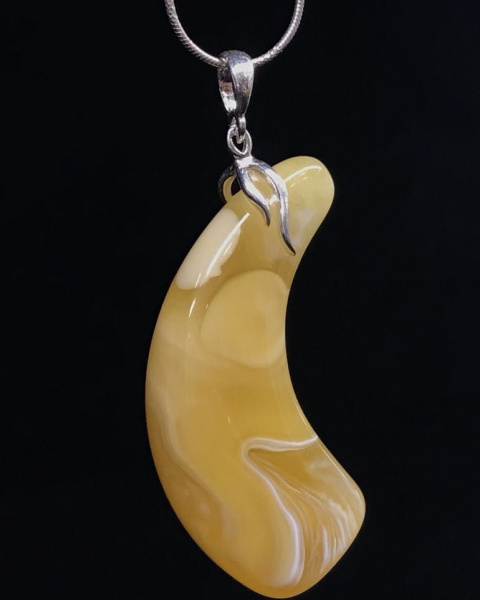
Photo: This is just a small fraction of the variety of forms and patterns found in Baltic amber.
In Baltic amber we often encounter an opaque form. In the course of fossilisation, microscopic bubbles formed in the amber under very specific conditions, i.e. under certain temperature, humidity, pressure, etc. The more bubbles, the more opaque the amber became. The largest number of microscopic bubbles are in white amber. It is estimated that there are up to 900,000 bubbles per 1 mm3. By comparison, yellow opaque amber has only 25,000 bubbles per 1 mm3.
Photo: This process can be seen beautifully in this pendant, for example. At the bottom, the amber is white, completely opaque. In the upper half, you can see tiny bubbles that somehow "cloud" its transparency.
Special features of amber from the Dominican Republic
Dominican amber comes from a tree - the legume Hymenea protera, which is now extinct. Today, similar species of this tree, such as the Hymenea courbaril, grow in South America or Africa. This one also secretes a lot of resin, but we certainly will not get amber from it... At least not for the next few tens of millions of years. Dominican amber is a very rare species. It's specific in colour and optical properties. It reflects green and blue waves of the light spectrum, so it turns green or blue on a black background. However, the colour of amber itself is yellow. More specifically, it ranges over a very wide palette, from pale yellow to orange and reddish brown. Very, very rarely indeed, does blood red amber appear. We have had one single piece of blood red amber in all the time we have been working with amber. It originated from the Dominican Republic and it was really beautiful. Blue amber is also very rare. It's also known as the "king of amber". At its highest quality, its price is comparable to that of the finest natural diamonds.
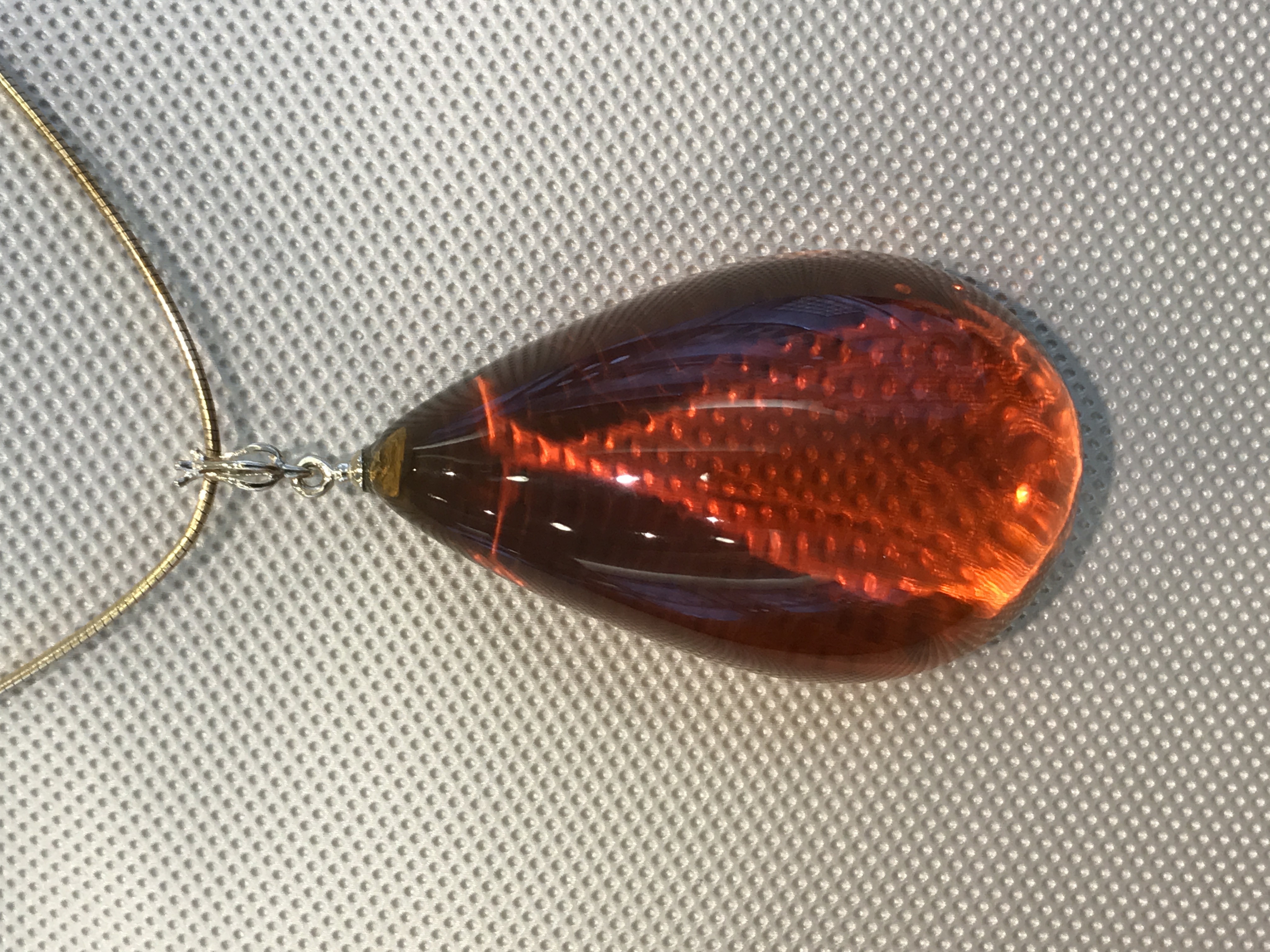
Photo: The blood red amber, I didn't even manage to take a picture. It was so beautiful that the first customers who saw it bought it. I still remember them to this day and I'm glad it got into the hands of nice people. This piece you see in the photo already has a subtle tea shade. But it was beautiful too.
Photo: Dominican blue amber of AAA quality, so called sky blue. The colour of the amber itself is light yellow, it has a high lustre and the faceted cut looks beautiful.
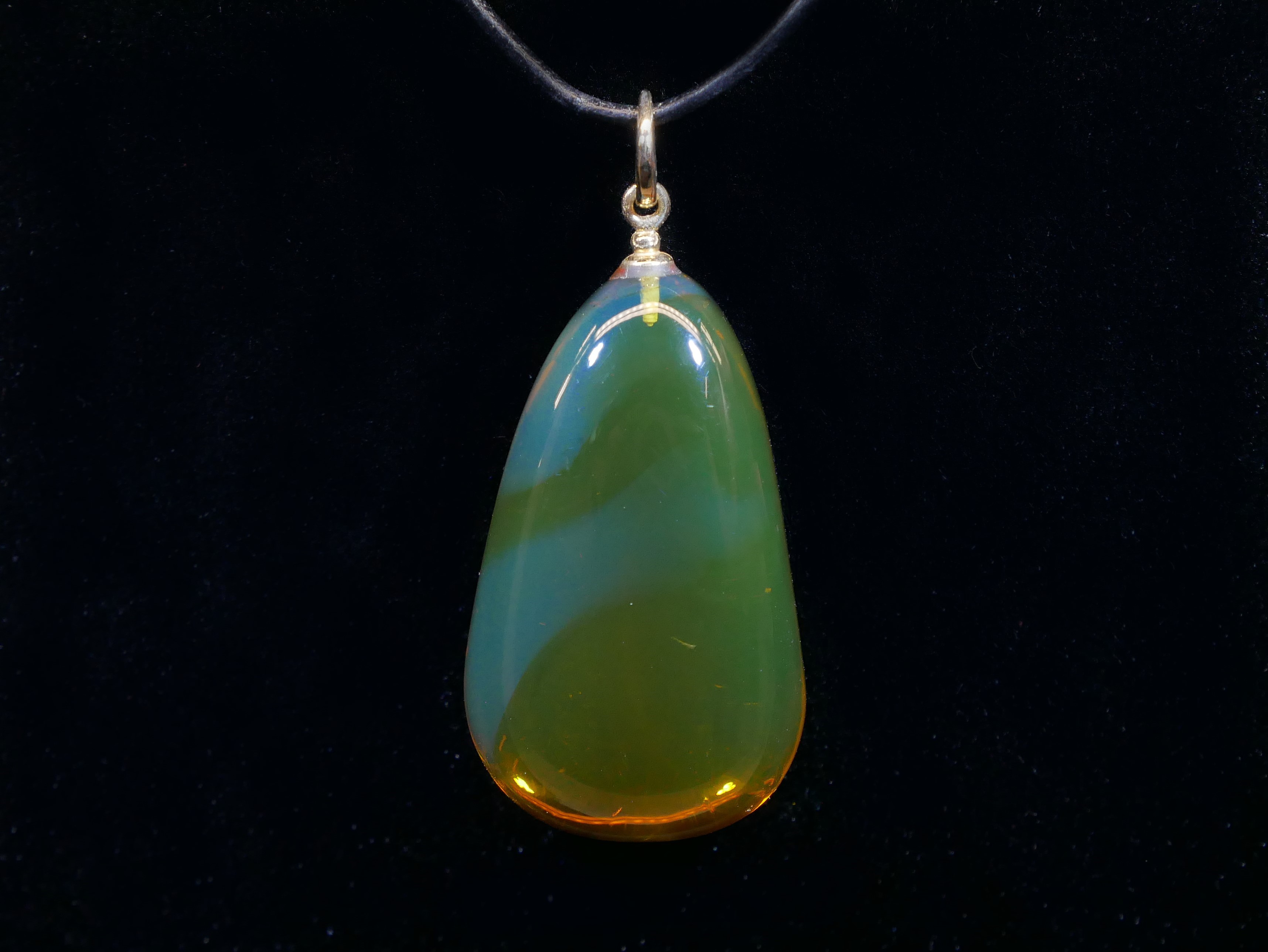
Photo: Green-blue Dominican amber is also relatively rare.
Photo: Green amber likes to play with light. Under intense light, the flow of fossilised resin is revealed.
Amber is an altogether beautiful gemstone. And mysterious. It has a soul that can speak to people. All you have to do is listen carefully.

